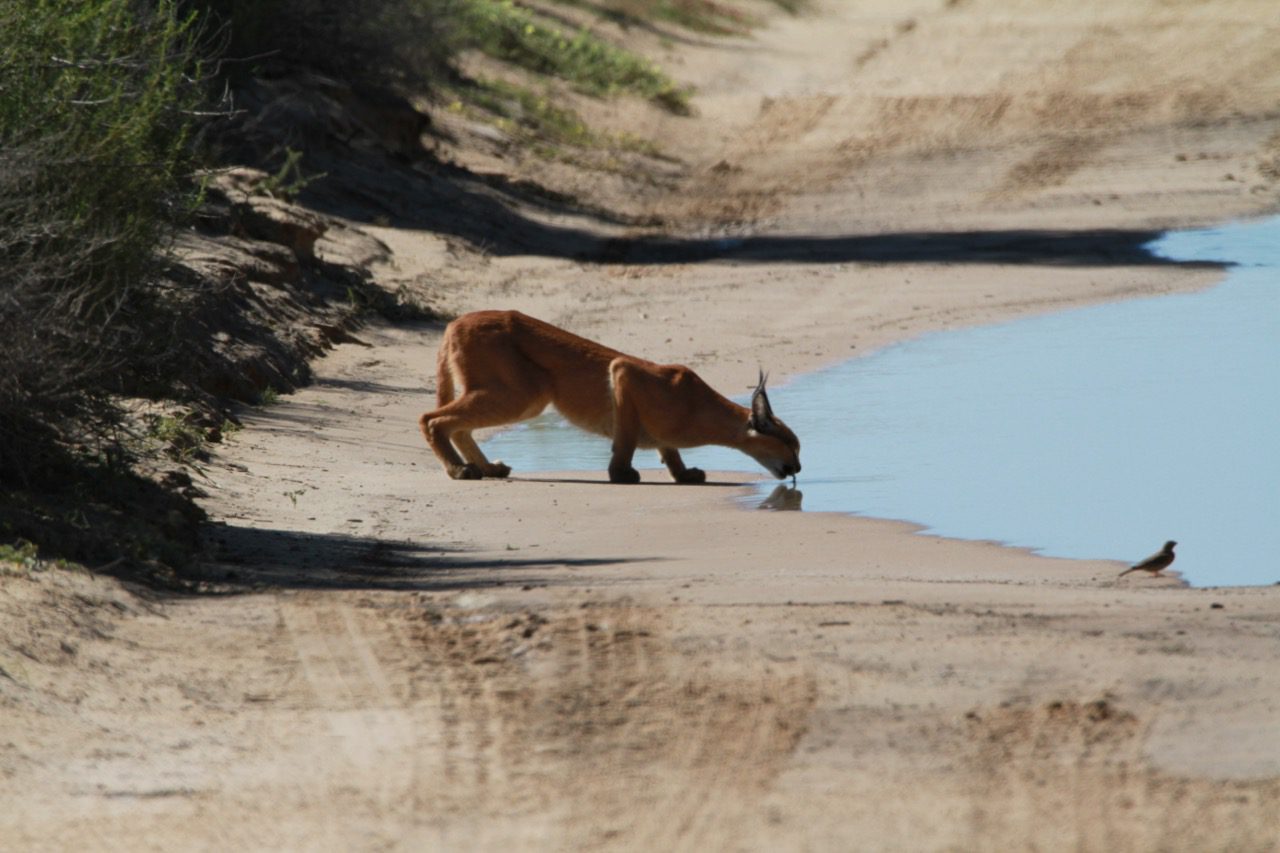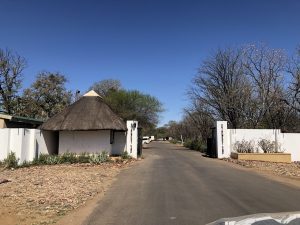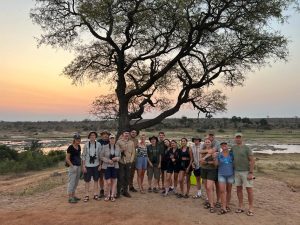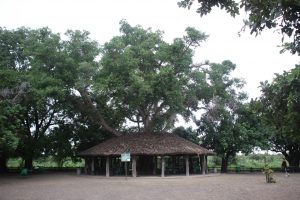🙂 First trip ever to Kgalagadi!! First (and only!) ever sighting of CARACAL!!!!
🙁 Addicted to that red sand!
Hoorah!! The day has finally arrived…equipment packed (more paraphernalia than clothes!!) – Tick; Twin Cab Bakkie Car Hire sorted – tick; Grocery shopping (including Easter Eggs; Ghost Pops, Nik Naks, biltong and LOTS of steak and Fat Bastard Shiraz ) ordered at Upington and Phalaborwa – Tick…Children (OK – grown up children!) ready and packed – tick! Our wishlist for Kgalagadi: Those beautiful black maned lions!; Cheetah; Meerkats; Bat Eared Foxes; Black Backed Jackals; Honeybadgers; Brown Hyenas etc etc! ….
After a comfortable flight on board a brand new Virgin 787 plane (and too many good movies to mention) we arrived in Jhb a little bit tired but full of excitement and anticipation! Next stop Upington to collect our Twin Cab 4×4 Bakkie and on to meet Jeremie, the hugely helpful Manager at at Pick ‘n Pay who had already arranged to have all our groceries packed and ready to collect plus he was so kind as to give us his own personal supply of cooler boxes in which to store meat and perishables. What a lovely gentleman. We then took the mostly dead straight R360 road for 250Kms – everything was going well – we noticed the signs ‘Caution Aardvark’; ‘Caution Bat Eared Fox’; ‘Caution Owls’; ‘Caution tortoises’ – so we started to keep a lookout for them and were duly rewarded: we had to swerve for a few tortoises on the road, saw several bat eared foxes foraging on the side of the road, spotted a genet and two owls (sadly no aardvark!) – and we had not even reached KTP yet!
On the final stretch we were bathed in the spectacular orange hues of the sunset to the right but as the sky darkened we were blown away by the almost full moon rising on the left … then the air suddenly smelt thick with water and the heavens opened so that we could scarcely see the road!
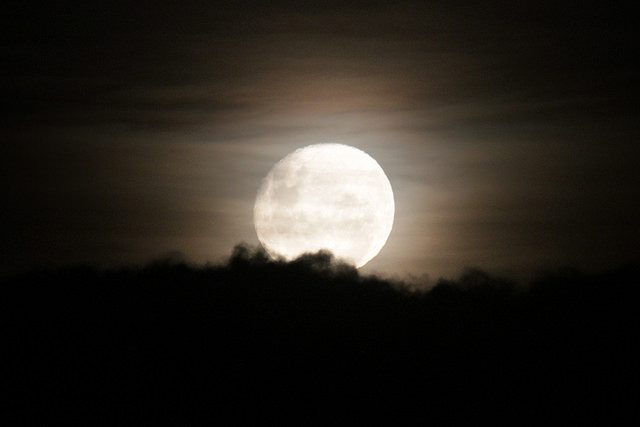
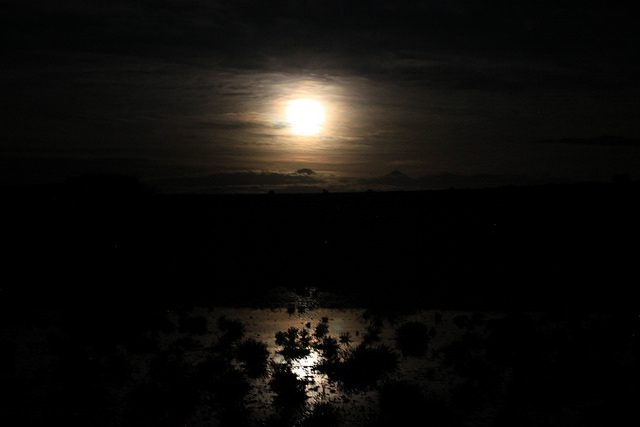
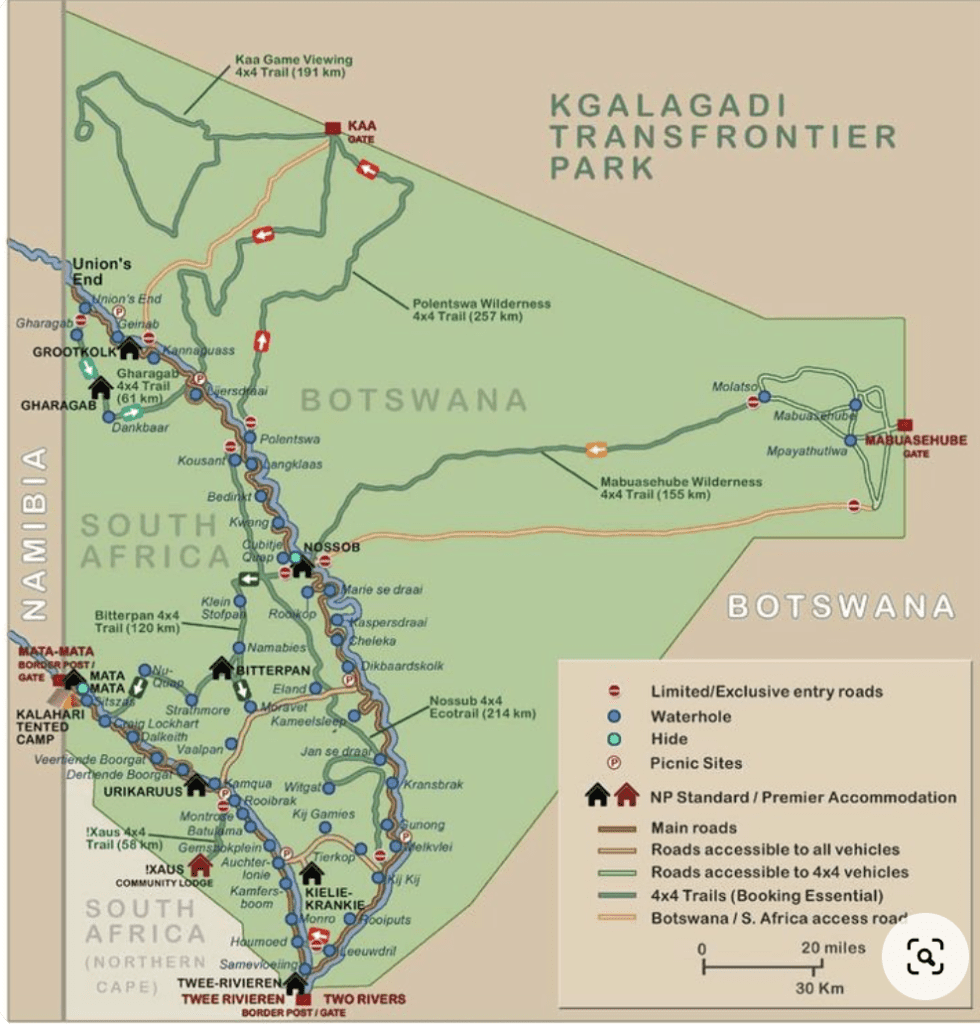
ITINERARY: Kgalagadi Lodge (x1) – Twee Rivieren (x1) – Nossob (x1) – Mata Mata (x1) – KielieKrankie (x1)
Day 1 – Thursday 24th March: Travel from UK to JHB to Kgalagadi Lodge
Is this really the Kalahari Desert (?), we wondered! We checked into Kgalagadi Lodge at 8.30pm and they kindly delivered a delicious dinner to our little unit: I had mussels drowned in a garlic and white wine sauce for starters and everyone else had the exotic trio of springbok, ostrich and kudu carpaccio which disappeared in about one minute flat! Hearty rare steaks went down just as easily followed by sweet malva pudding and ice cream … YUM! We sat on the patio finishing our smooth red wine whilst listening to the loud claps of thunder and watching the dramatic lightening fill the night sky planning our route on the map and feeling full of anticipation for what the next day would hold!
This is local life…
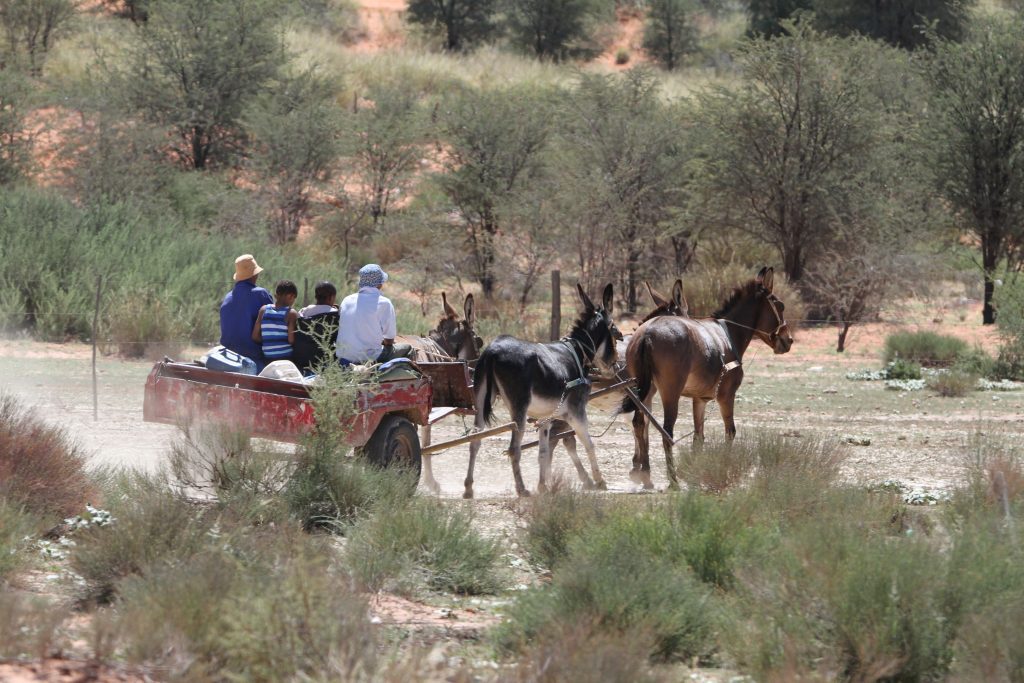
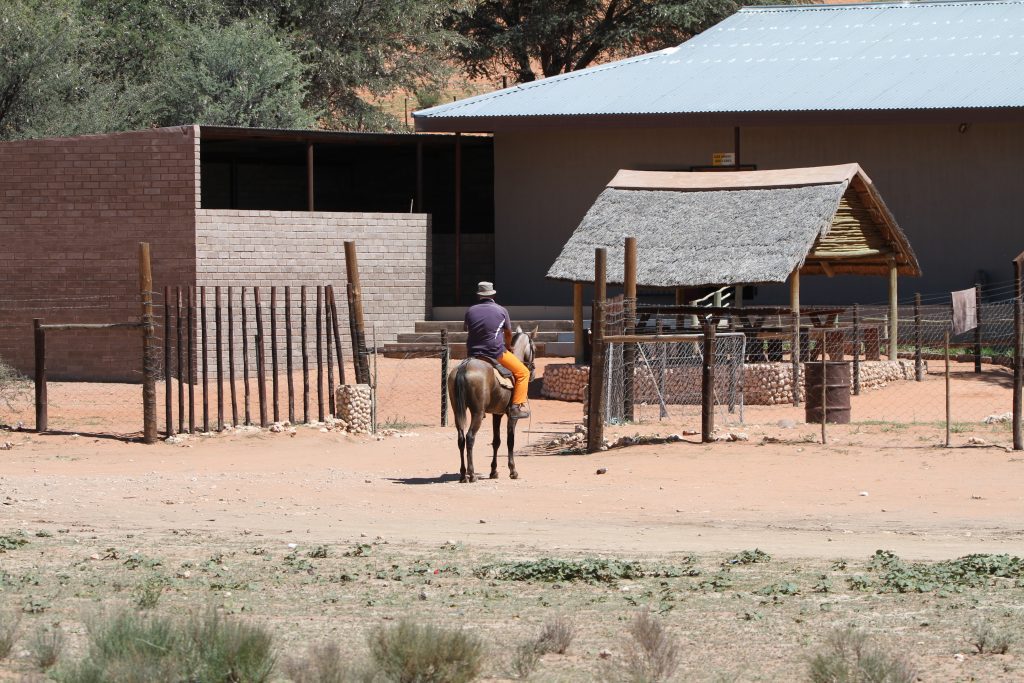
Somebody told us that we need to be careful because when the red sand bites our toes we will be powerless to its intoxication and have to return forever?!!
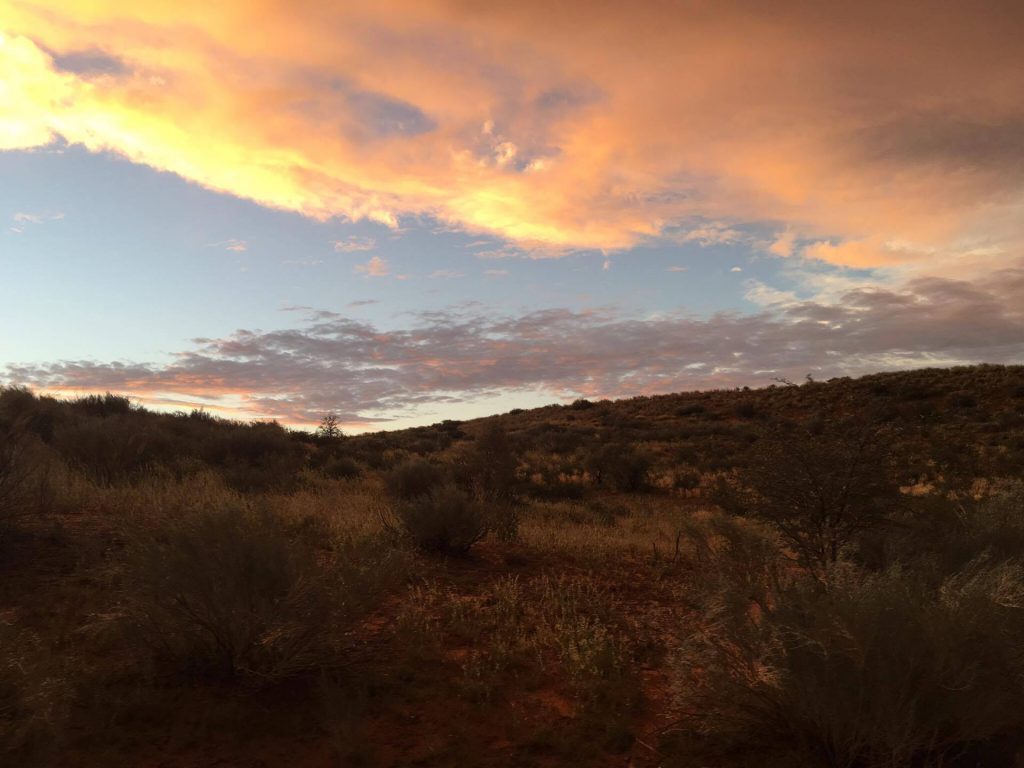
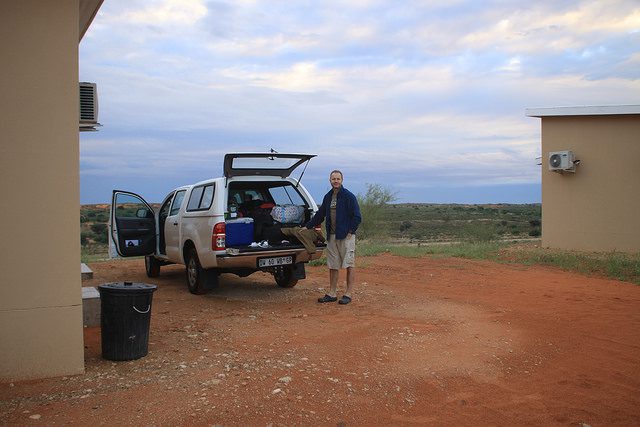
DAY 2: Friday 25 March 2016 (Twee Rivieren area)
Up and ready to leave at 6am. Unfortunately the showers were cold but had to be done after travelling for the whole previous day and night – at least we were wide awake! Lots of shongololos coming out to enjoy the rain! Then we thought we saw an Emu … Yes, an Emu – were we in the Kalahari or the Australian Outback?!
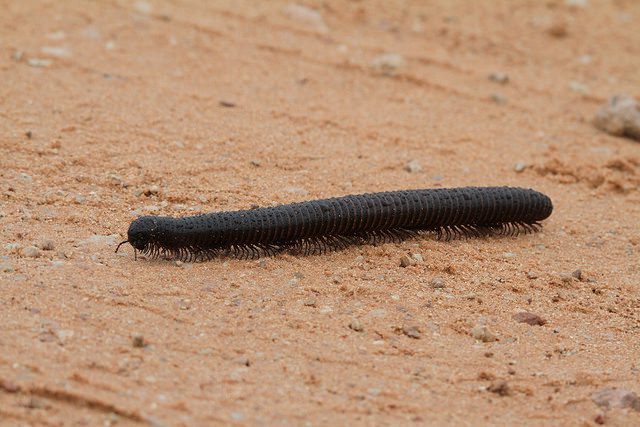
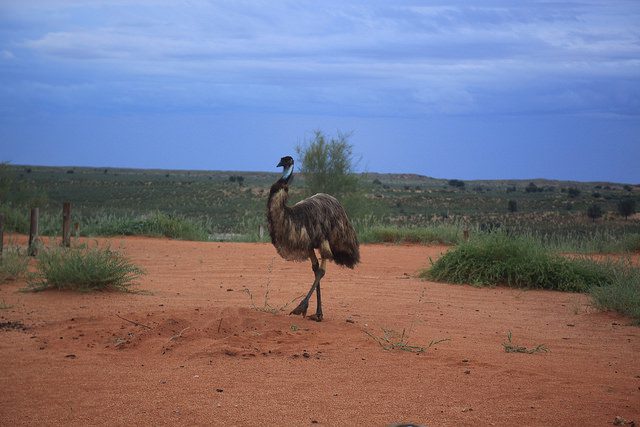
At Twee Riviren we were assisted by a lovely receptionist called Jessie who looked so downhearted on our behalf when she heard that it was our first visit and that the weather forecast was poor with rain which was apparently not good for cat sightings…. ?! Please no… After a quick breakfast of sizzling bacon and eggs and much needed coffee at the TR restaurant we headed out to see what the red sand would be offering to us! The bets were on for what would be our first sighting as we exited the open gate at TR towards the Kamqua picnic spot …what would it be? Warthog? (not many of those in these parts!)… Wildebeest? YES! Accompanied by a herd of Springboks. It was interesting to see male Gemsboks / Springboks / Hartebeest / Wildebeest all pairing up – extra pair of eyes to keep them safe from predators while they protected their little territories from other males.
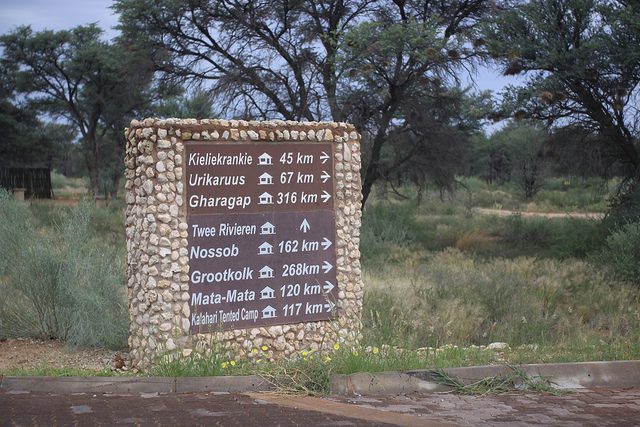
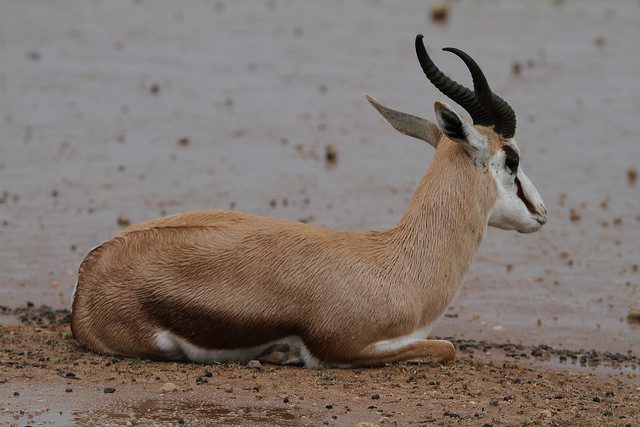
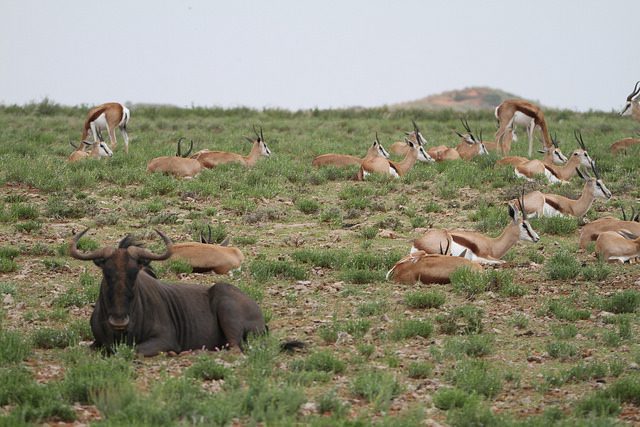
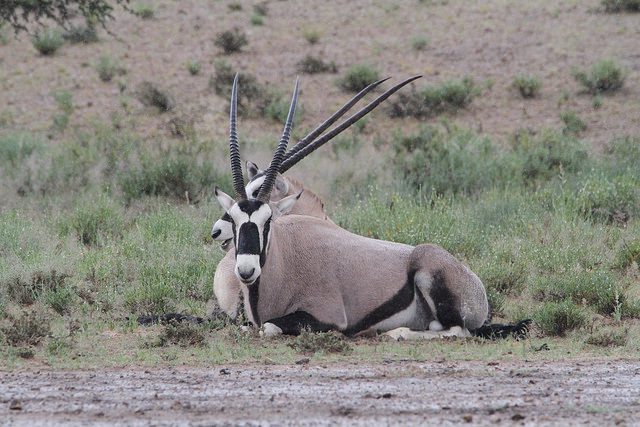
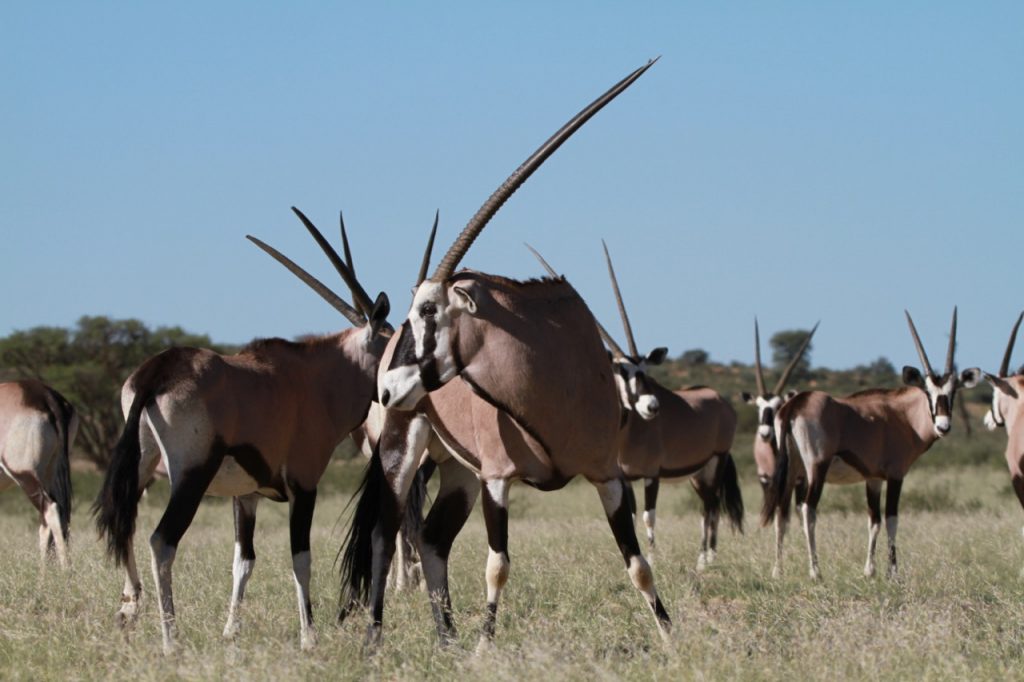
We felt for the puffed up Northern Black Korhaan on the road who refused to move for our vehicle which meant that we had to move to the edge of the damp sandy road to avoid him. They are members of the bustard family. This little chap was too cold to make the notorious raucous ‘kerrak kerrak kerrak’ call so often heard. The male gives elaborate mating displays but the female rears the chicks on her own.
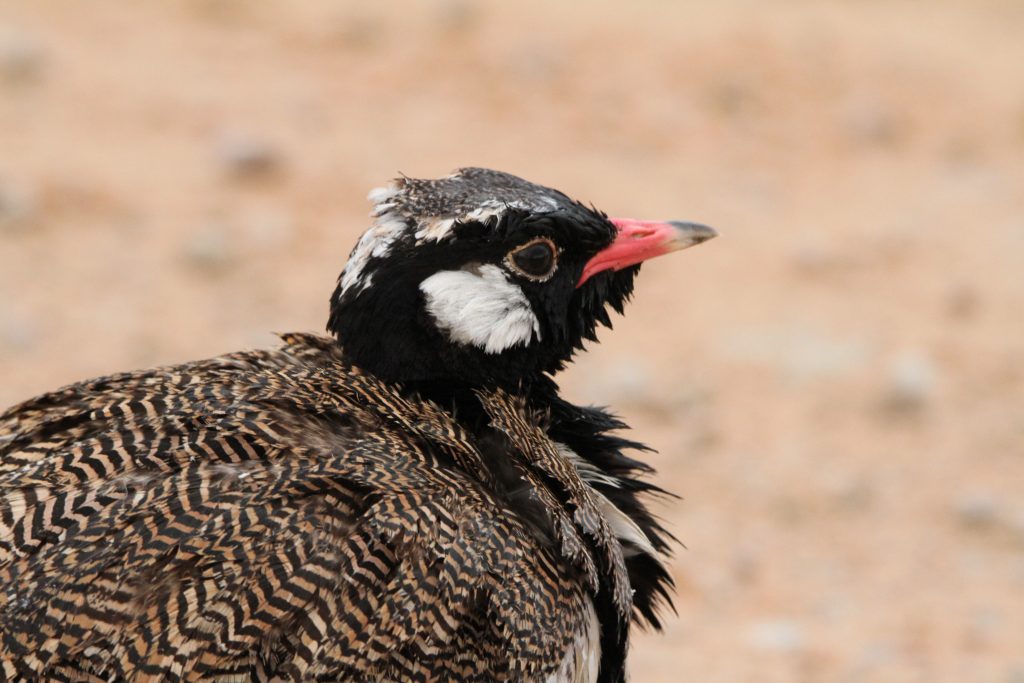
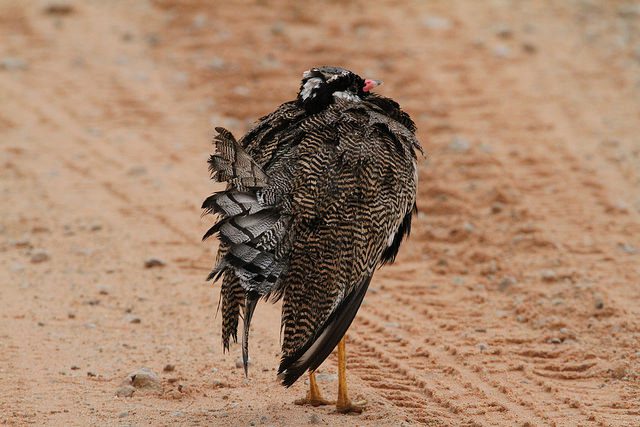
We negotiated a few flooded sections of road whilst observing a Crowned Plover – another interesting species of bird which lives up to 20 years and may mate for life. The female incubates the egss, unless it is very hot when the male may assist. Chicks can leave the nest after about 4 hours once their down is dry, and the parents take it in turn to care for them directing them to food items while the parent not on duty can feed. It eats mainly termites and other invertebrates.
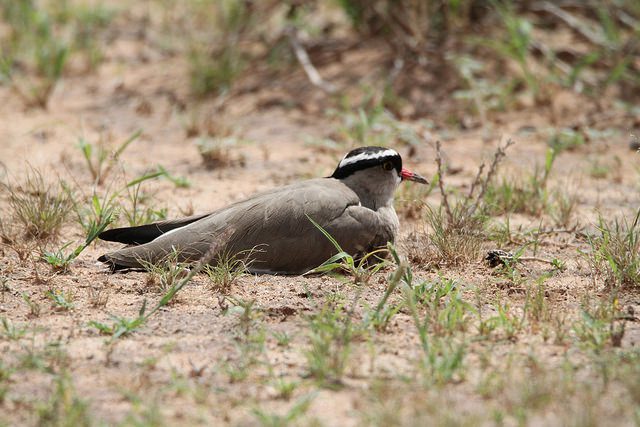
This beautiful pair of black backed jackal kept us entertained for ages foraging on the side of the road next to our parked car. They mate for life and are extremely opportunistic feeders being able to locate carrion from 11Km downwind! We left when she needed the toilet … Apparently the male lifts his leg when urinating and the female squats…
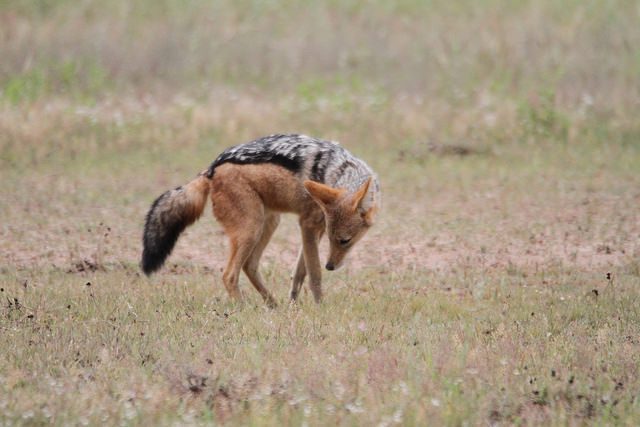
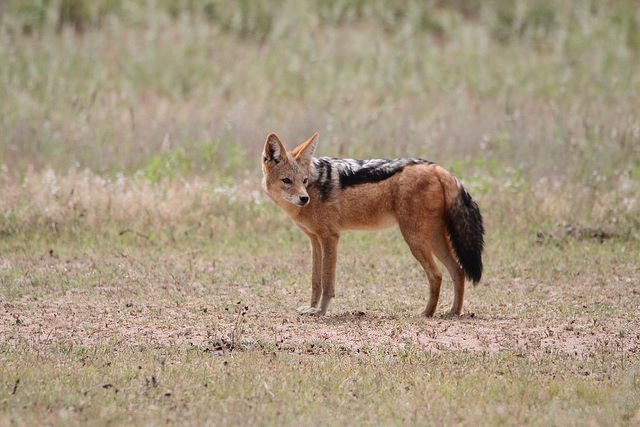
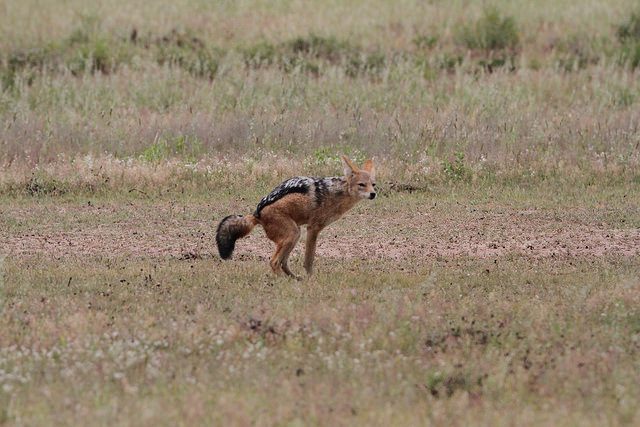
We decided to pull in at Montrose before heading for our picnic lunch and to our surprise came upon another car (we thought there was no one else in the park as we had seen no other cars yet!). We almost did not spot the stunning leopard next to the log! She was a young leopard enjoying the shade. We have subsequently discovered that her name is Masego (and yes, we do know what happened to the poor little boy this last recent Saturday – but that is not for debate here).
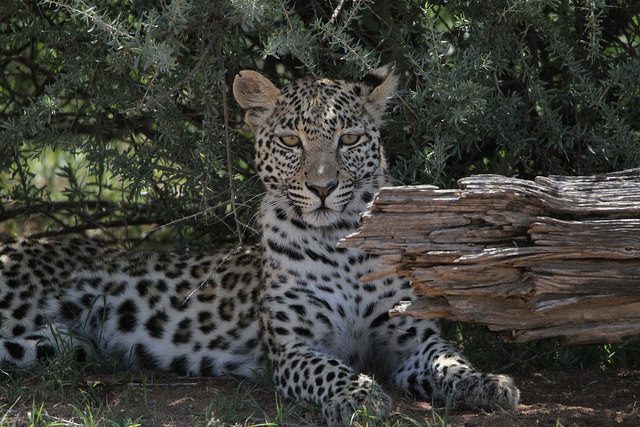
She lay there quietly observing our cars parked a respectful distance from her. However, on arrival of a third car, I am certain that she felt as irritated as we did by the this vehicle who insisted on leaving their engine running for another 20 mins of the sighting (until the gentleman parked next to us rolled forward and asked him to please switch off)… finally! Peaceful bliss with only the melodic hum of birdsong in the background and this magnificent creature. With the lack of engine noise disturbance, the young leopard stretched and sat up… We held our breaths as she stood up and moved forward to the grassy area….She was fixated on an inquisitive ground squirrel and a lazy tortoise just a few metres away… and went into stalk mode… Alas, her youthful inexperience yielded no trophy and she clumsily stalked and frightened her would be prey before disappearing into the bush. We did take a few photos of her attempts to capture the squirrel (the tortoise had nonchalantly plodded away without batting an eye lid whilst all this went on!) – unfortunately in our excitement we must have pushed an incoorect button and none of these phots came out – typical!
She disappeared into the undergrowth and we sat there in grateful amazement for what we had just witnessed.
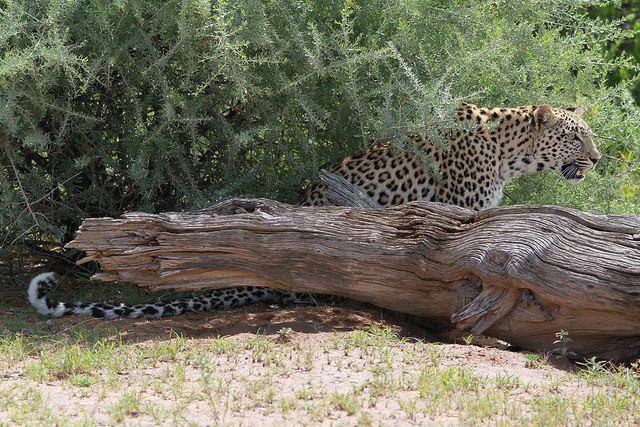
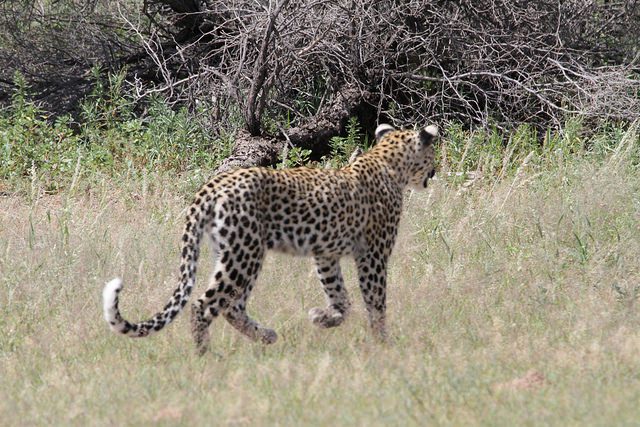
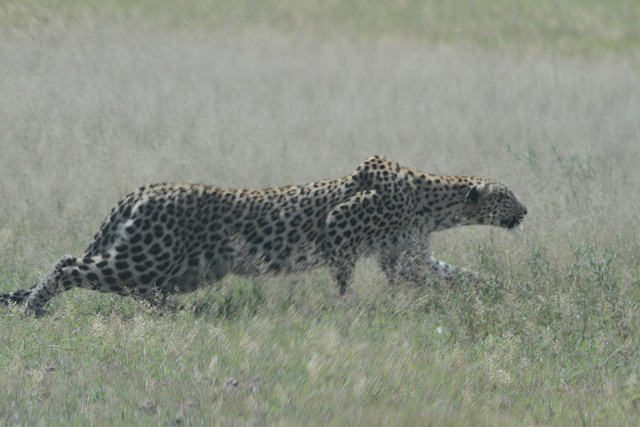
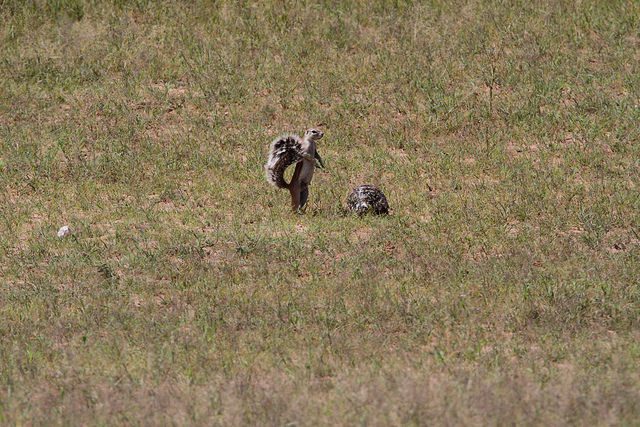
Although we were hungry we had a quick toilet stop and visited the Auchterlonie Museum and mused about the trials of those living there in that day and time.
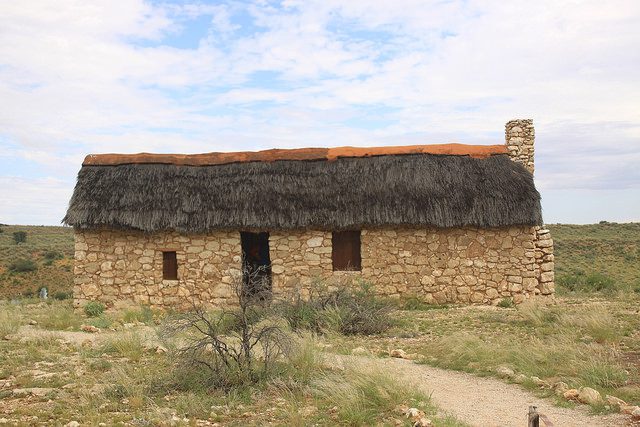
Whilst chatting about the day’s events we enjoyed a delicious picnic lunch of cheese and salad rolls at a very quiet Kamqua picnic spot. We found it impossible to photograph the crimson breasted shrike who teased us from behind the branches darting away just as we focussed with our cameras.
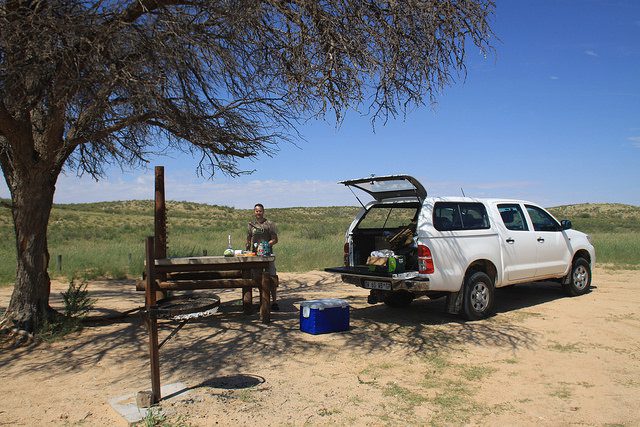
Fortunately a majestic martial eagle was very happy to pose for some photos and appease our frustration. The martial eagle is the largest eagle in Africa and we were delighted to sit with this one admiring his fine looks and large talons. Their wingspan is between 1.9m and 2.6m! They mate for life and raise only one chick at a time, every two years.
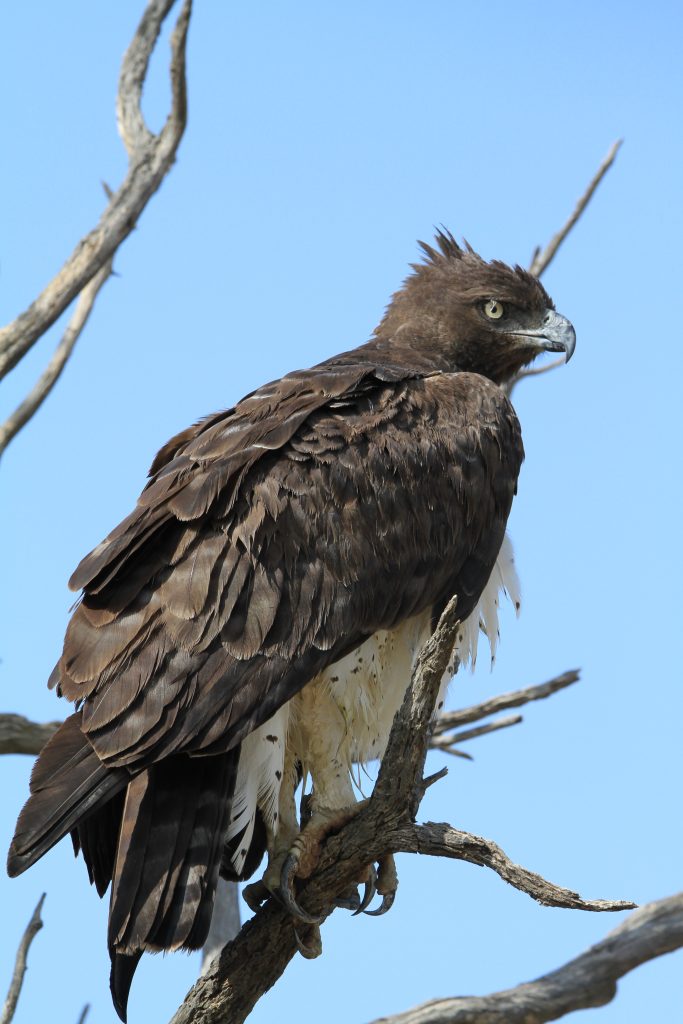
We were delighted at the abundance of the kori bustard in the KTP – an amusing tale: the very first time we ever spotted these birds was in the Serengeti where we understood from our heavily accented guide that the bird was called a ‘gory bastard’!! Slightly awkward when I excitedly used this name on our next sighting with a car full of people at the Kruger! The Guide quickly set me straight! LOL!
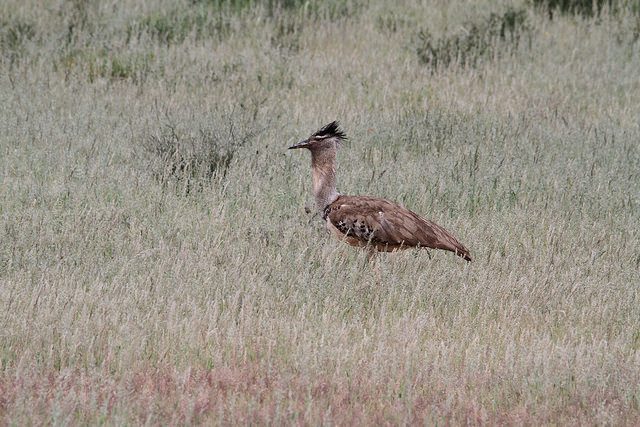
Saw our first herd of healthy looking hartebeest. Despite its clumsy appearance, hartebeest is actually one of the fastest antelopes. It can reach the speed of 43 miles per hour when it needs to escape from the predators. Our ranger told us that family groups tend to be comprised of a female and several of her female offspring of varying years of age – the males leave their mothers by 3 years.What an amazing day! We arrived back at TR at 5pm to check in and stopped at the well stocked shop for paper plates, cutlery etc for picnic lunches – the girls waited in the car. While we were in the shop THE HEAVENS OPENED IN BUCKET LOADS! Thunder, Lightening, torrential downpour! We felt so so sorry for the campers who had just lit their braais!
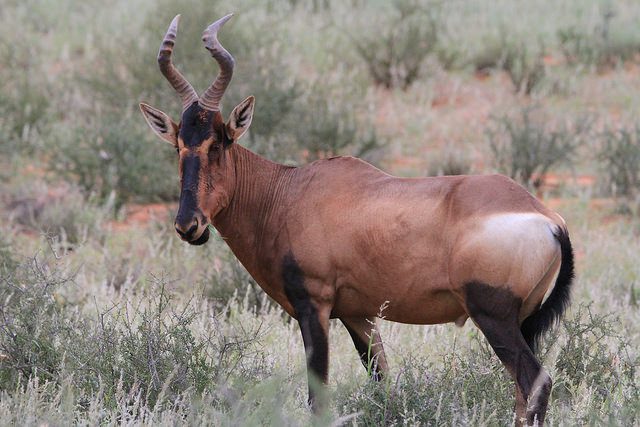
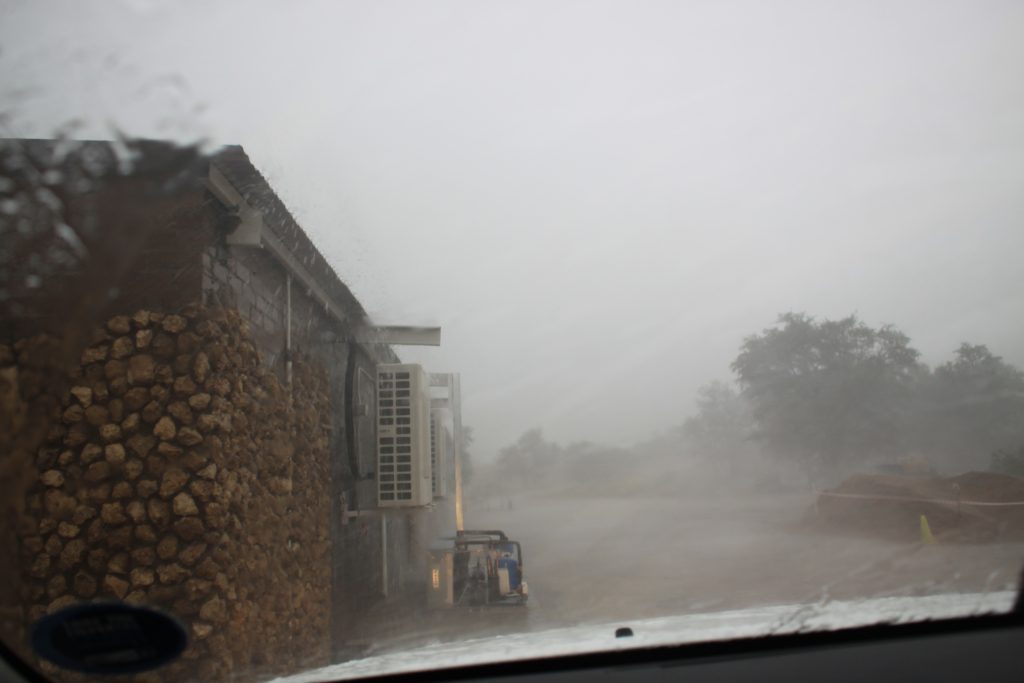
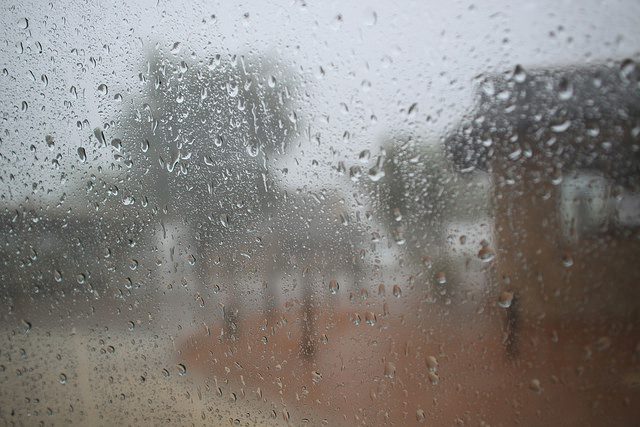
We deposited our bags in the comfortable 4 bedroom chalet (quite a bit of bat poo ) at the edge of TR and joined the 6-9pm sunset drive. Thanks to the rains the scenery was spectacular – lilacs, blues, double rainbows encircling the entire sky – we felt like we were in an oil painting depicting paradise! This is Samevloeiing at its best!
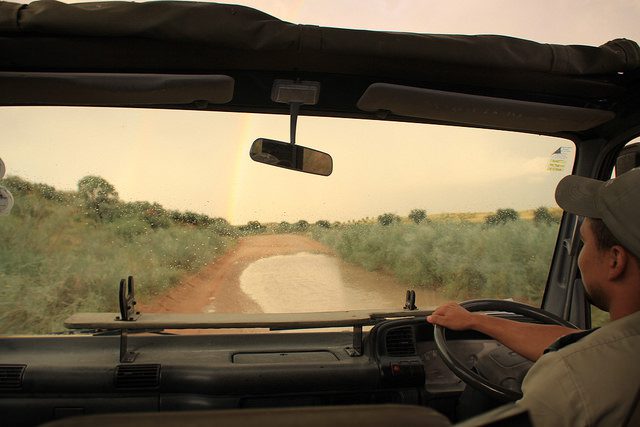
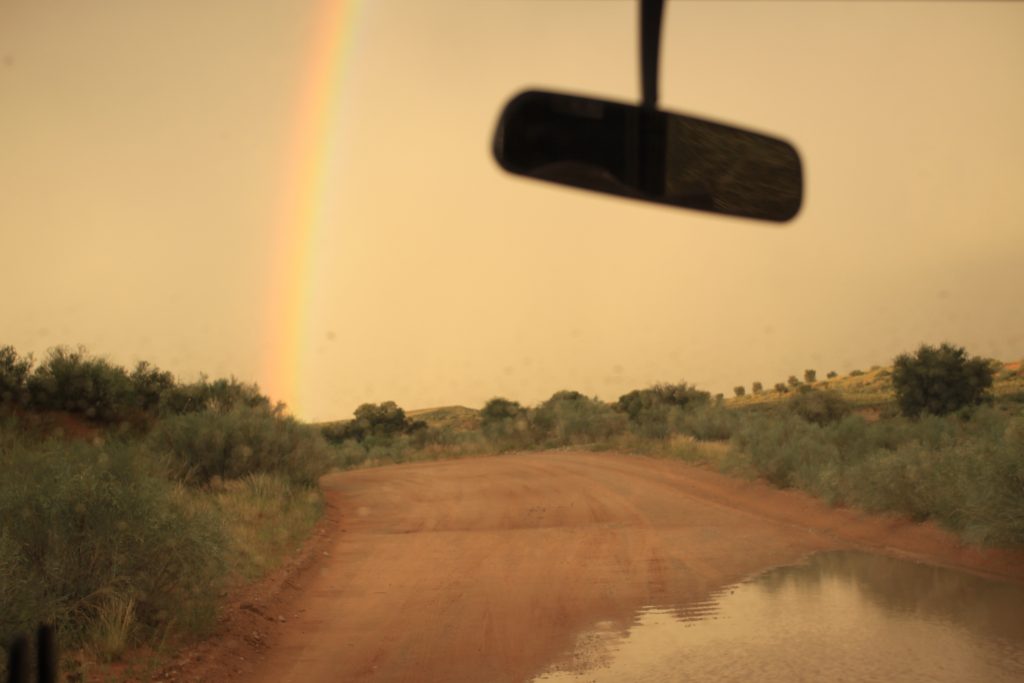
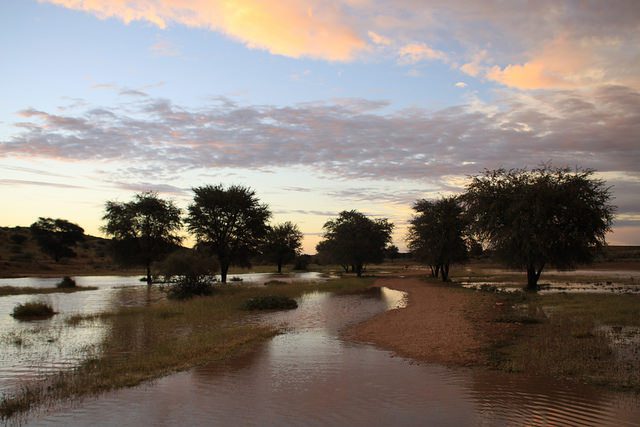
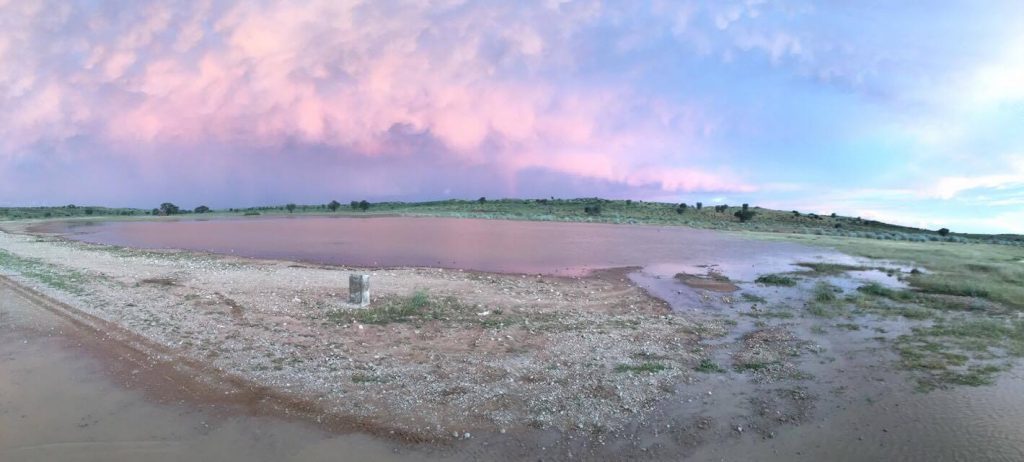
The wildflowers were stunning. Here, in between the yellow devil’s thorn flowers you can see the pretty pink cat’s tail – these flowers dry well and the colours last for years. The erect thunderbolt flowers are also striking.
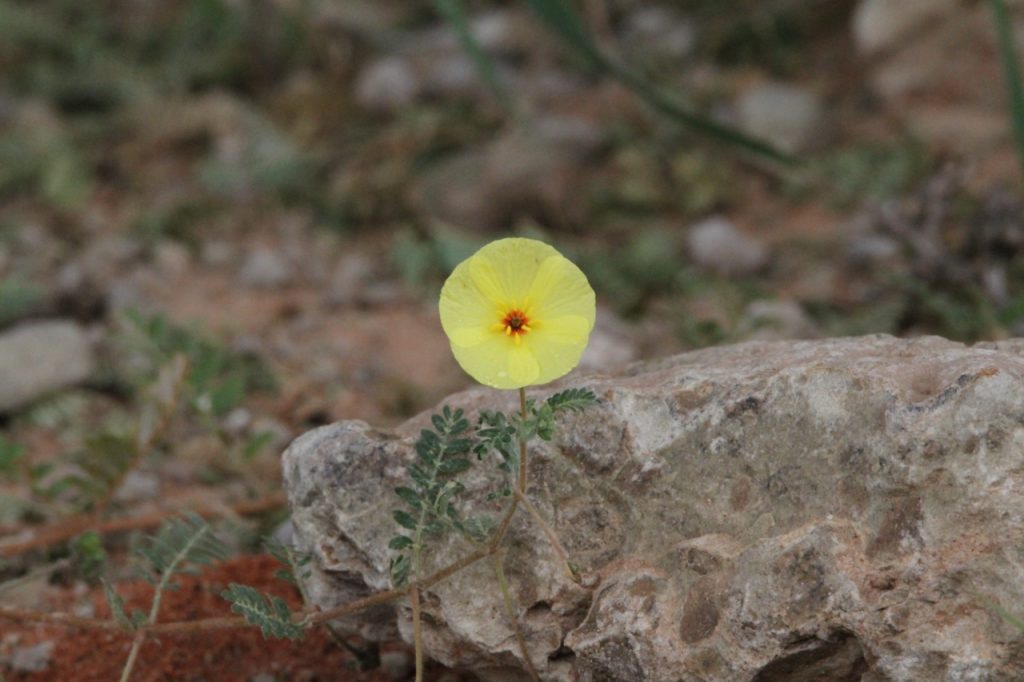
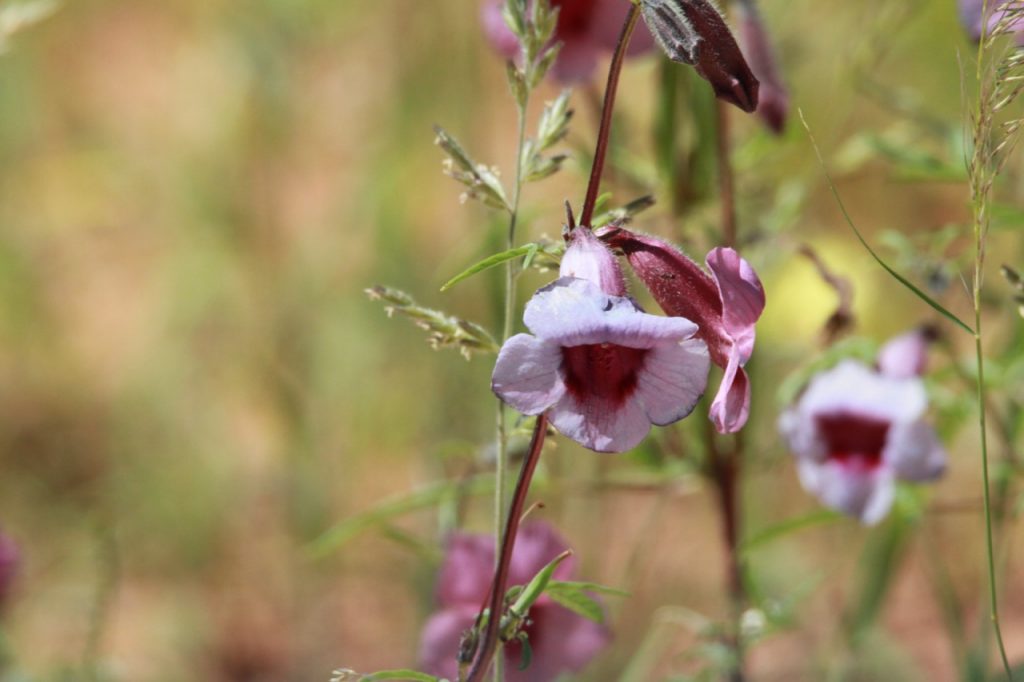
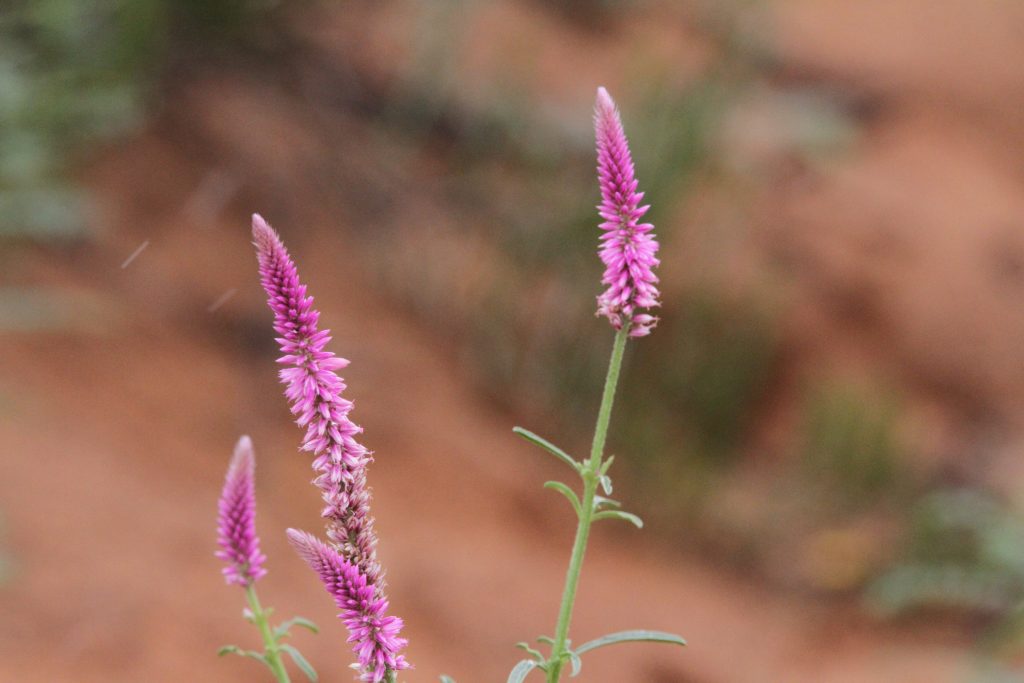
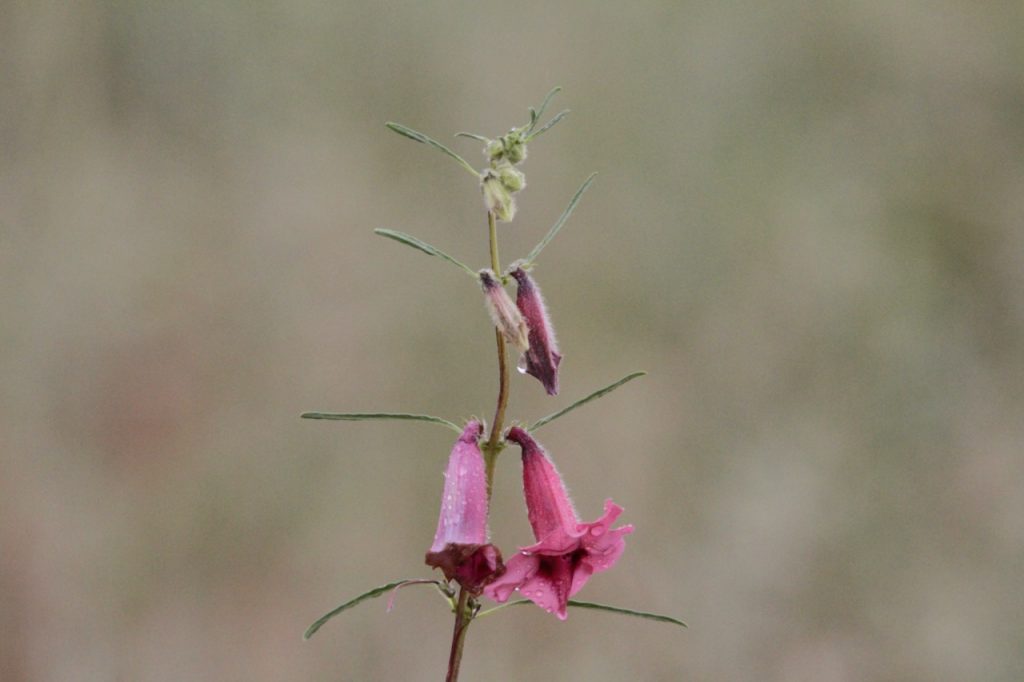
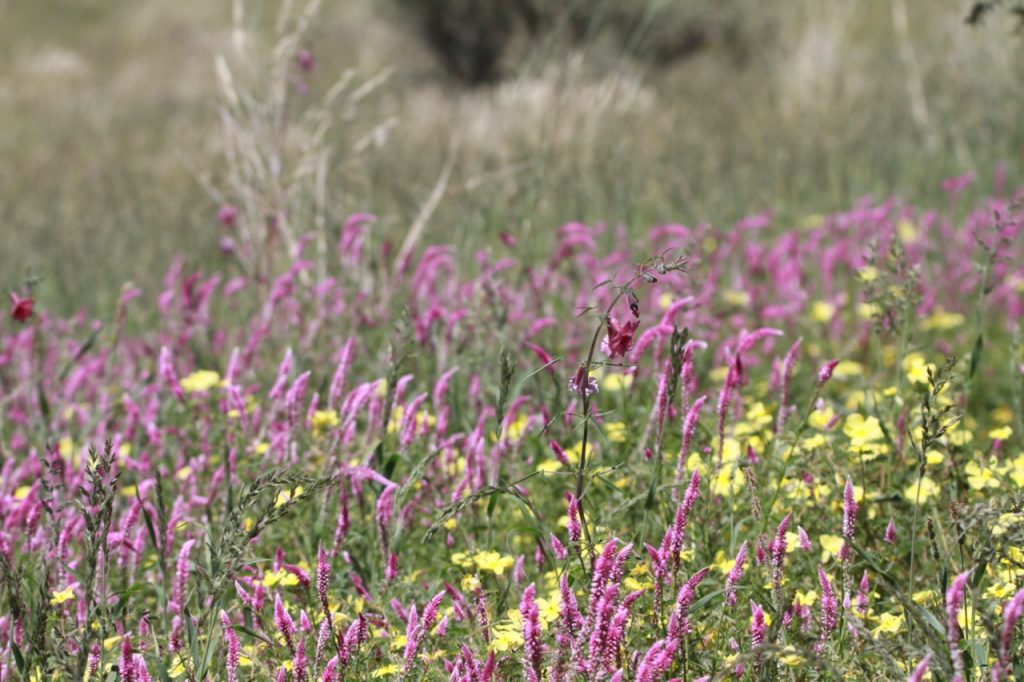
A fairly quiet evening after the rains but still not bad: enormous chatty sociable weaver nests dragging down the branches sustaining their weight; 2 x African wild cats; Gemsbok, 3 x spotted eagle owls, pair of bat eared foxes (tick on bucket list); 1-+ spring hares (Kalahari kangaroo!- believe it or not our first sighting of these despite years at KNP!); shrub hares, genet; mating porcupines; white cheeked owl…then the stunning rising moon – not a bad evening in the bush! What an amazing work of engineering – the social weaver birds nest! They were still chattering as we headed back to camp at the end of the drive (and by which time were were quite chilly!)
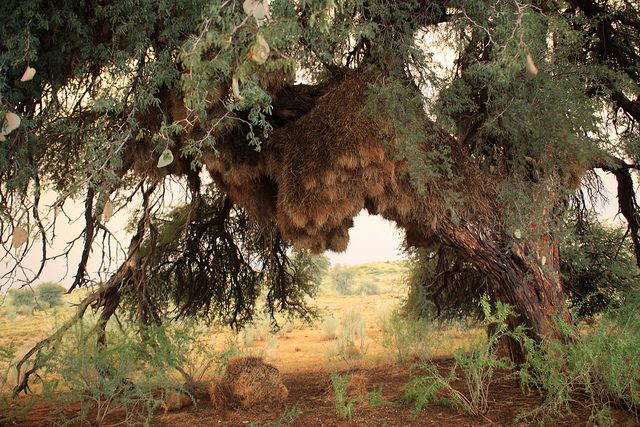
We did not take that many photos as we rather savoured the air which was still thick with the promise of further the rain and were immersed the incredible atmosphere of this piece of paradise. But we did get this slightly blurred but gives you the gist of this spotted eagle owl and what lovely eyes he has! (Even if the pic is blurry!)
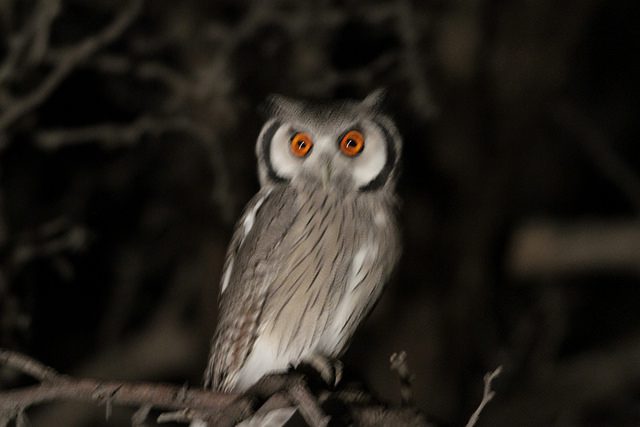
Whilst savouring a full bodied but fruity Cab Sav and enjoying the warmth from the braai which yielded a delicious slab of steak we enjoyed a delicious meal accompanied by a Greek salad and herb sauteed potatoes and followed by milk tart for pudding ….mmm…delicious!! Waiting for our food to go down, we were blown away by the phenomenal stargazing which Charlotte managed to capture through her lens! WOW!!! That milky way and wishing on those shooting stars – I know it is going to be a good year! (charlottes photos only got better during our stay!)
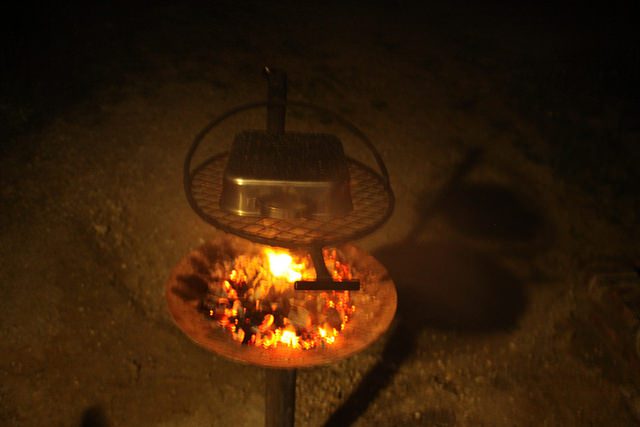
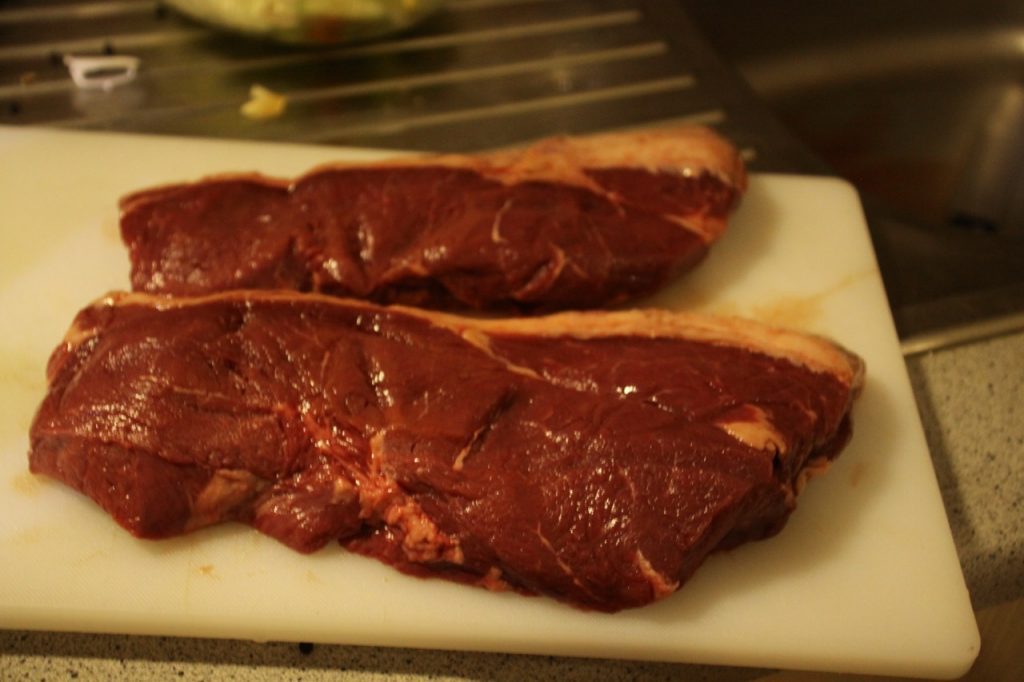
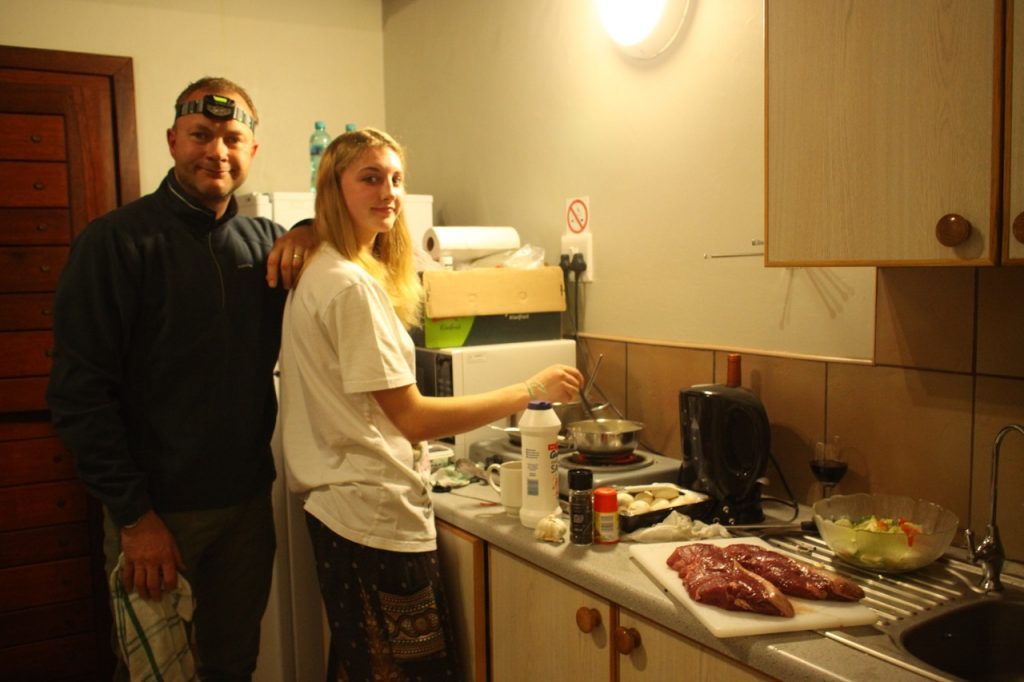
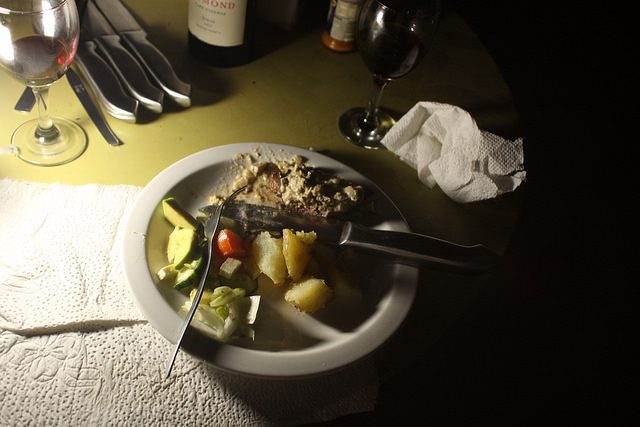
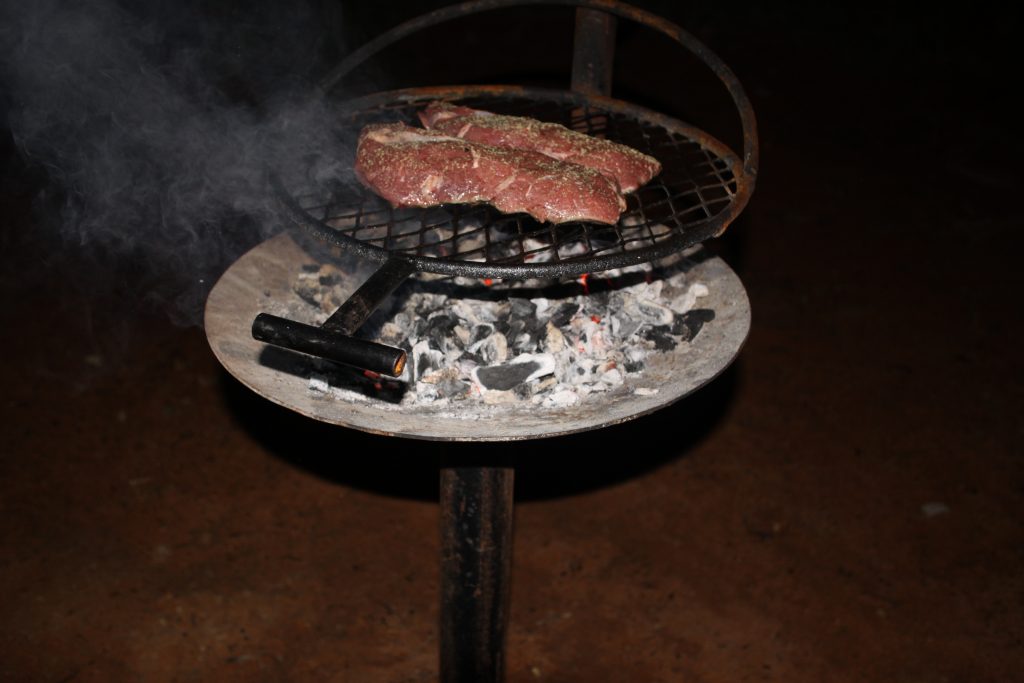
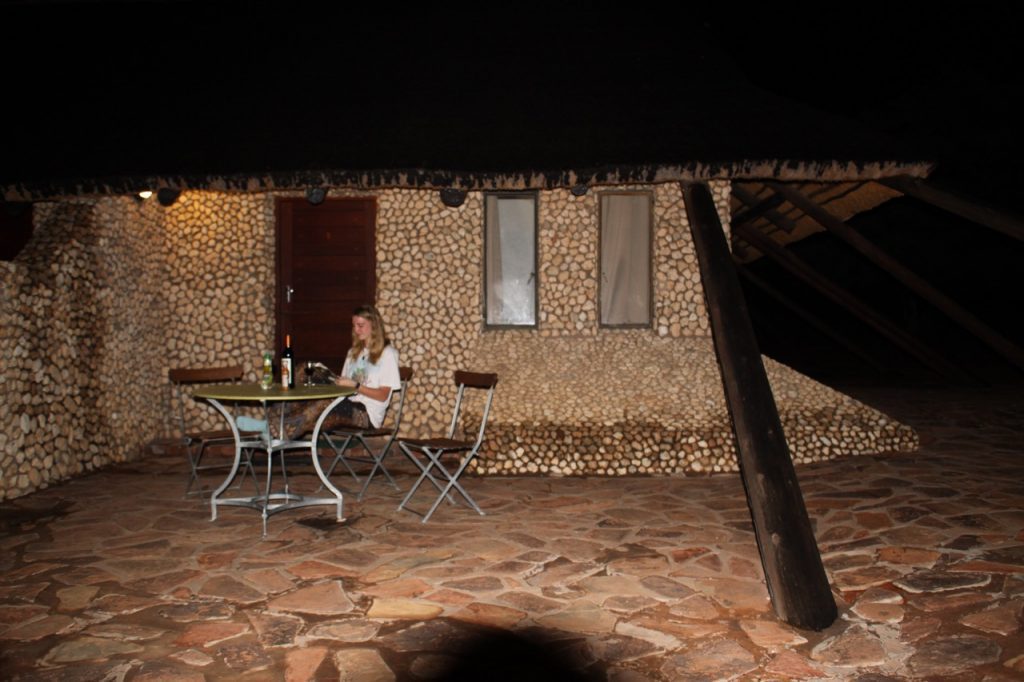
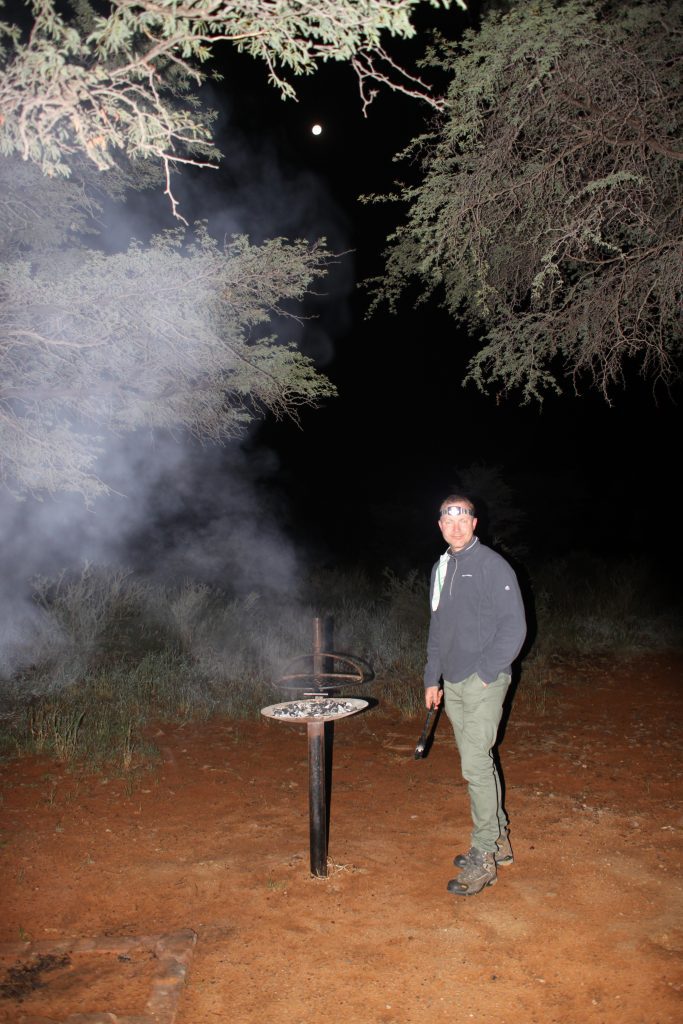
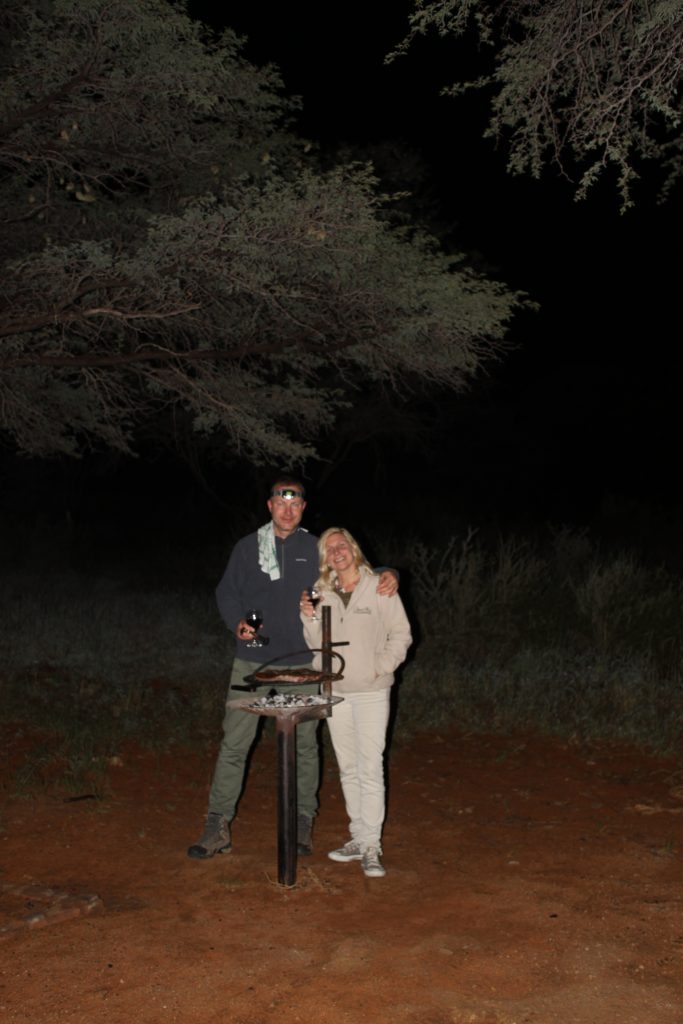
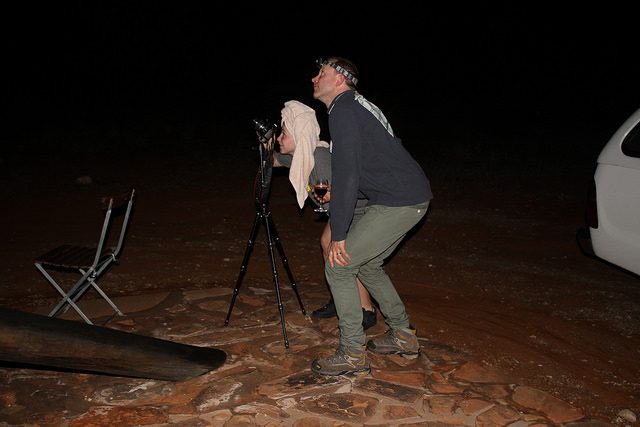
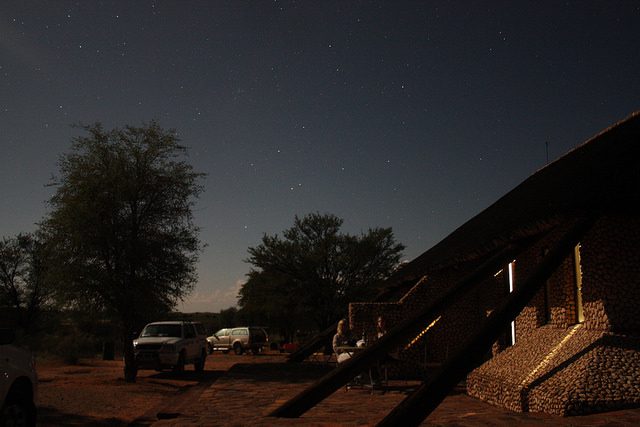
We discussed the day’s treasures before heading in and sinking into a deep sleep – which was abruptly interrupted by the girls’ alarm calls – a bat was trapped in with them and had poo’d on Charlotte’s head! Paul managed to coax it out and soon we were all snoring gently again and dreaming of red dunes and leopard sightings and what tomorrow would bring…
Day 3: Saturday 26 March 2016 – Twee Rivieren to Nossob – What a super fantastic day this turned out to be!!
We were up and out of the gate before 6.30am. A stunning morning with dew glistening on the vegetation (apparently a rare thing in the Kalahari?). Just past Leeuwdril a family of meerkats were emerging from their den to provide the first entertainment of the day. Windows down we breathed in that wet earthy smell that follows rain … divine… Here is the designated sentry standing guard while the rest of the family emerged and started foraging.
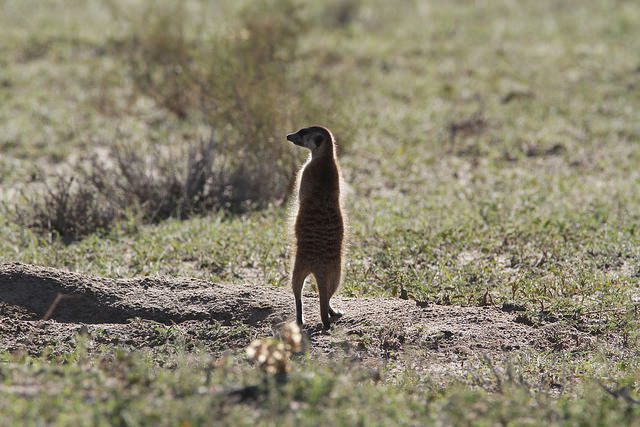
While we were photographing this delightful meerkat family we suddenly heard the unmistakeable roar of a lion reverberating through the dunes. We scanned the roads and the the top of the dunes and we found him – a magnificent and huge black maned male (wish list – tick). Unfortunately he was too far away to photograph properly so we just sat there listening to him proclaim his territory….magical…here is a glimpse of him.
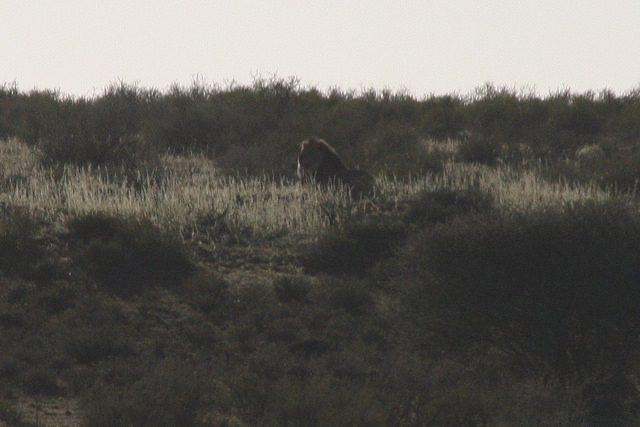
What a great start to our day! We were buzzing…what would be next? …. Ostriches! An interesting fact that I did not know about ostriches is that they are the only birds that secrete urine separately from faeces?! All of the herd’s (what is correct collective noun for ostrich? I have been told herd/flock ?) hens place their eggs in the dominant hen’s 3m wide nest. Her eggs are given the prominent centre place but each female can identify her own eggs amongst the others.
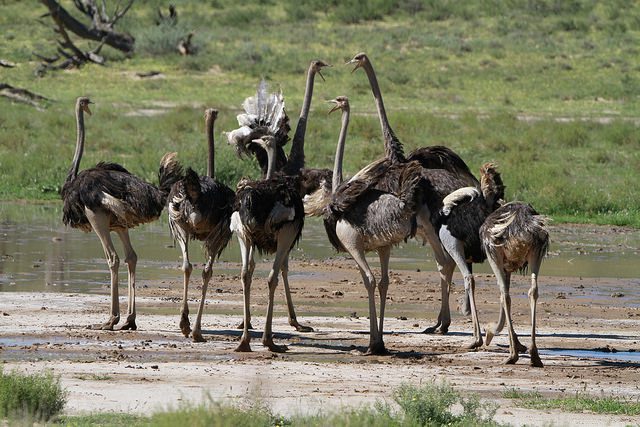
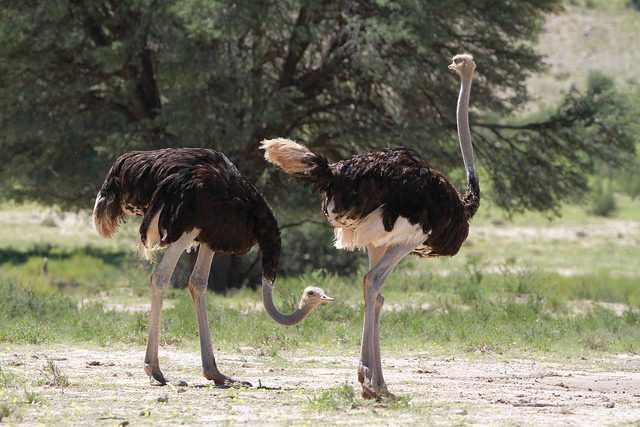
This nervous little fellow looked a little young to be out and about by himself and was startled by the two cars that passed us while we were with him. The two young Springboks were enjoying an early morning rut.
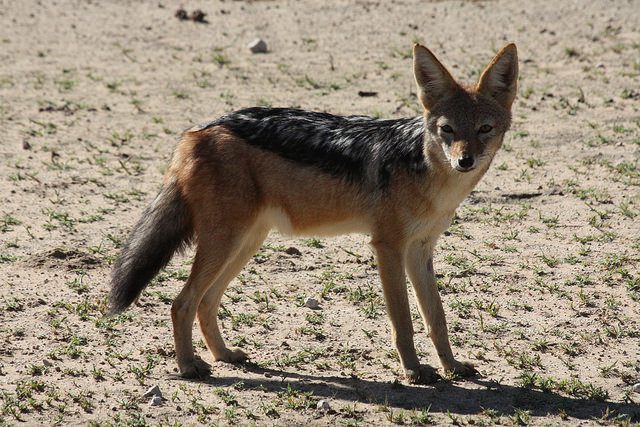
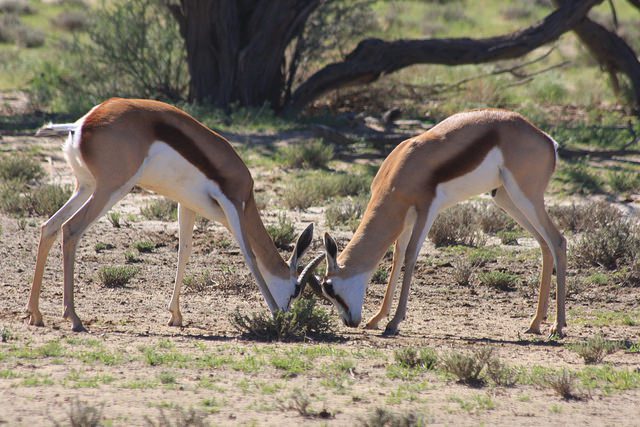
Charlotte suddenly called out loudly, “STOP – HONEY BADGER” !! What?! Where?! Oh, there!! Yippee…We were so excited! A beautiful example of symbiosis where the honey badger was going about his business and in so doing providing for his strutting orange beaked pale chanting goshawk companion. What an incredible sighting all to ourselves which we enjoyed until we left them 40mins later. He was a very industrious little fellow – powerfully digging out sand until his whole body disappeared into the hole that he had dug before moving onto the next site and doing the same, each time after chomping whatever the prey item was that he had caught. When digging for prey a number of lizards and rodents escape above ground and that is what the pale chanting goshawk was waiting for. Wow…could the Kalahari get any better than this?!
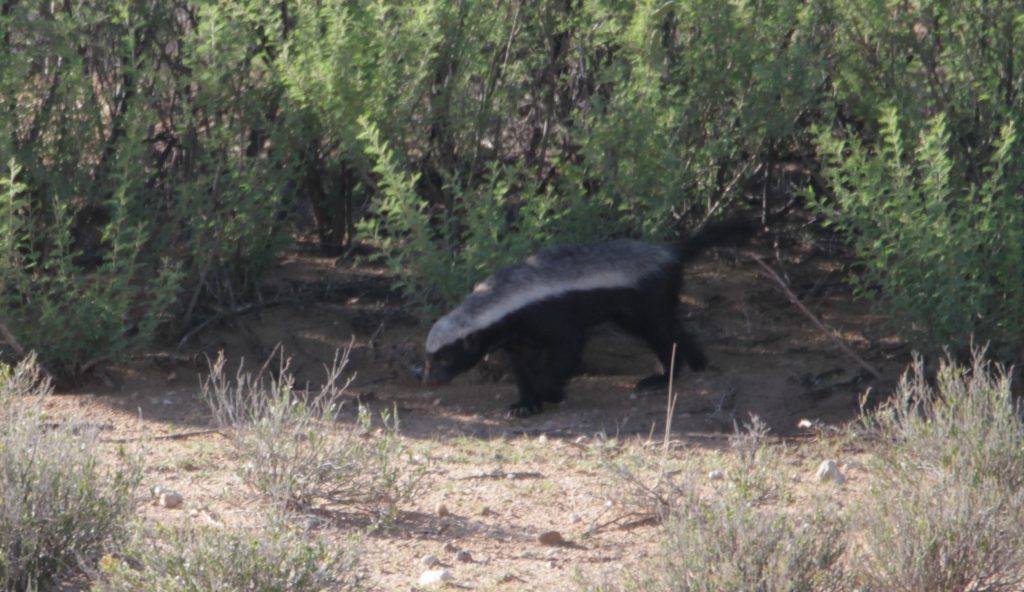
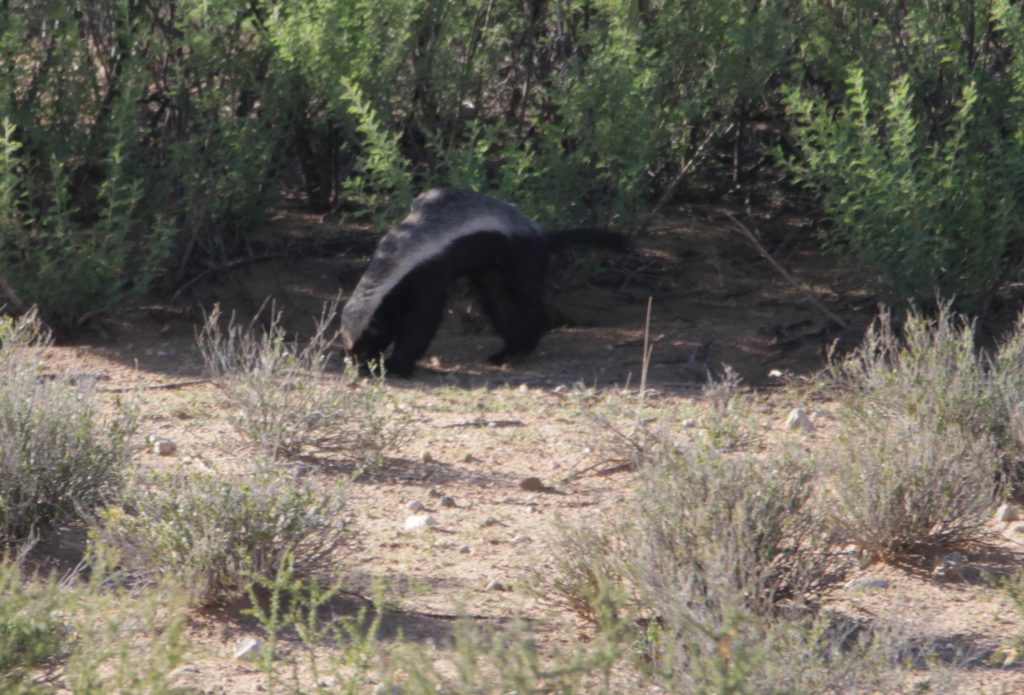
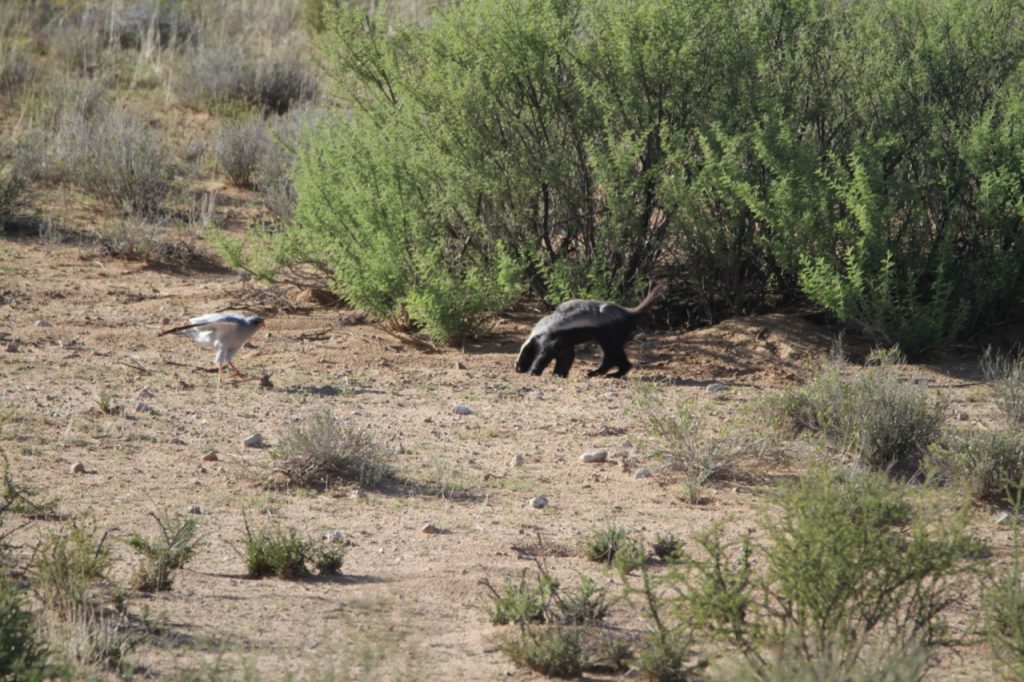
Hungry after the thrill of the morning’s adventures, we pulled in at Melkvlei and had just poured coffees from our flask when a very kind gentleman strolled over to tell us the exciting news that there were two separate lion kills within a couple of hundred metres from each other just up the road. We gulped our coffees down in an instant and headed off in the direction advised full of anticipation and forgetting all about breakfast! Typical KTP style, there was only one other vehicle. We switched off and enjoyed watching the older lioness with 2 younger females and a younger male under a tree enjoying what remained of a wildebeest kill….Suddenly the older lioness’s relaxed pose switched to high alert…… A dramatic series of events was about to unfold before us!
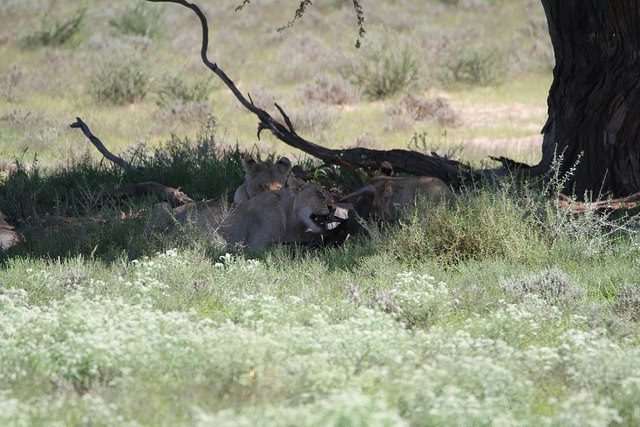
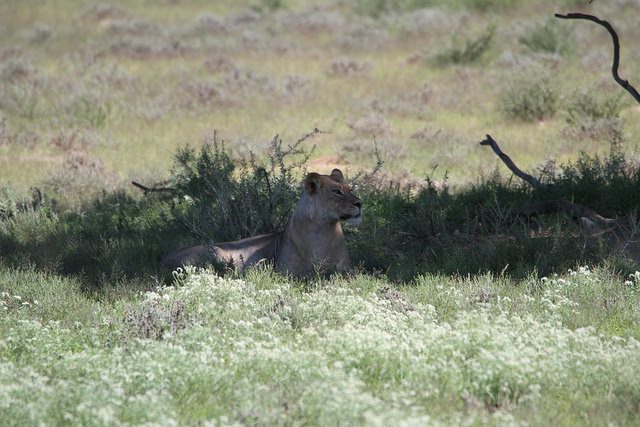
We drove forwards to where 2 other vehicles were parked and caught a glimpse of this big boy who was resting in the shade next to a gemsbok kill (you can just see it to the right of him). A few metres away from him under another shady tree were 3 females – they all had bulging bellies but the gemsbok kill appeared untouched – In the background a pair of black backed jackals were nervously trying to sneak in on the action, getting bolder and bolder. The 3 wildebeest lions walked towards the gemsbok lions looking intently ahead, the young male trailing behind out of view of the photo.
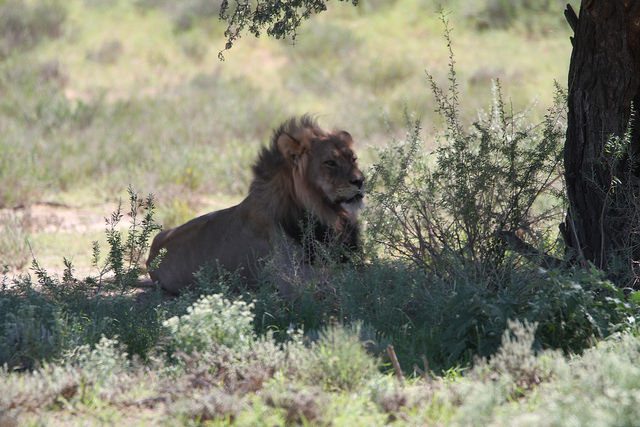
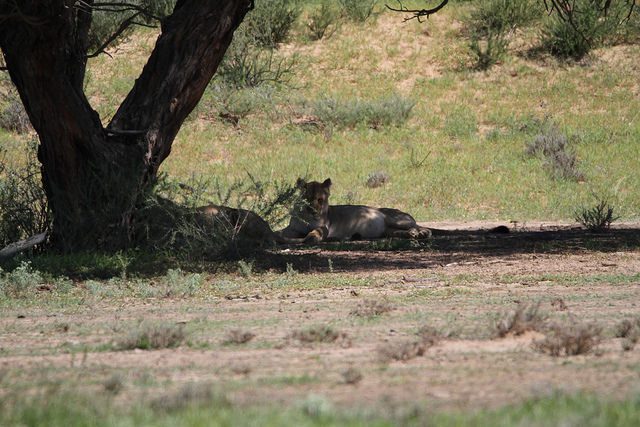
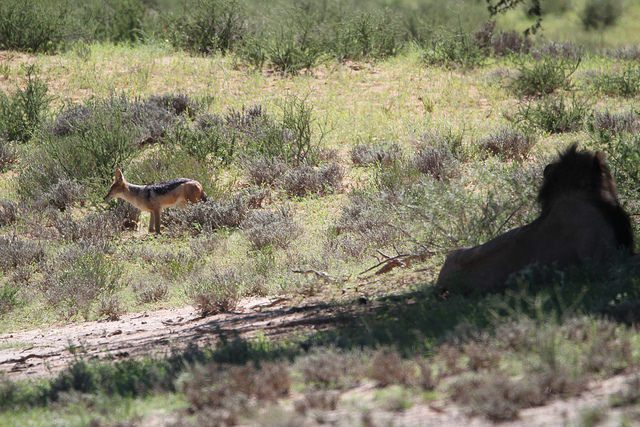
He caught up and they carried on walking…. Suddenly the gemsbok male and larger female burst forward, first at a trot… then at a full charge towards the young male from the wildebeest group. The other gemsbok females set up on the two wildebeest females and they all disappeared in the dust in opposite directions! We had stopped photographing at this point and video’d some but were mostly caught up in the excitement of the moment… WOW. Then we heard the roaring of the big male in the distance behind us, so we turned around and followed the road. Eventually we heard a lion calling quietly and saw the older wildebeest female. She moved backwards and forwards and sideways calling – then the younger female joined her rubbing her in greeting and then the 2nd female joined with the same ritual.
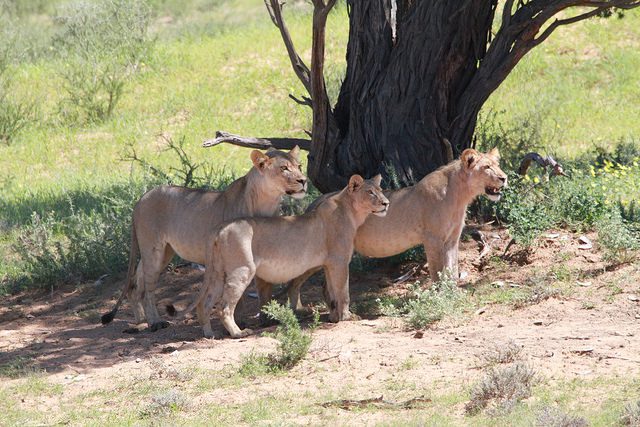
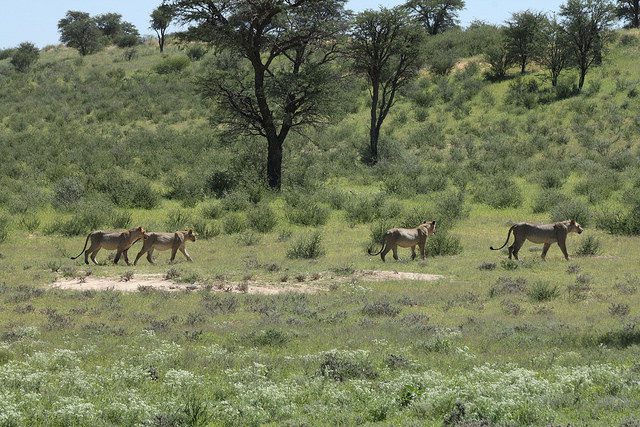
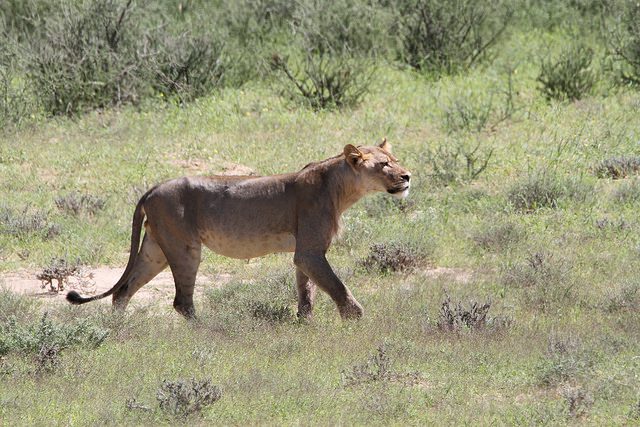
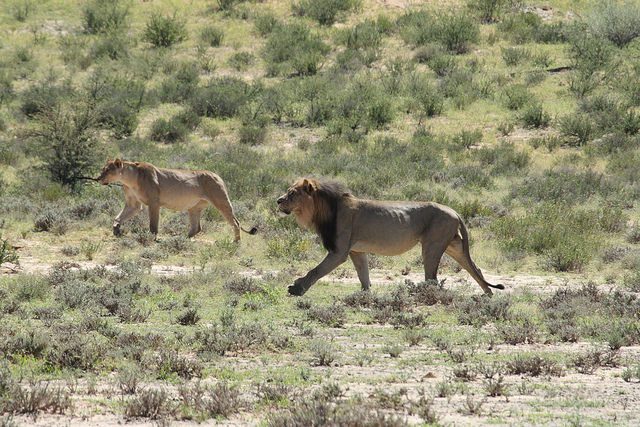
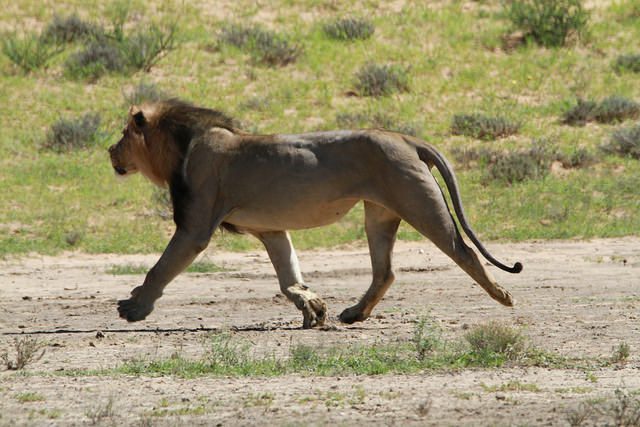
She continued to call but they disappeared over the dunes so we do not know whether she was reunited with the young male…we think they must have been from the same original pride but that the young male was in the process of being ousted and that they had started to split. If the young male had not been the older male’s offspring we are certain he would have killed him brutally in front of us there and then. Trust me the snarls and roars we heard in the distance did not sound friendly either! Phew – the Adrenalin and excitement!
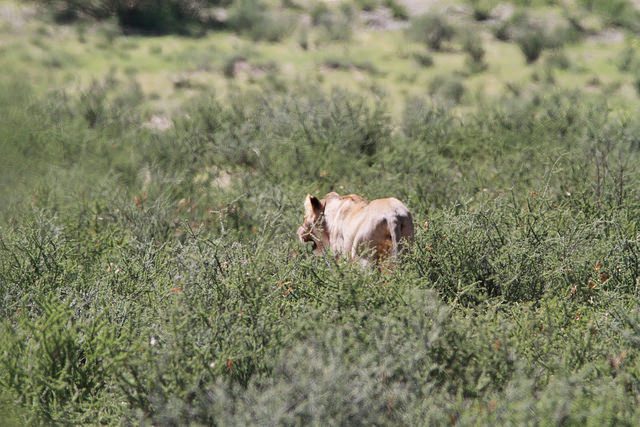
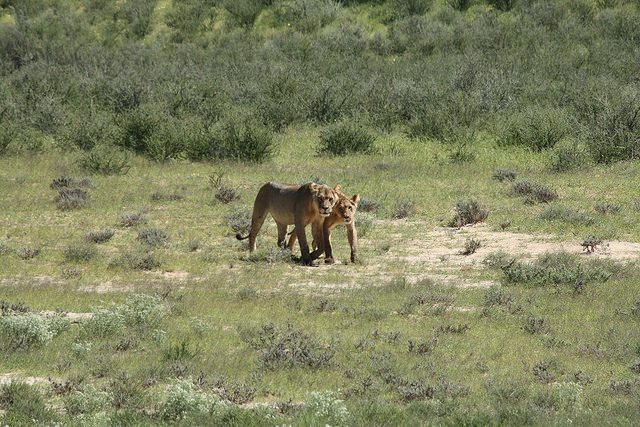
Whilst all this was going on I took a photo of a family in a white VW minibus who had their vehicle side door open to photograph what was going on?!! I despair. What a morning… and we had not even stopped for lunch yet!! All I can say is that the day got even better with a special surprise that should have been on our original wish list and which we have never seen before … Now we were starving! We did not want to turn back to Melkvlei so decided to continue North to Dikbaardskolk picnic site. The road was full of water and quite slippery – great fun but thank goodness we had a 4×4! One advantage of being in KTP during / after rains are the stunning wildflowers – the air was thick with the sweet honey perfume being exuded by the blankets of devil thorn creepers with large bright yellow flowers…mmm, so fragrant. Even the ground squirrels were appreciative! Not to mention. the butterflies and the kori busted!
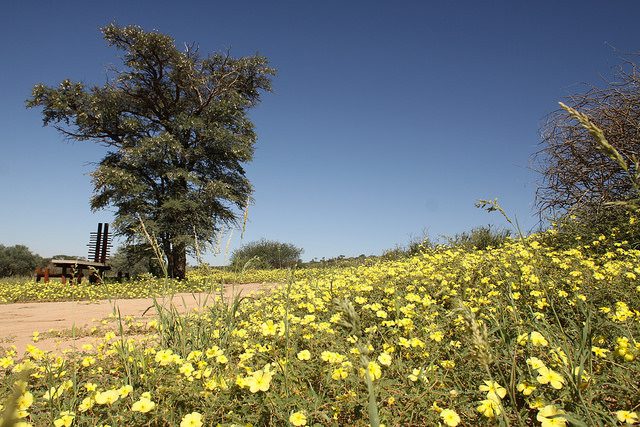
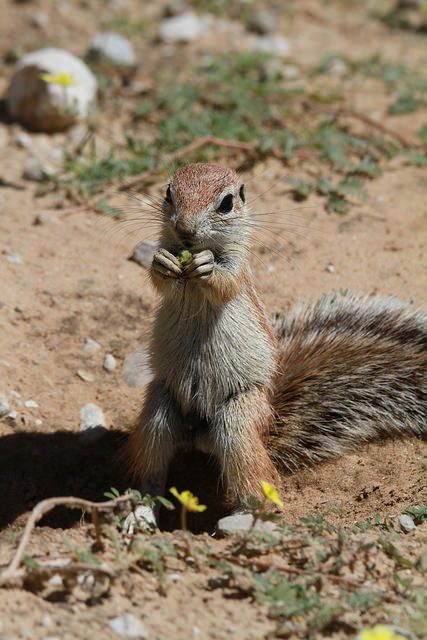
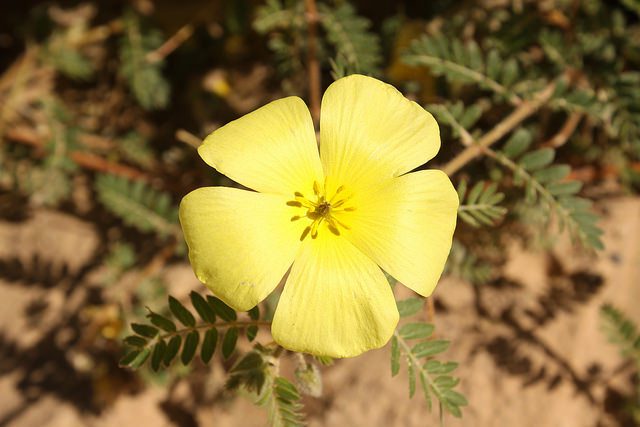
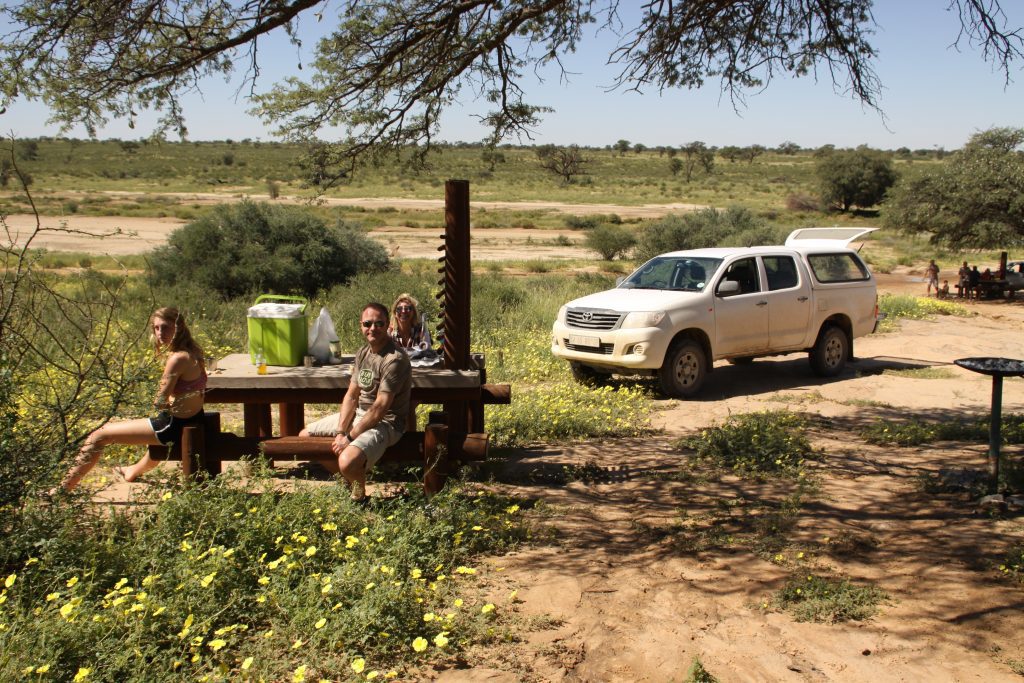
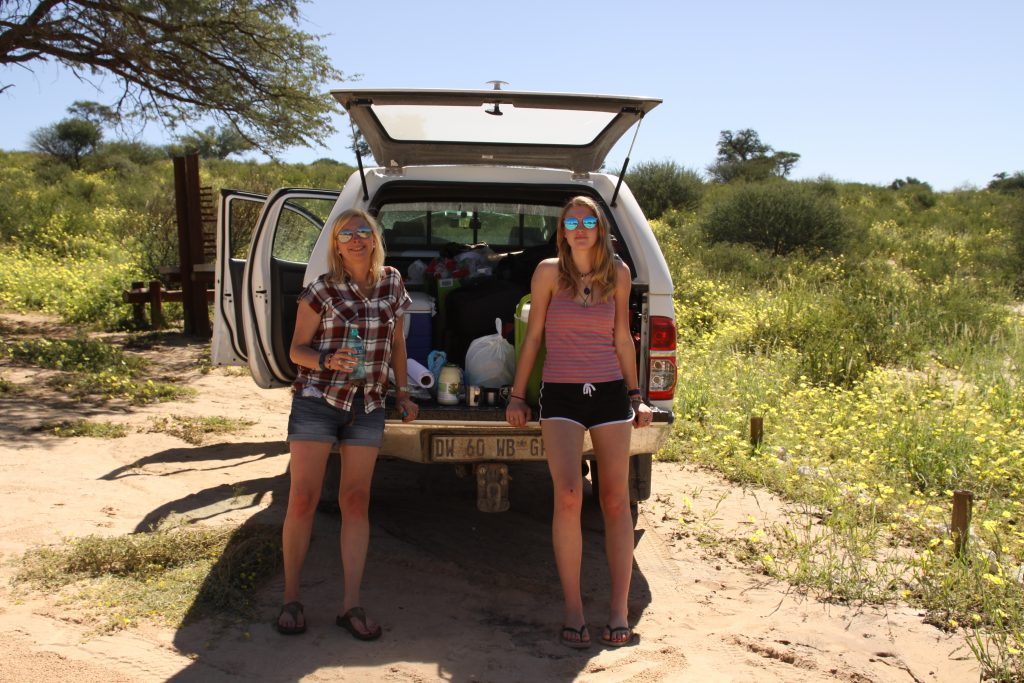
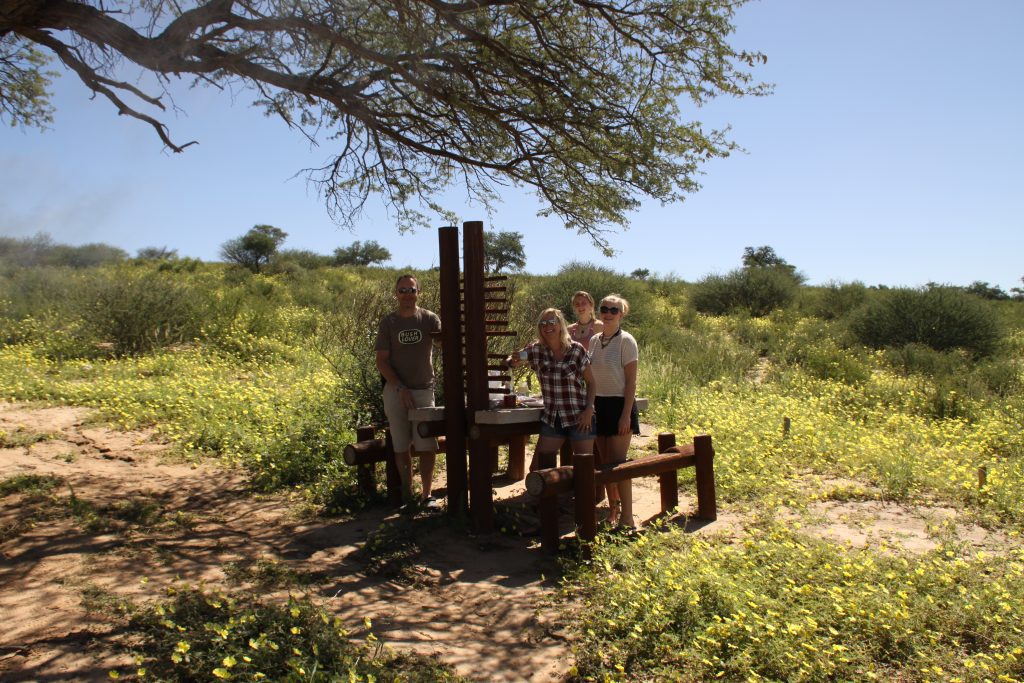
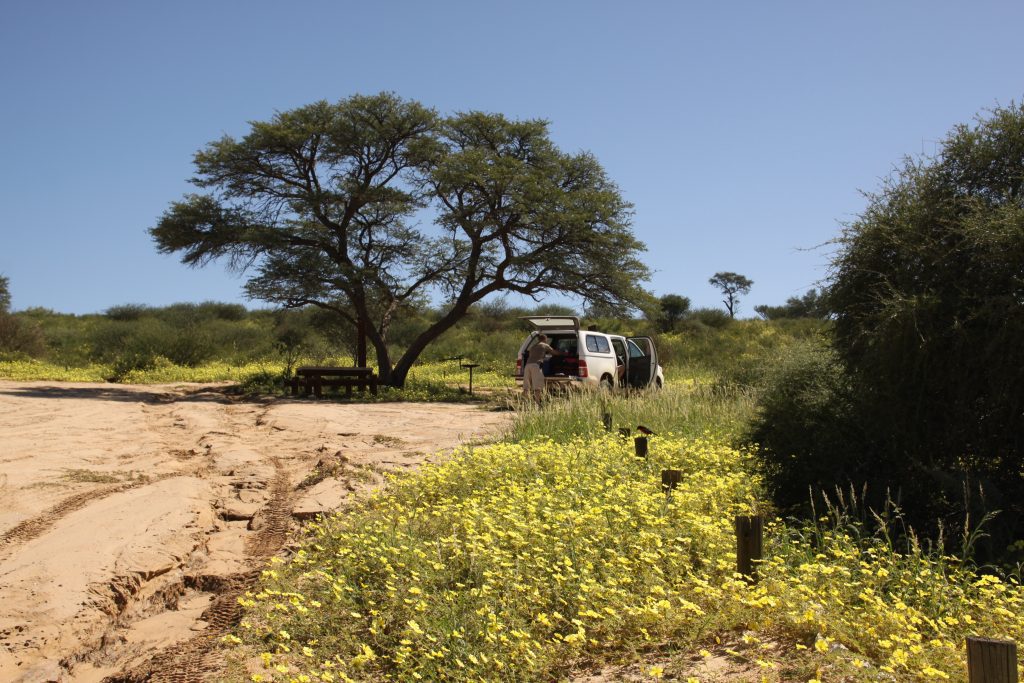
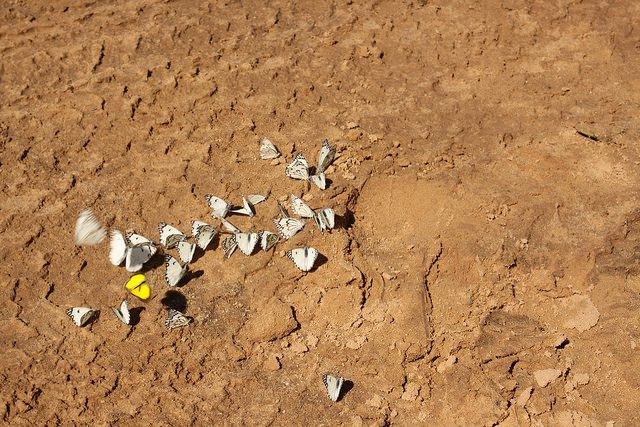
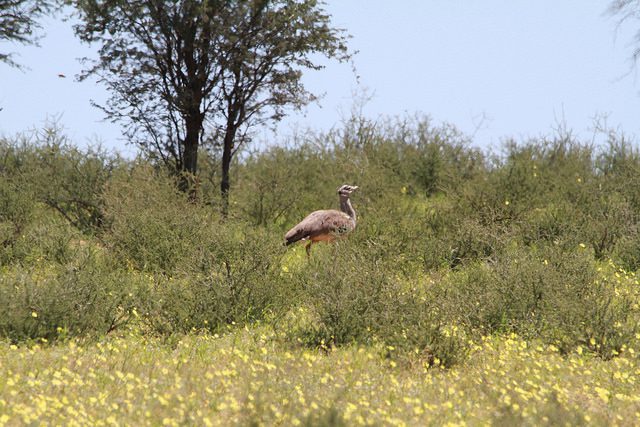
After a delicious lunch of cold meats and salad rolls we felt replenished and ready to continue our journey. The atmosphere in the car was happy but sleepy and we were looking forward to having a swim at Nossob as the day was warming up nicely.
We turned left out of the picnic spot, the children and I were rather drowsy and very relaxed when Paul suddenly yelled ‘CAT! FLUFFY EARS! What – SERv… / CARACAL!’ We could not believe our eyes. The caracal had been trying to have a drink but had been startled by our car and fled into the bush. We switched off the engine and rolled forward – we could just see her through the branches. We were in no rush, so we sat there patiently…after about 5mins she moved out of the thicket and strode purposefully adjacent to us in the bush parallel to the road. .. we just let the car roll with her and followed her for about 15mins…then she moved onto the road in front of us to finish her drink in the next puddle of water. When she was finished she gingerly ran right across the puddle and disappeared from sight across the road. AMAZING – our first ever sighting of a caracal and all to ourselves -what a stunning feline creature!
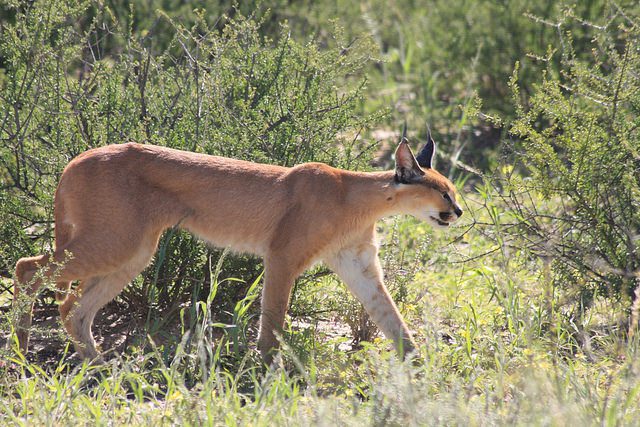
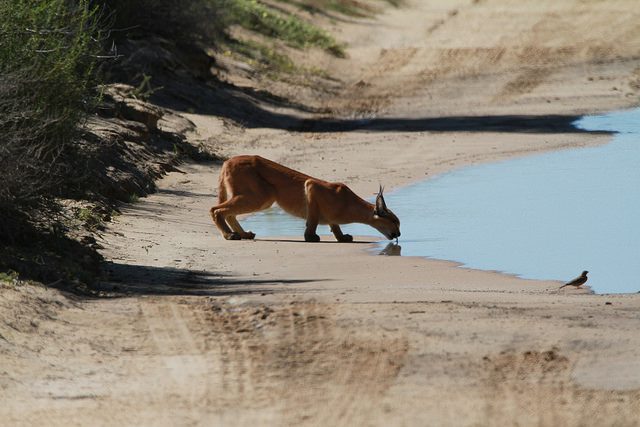
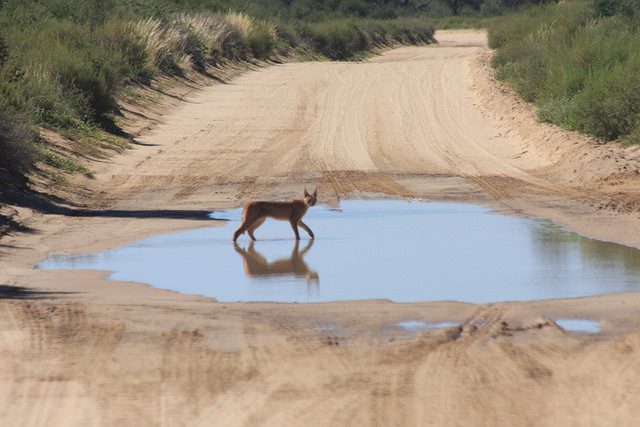
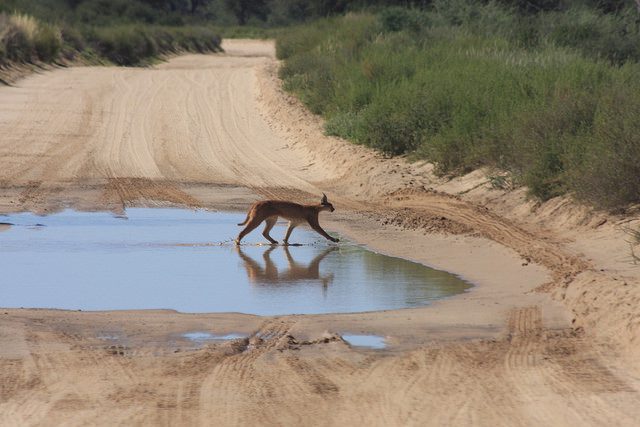
Arrived at Nossob at 4.30pm and checked into No.8.
Went to pool and enjoyed the last rays of sunshine of the day – bliss. All around the pool edges there was evidence of porcupine tracks and quills – very exciting! We were hoping that the lions would be at the hide – but unfortunately not this evening..but we did see the pair of black backed jackals who later frequented camp looking for titbits and a pair of bat eared foxes foraging for food. Some kudu and a lonely springbok also came for a drink. We also photographed a busy mongoose.
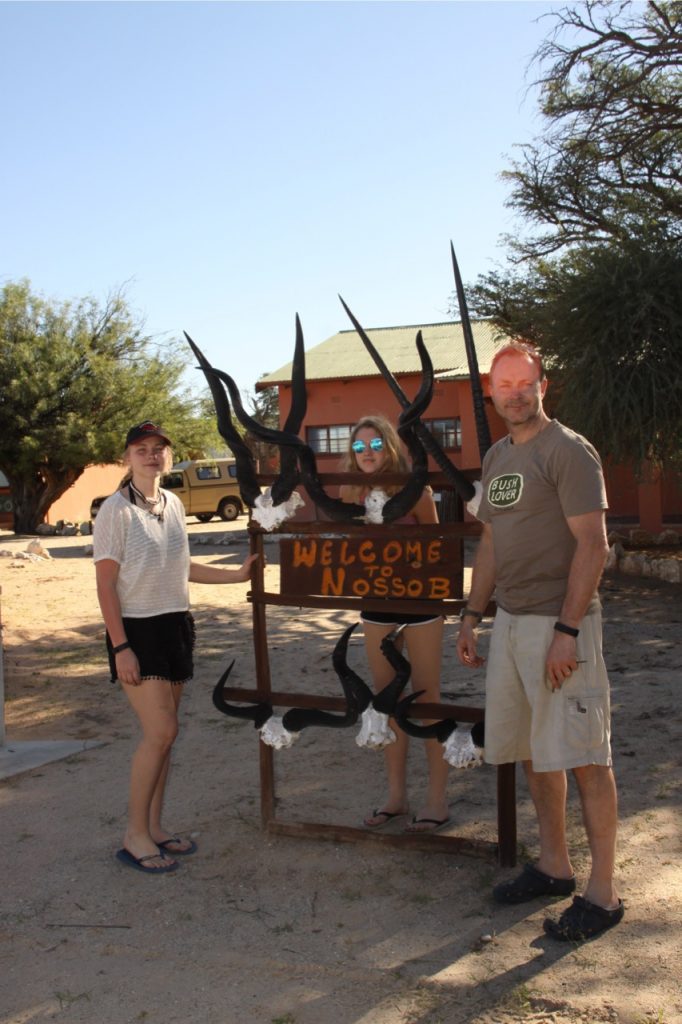
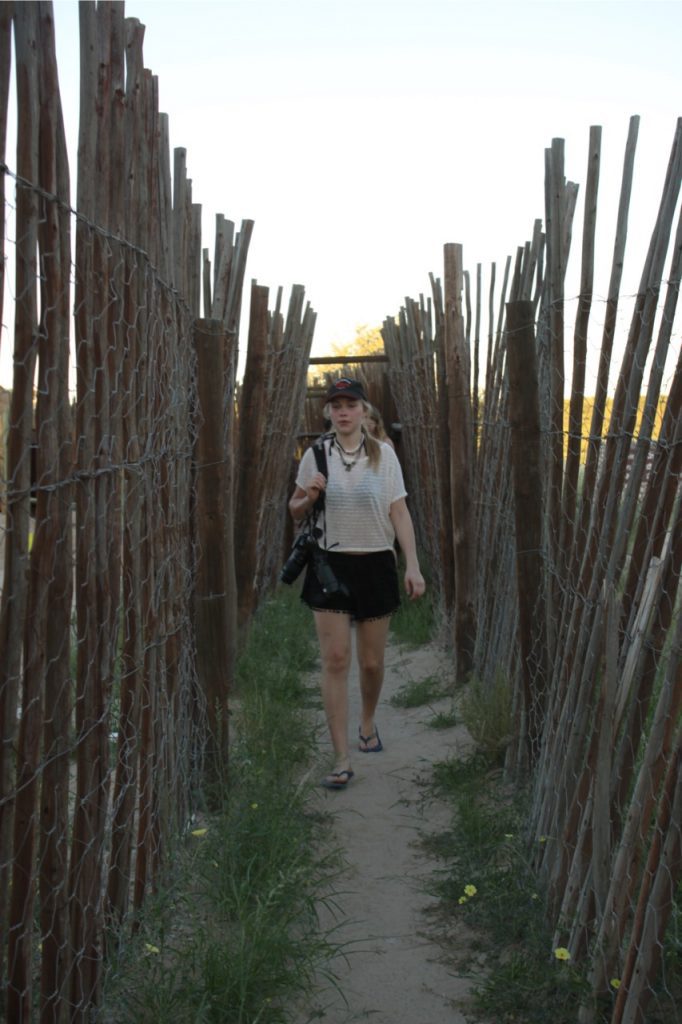
We got the braai going and soon a rib eye steak was sizzling and a full bodied red was doing its job…mmmm… followed by some custard.
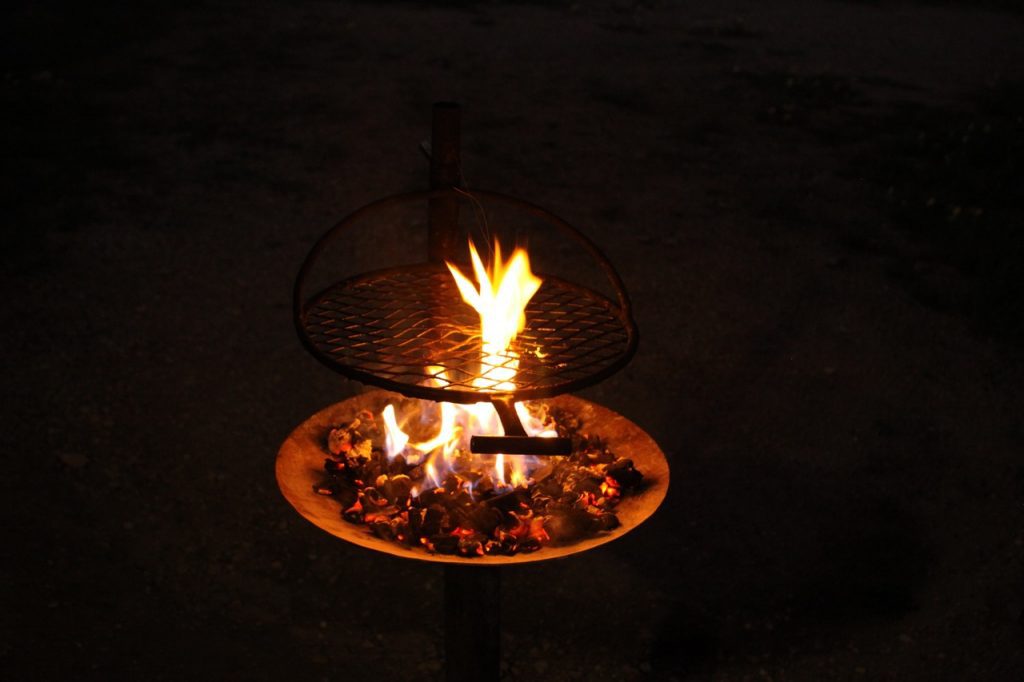
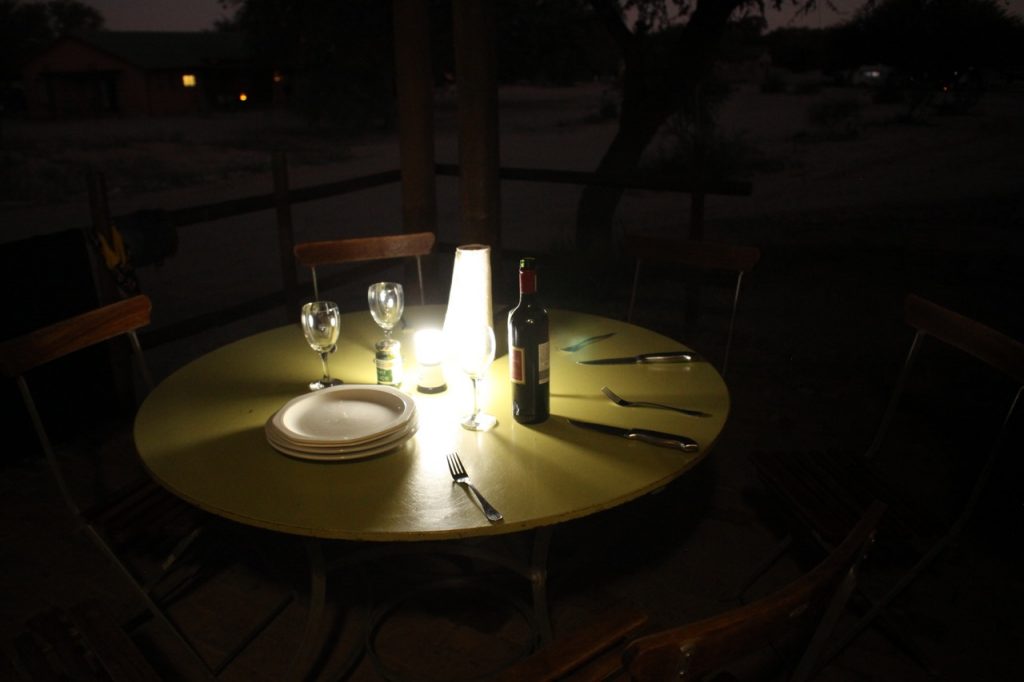
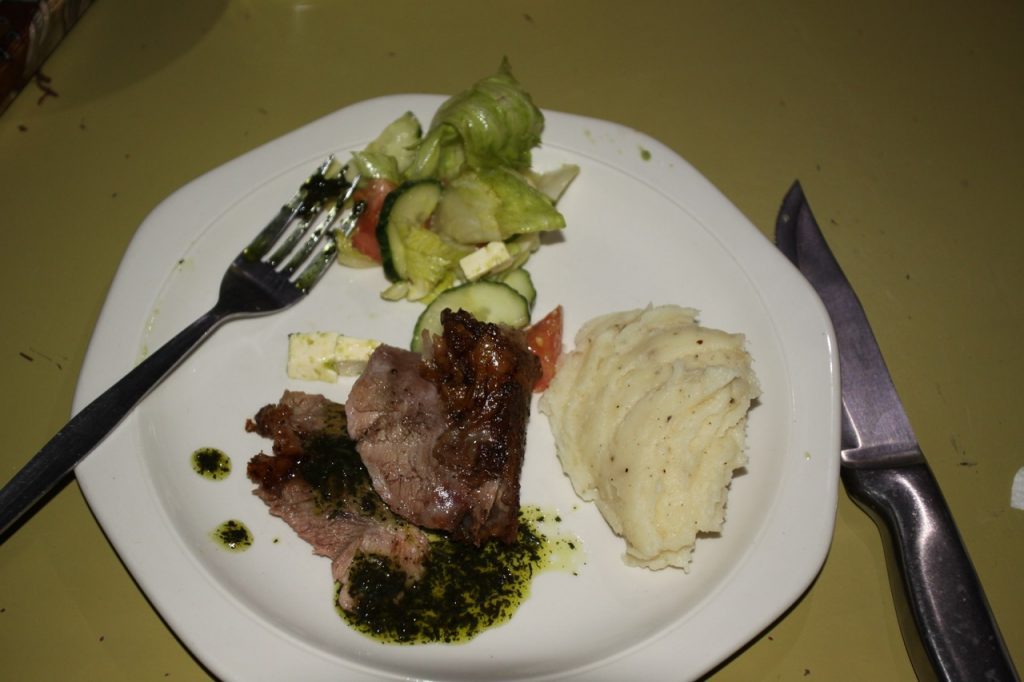
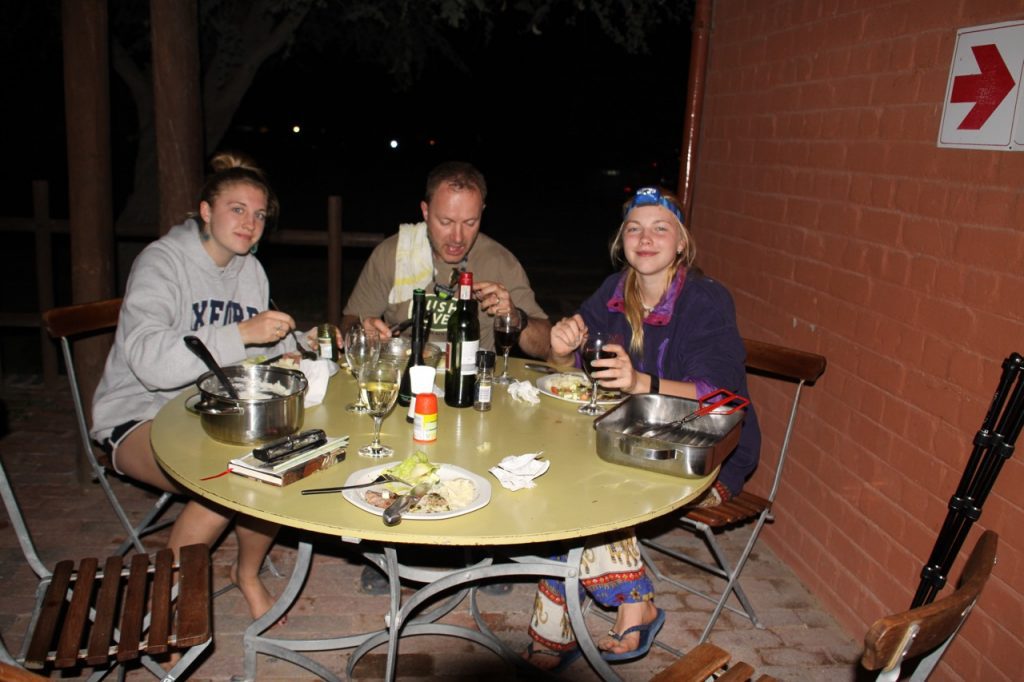
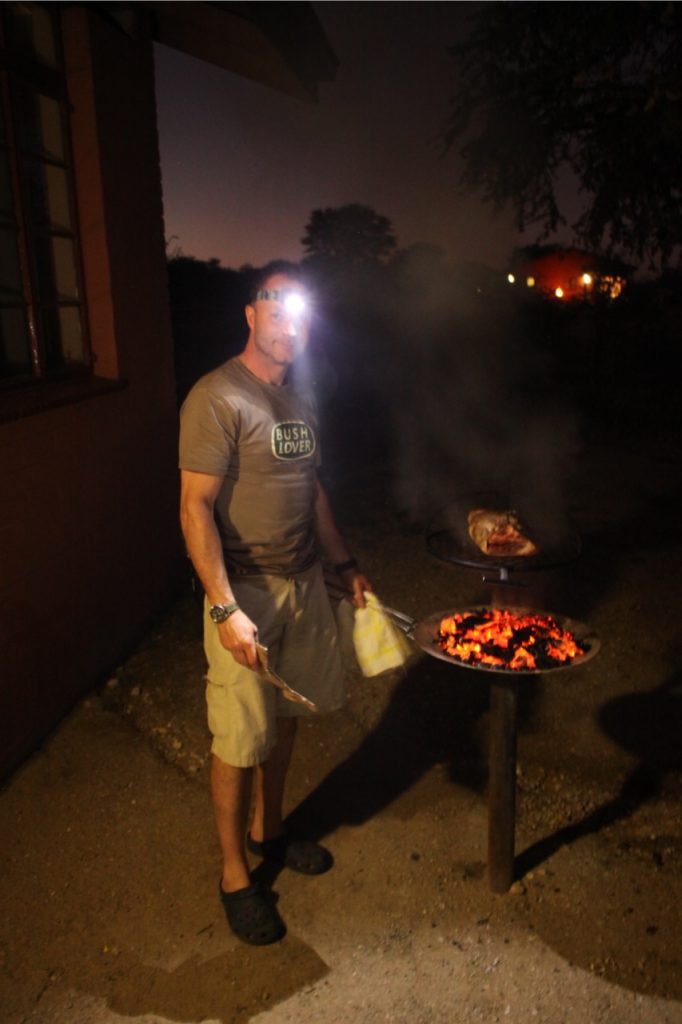
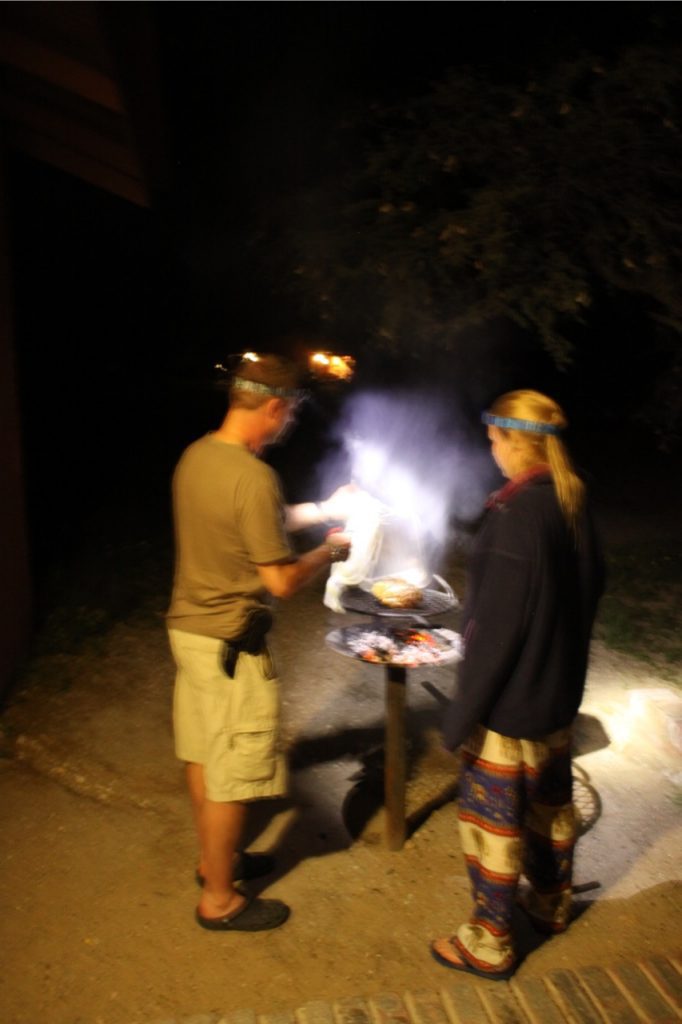
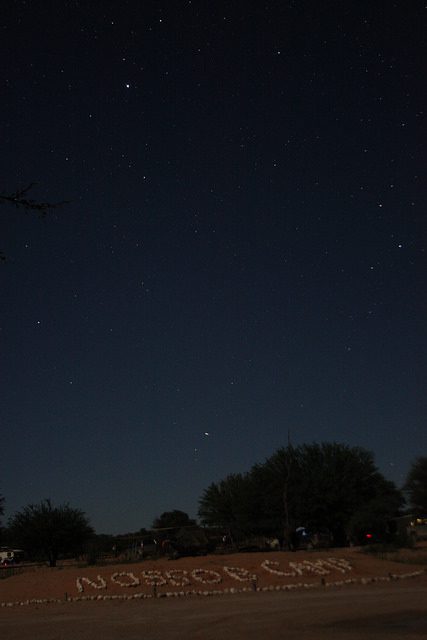
We were ready for the night drive which started at 9pm. It was FREEZING!We saw a Cape Fox, spring hares, 2 wild cats, 2 bat eared foxes and a night jar but not many pics. When we got back we watched this gecko gorge himself on moths – he was a little plump, it has to be said!
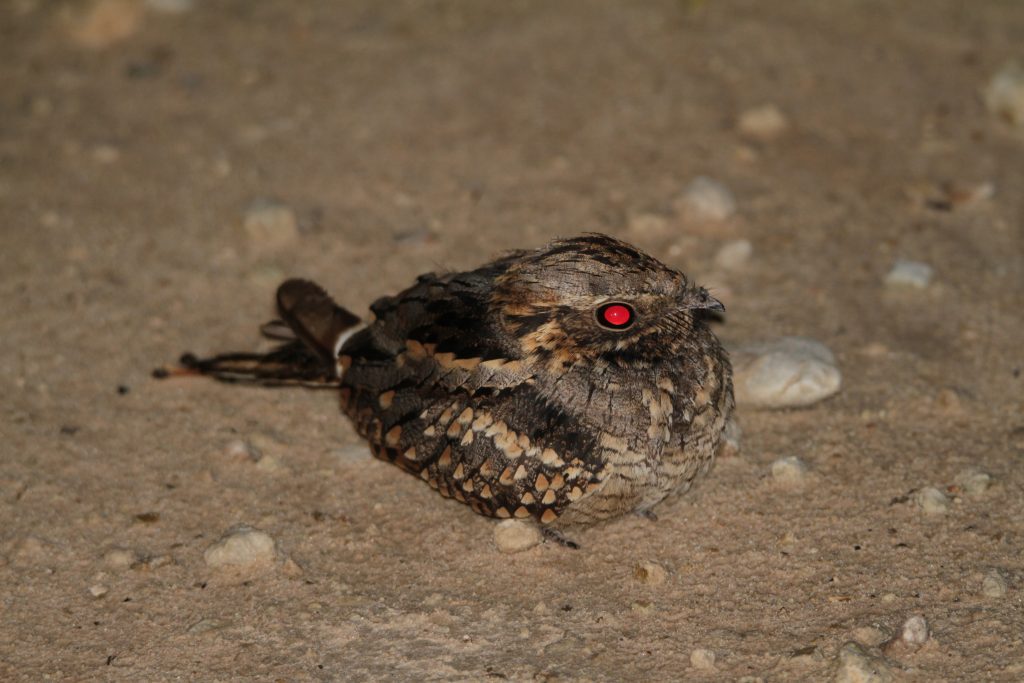
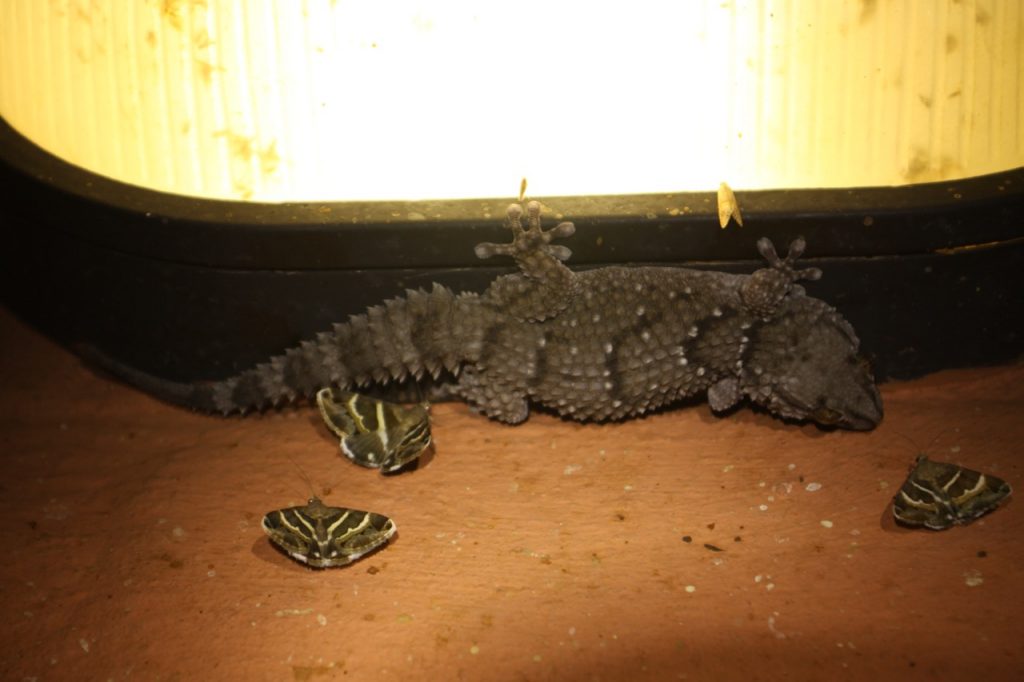
Fell asleep feeling very grateful to be in such a special place and listening to the two camp jackals calling to each other…. another well spent glorious day in Africa.
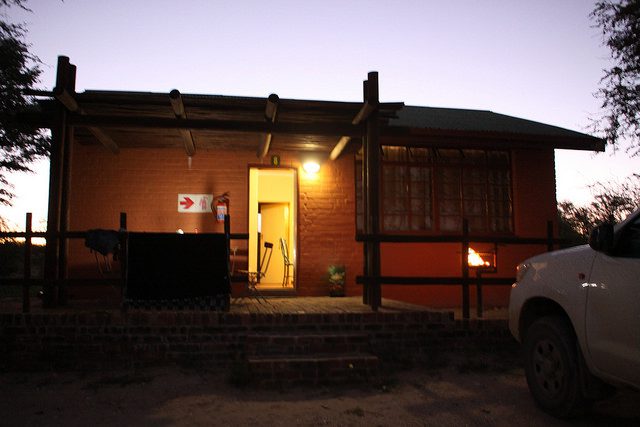
Day 4: Sunday 27 March 2016 – Nossob to Unions End and back to Nossob
Has anyone noticed how the salinity of the water in Kgalagadi almost feels oily when you shower?! Quite strange. Of course the animals in Kgalagadi are adapted to the salinity of the water but every few years for reasons that remain unknown great herds of Eland migrate south from Botswana. This sporadic and infrequent migration makes it impossible to forecast when this phenomena will take place. Our night drive guide told us that the last events were in 2007 and then in June 2012, which was on an even greater scale than experienced before. The thirsty eland rapidly depleted the boreholes and water troughs were trampled under their heavy hooves which caused water to run into the sand and reservoirs to run dry. Our guide implied that these creatures were perhaps not accustomed to the higher levels of salt in the water heading south and that this may have been the cause for the numerous carcasses which littered the area during the migration. No one knows when to expect the next migration but it may be soon.
We were out the gate at 06h45am. VERY fresh lion prints on the damp sand – followed prints on the road, then disappearing into the bush…and then back onto the road with no other vehicle tracks over them.
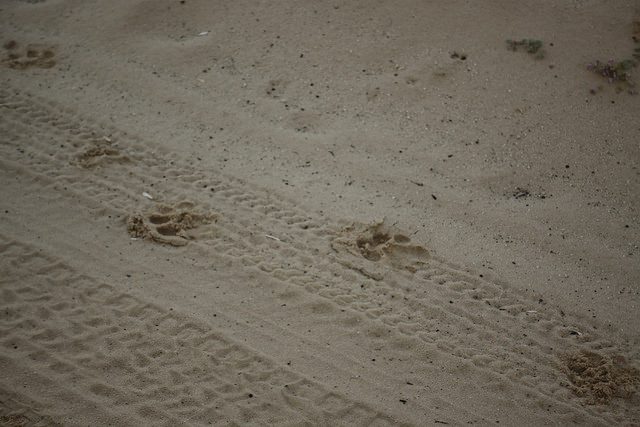
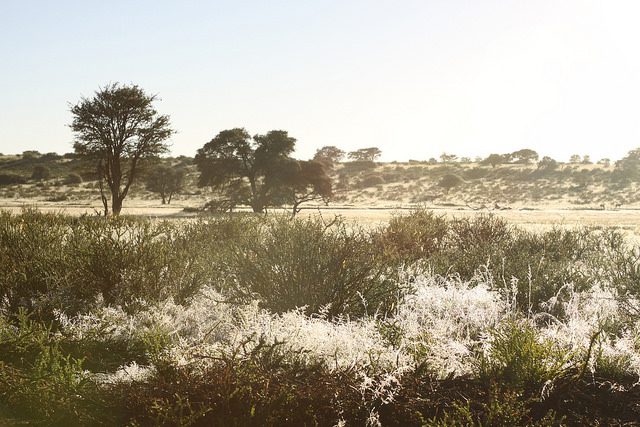
What a stunning morning with the sunlight reflected in the dew…heaven on earth. Hoorah! We FOUND them! Magnificent, handsome young blonde maned male and a female.
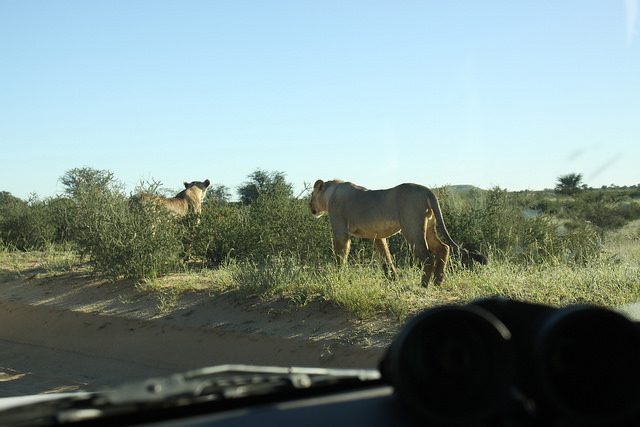
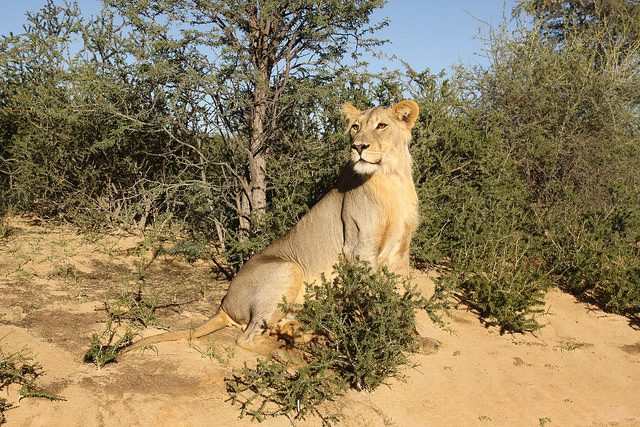
We came up behind one vehicle twho had their engine off and were enjoying the sighting. We stopped behind them and another bakkie came up behind us and overtook our two cars. We were these lions for a good 40mins. They sat and relaxed for a few minutes and then got up and walked on an elevated position right next to our cars.I nervously closed my window at one point as the young male was eye to eye with me and I could definitely have reached out and stoked him, he was so close. Both lions very relaxed. Beautiful orange eyes. He was just curious… An absolutely amazing encounter for all three of us as they provided excellent photographic opportunities for all three of our cars – obliging by remaining close and posing beautifully in the morning light.
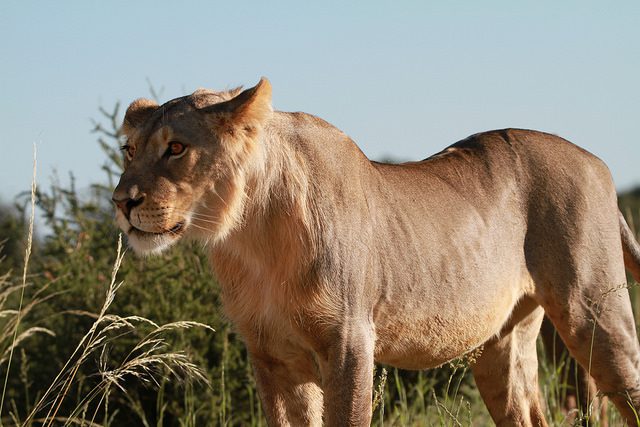
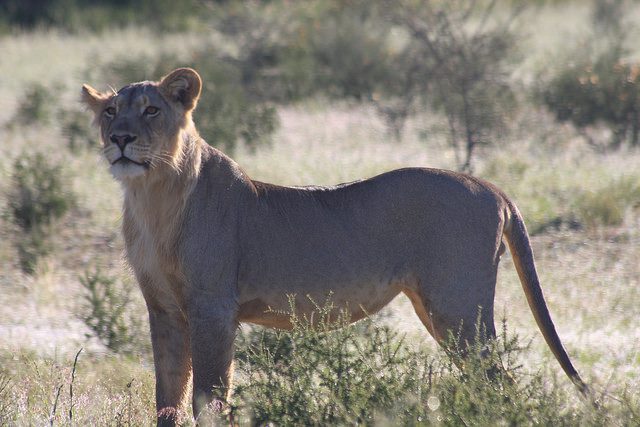
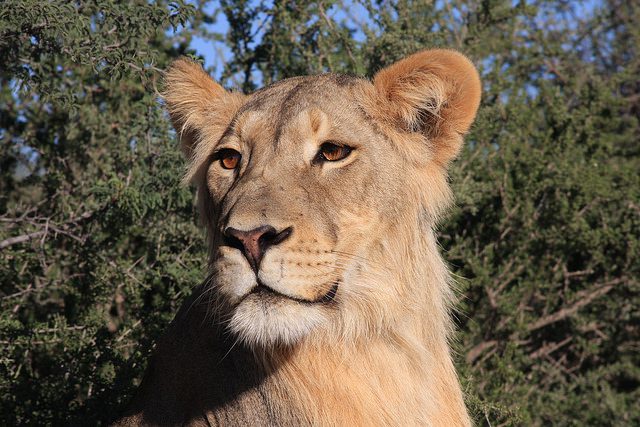
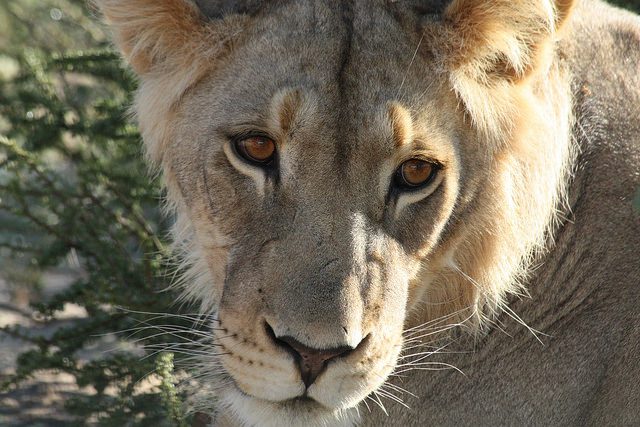
At this point several other cars were approaching in the distance behind us so we overtook the bakkie in front of us and left them all to enjoy the rest of the sighting. Less than a Km further Charlotte quietly pointed out another 6 lions strolling purposefully adjacent to the road in the bush!! What a start to the morning!!
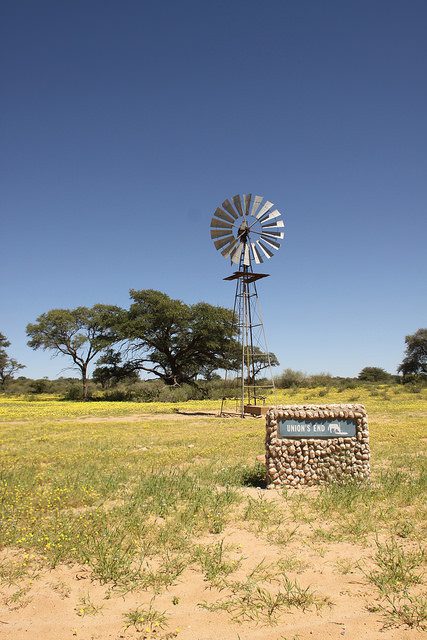
I felt quite sad at the sign of the times with the old windmills which are being dismantled ready for the solar panels – the tall windmills at each waterhole in the park have always represented the Kalahari to me…a sign of the times and history in motion…. I know that these solar panels make excellent use of the abundance of sunshine so freely available in the desert and which relieves the pressure of heavy maintenance required for maintenance of windmills… but there is nothing quite like nostalgia. Union End borehole and windmill looked spectacular amongst the wildflowers.
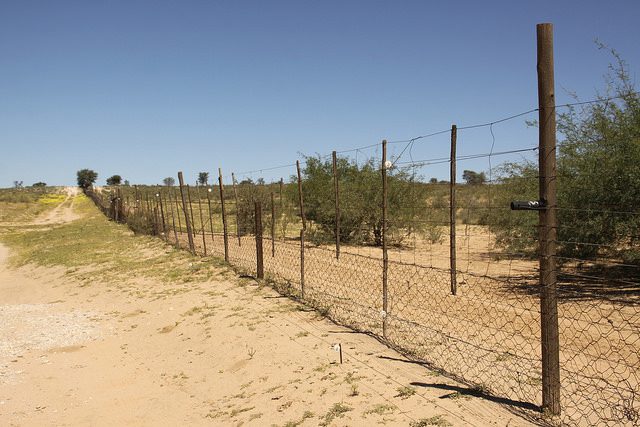
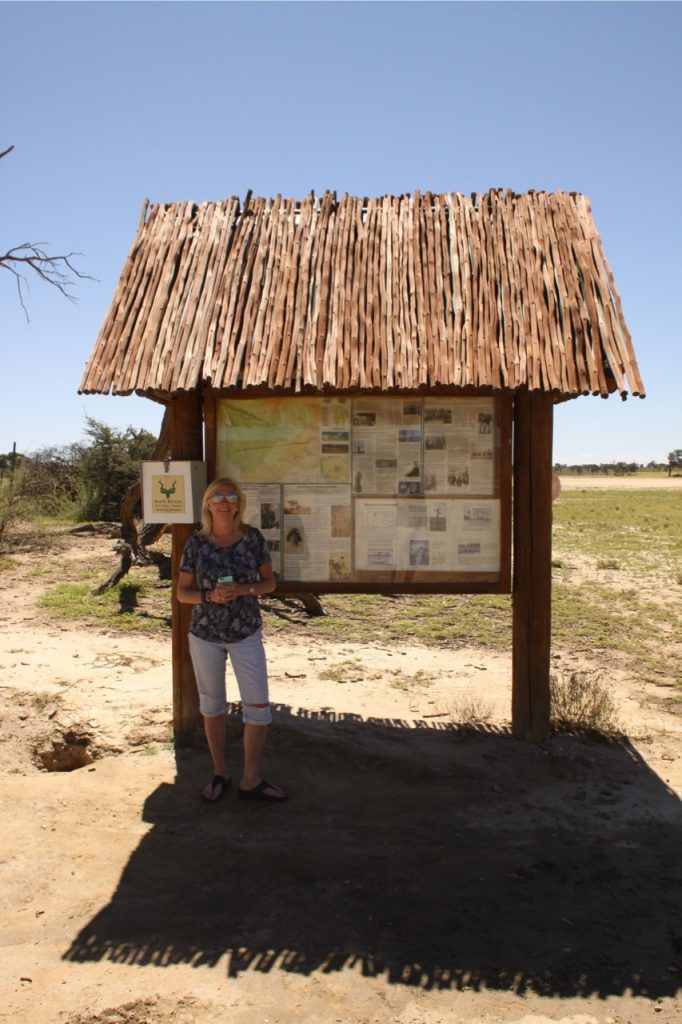
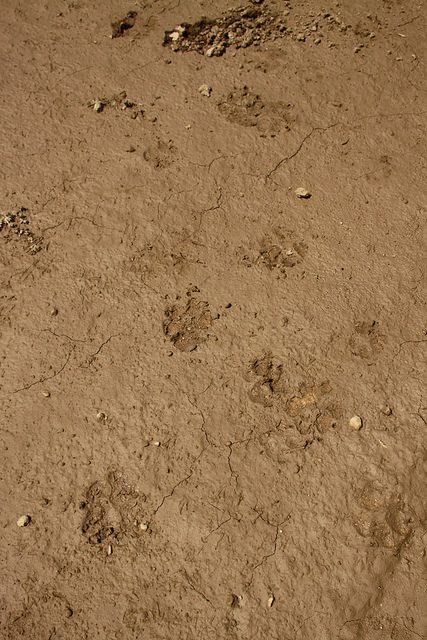
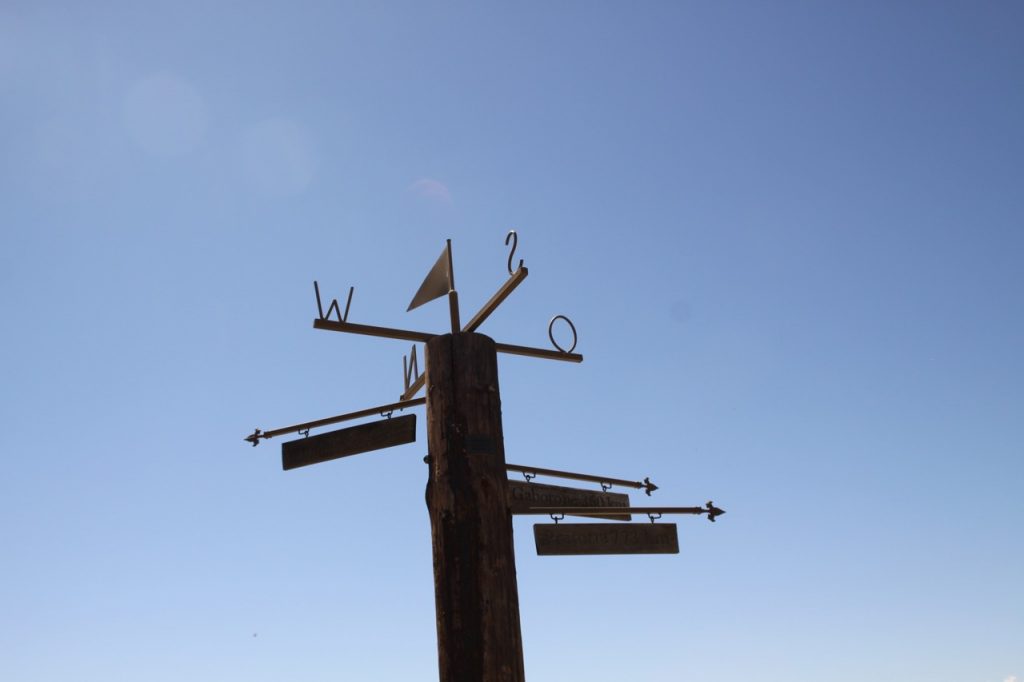
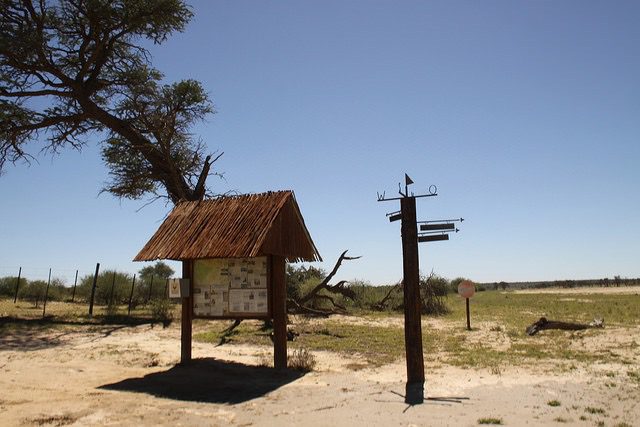
When we arrived at Unions End itself it was incredible to think that we were at the corner of South Africa, Namibia and Botswana. A muddy patch next to the board depicting the history yielded VERY fresh hyena spoor. Our car must have just frightened it off a few minutes ago as it was already very hot and the tracks were wet so the mud had not had the opportunity to dry yet.
Tiny jackal carrying carrions as big as he is!
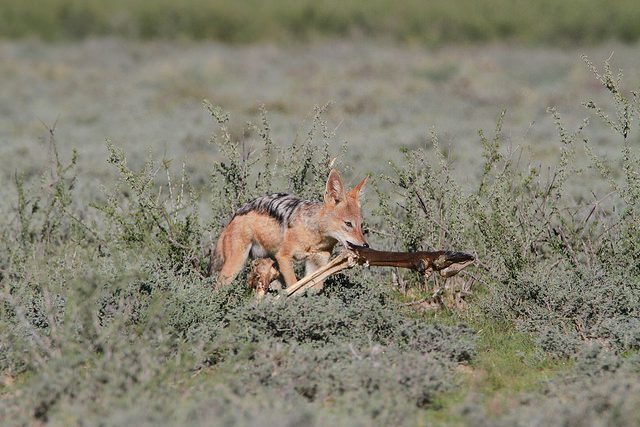
We set up our picnic lunch braai at the sport between Unions End and Geinab. Steak cooked perfectly and absolutely delicious. We had a very noisy crow watching our every move from the tree above us. He made the most incredible array of noises! I understood from a guide that he must have been a young crow as they make the gargling noises that we could hear which eventually turn into adult vocalisations. In between gargles and burps he ran through long sequences of cawing – quite entertaining!
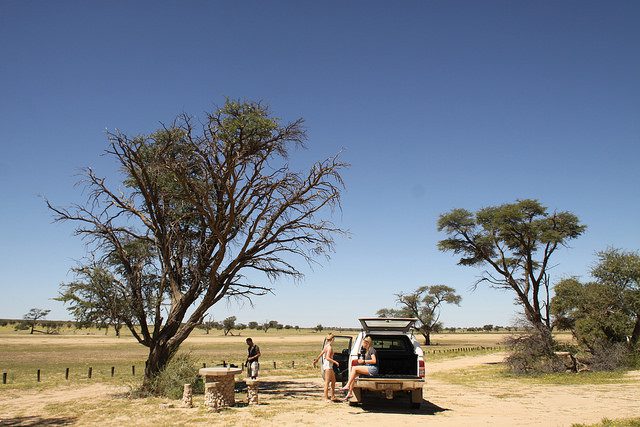
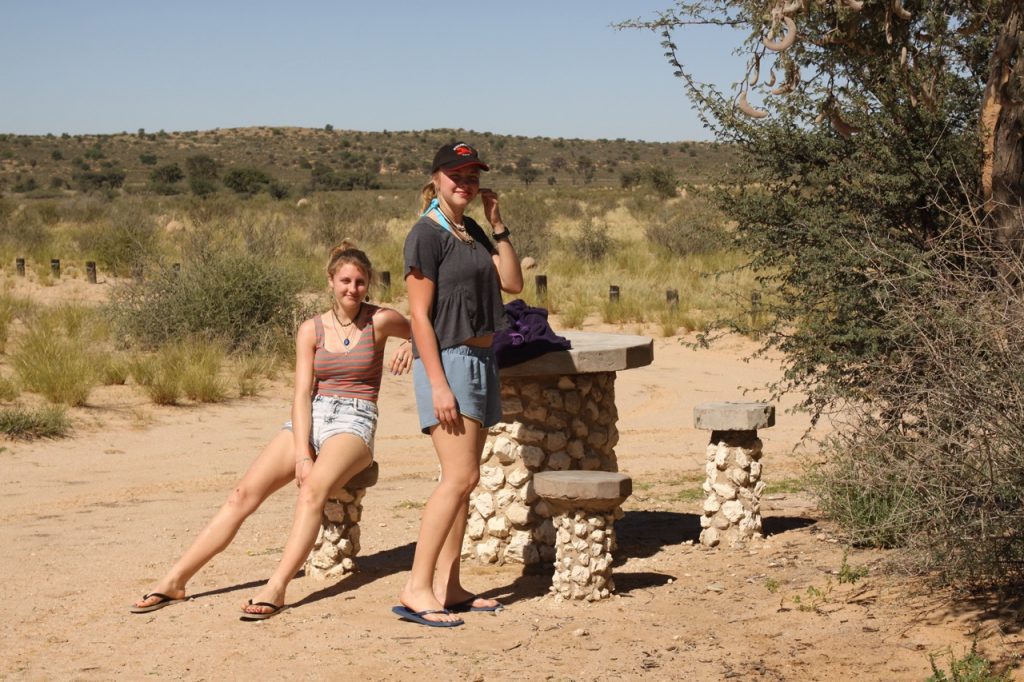
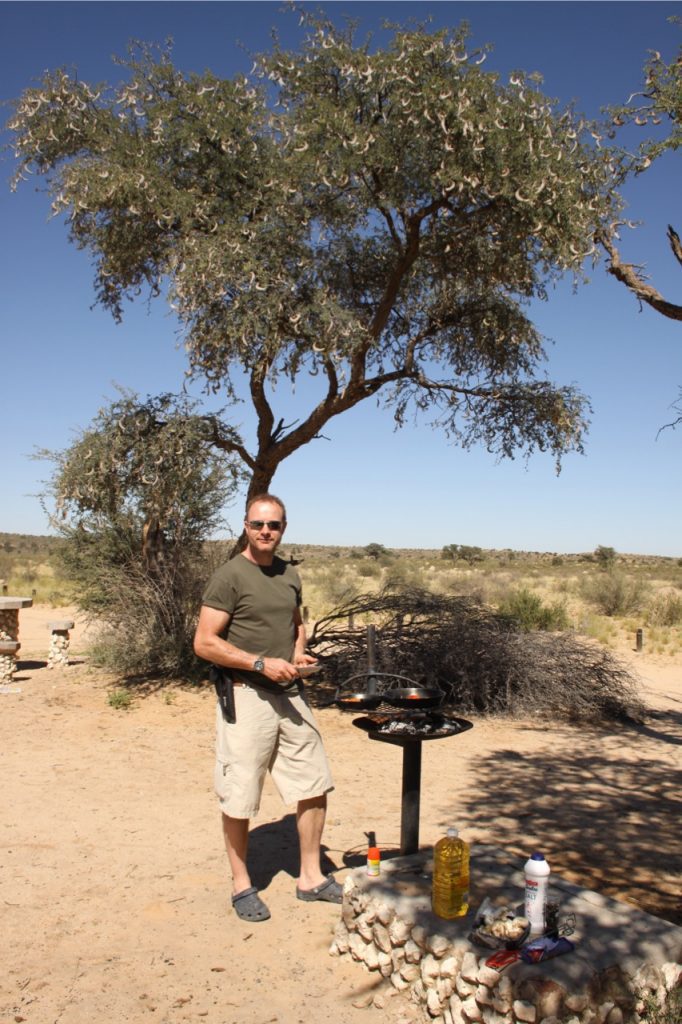
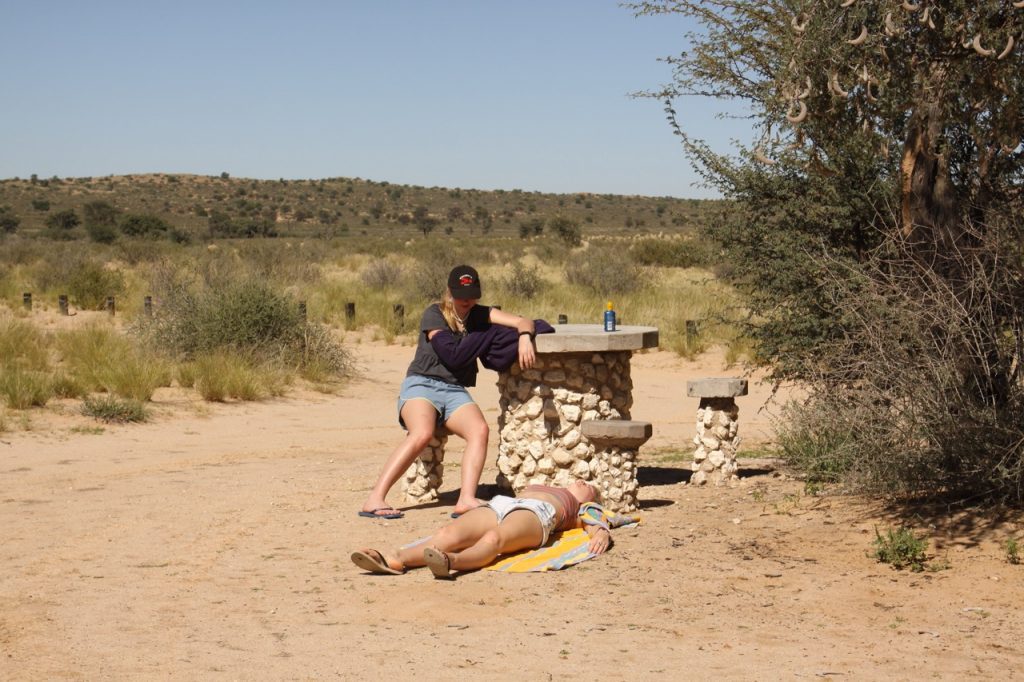
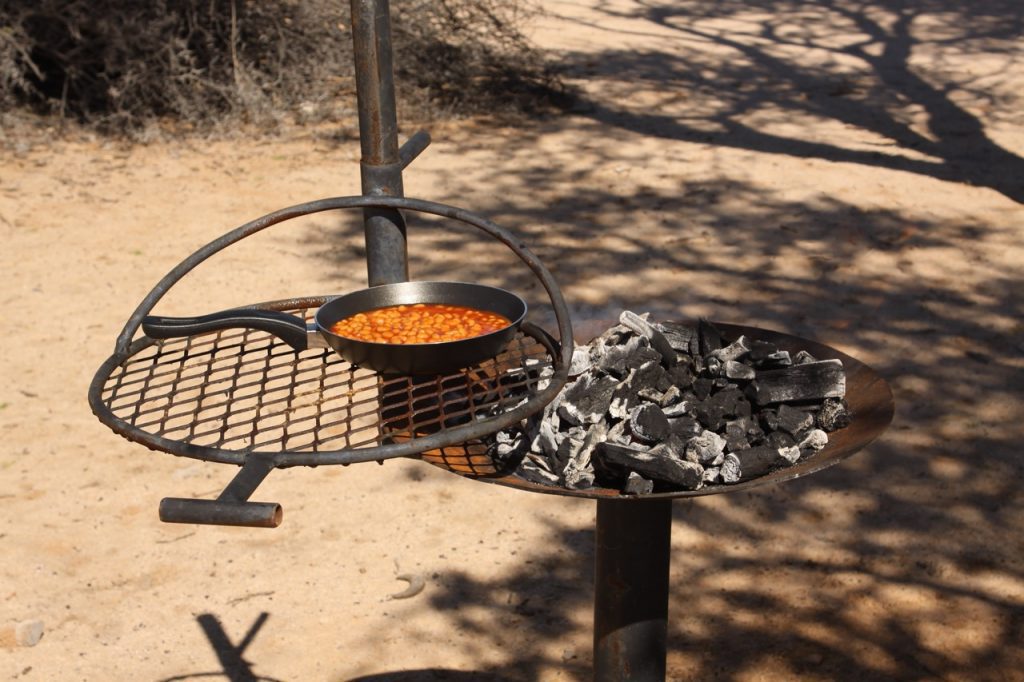
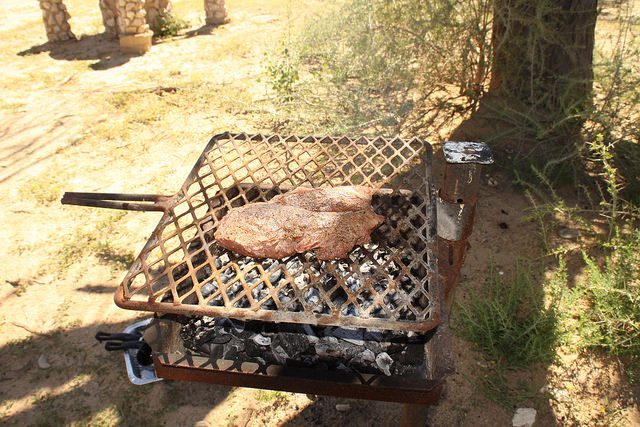
A few interesting stops along the way to watch a few squabbles and ruts…
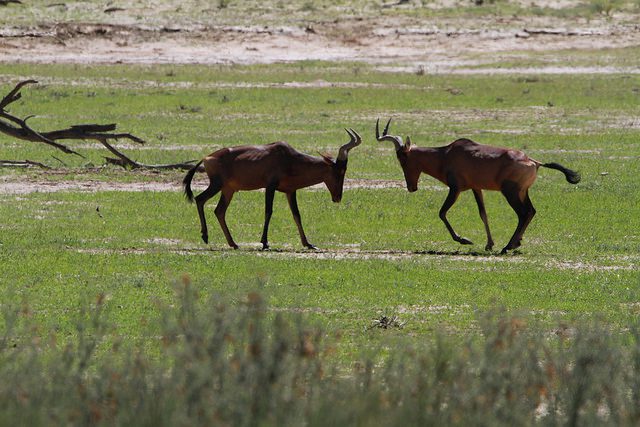
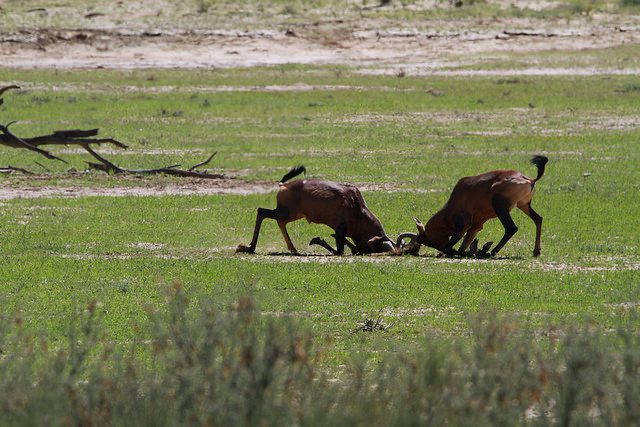
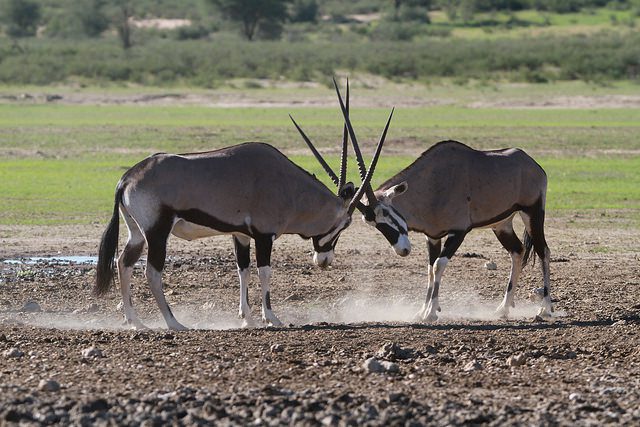
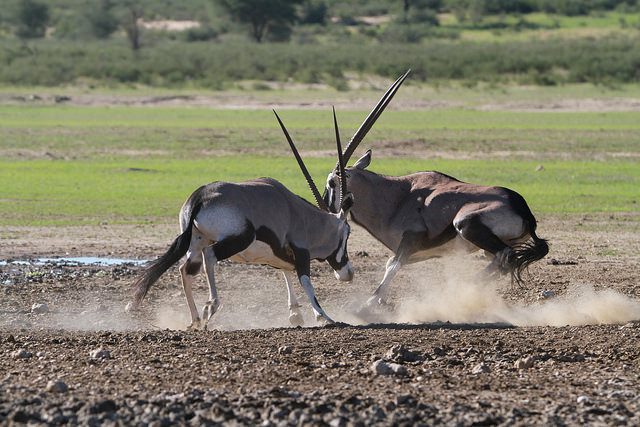
A few special bird sightings starting with a vulture, bateleur in a nest and a pale chanting goshawk against a perfect azure blue sky
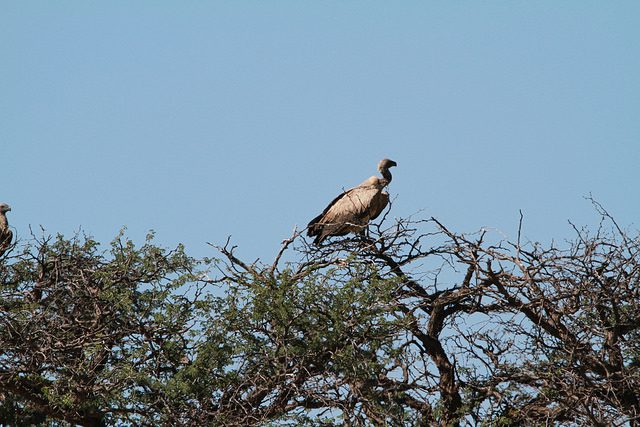
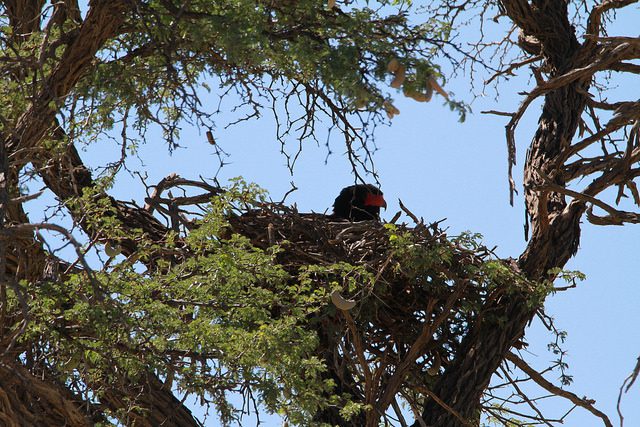
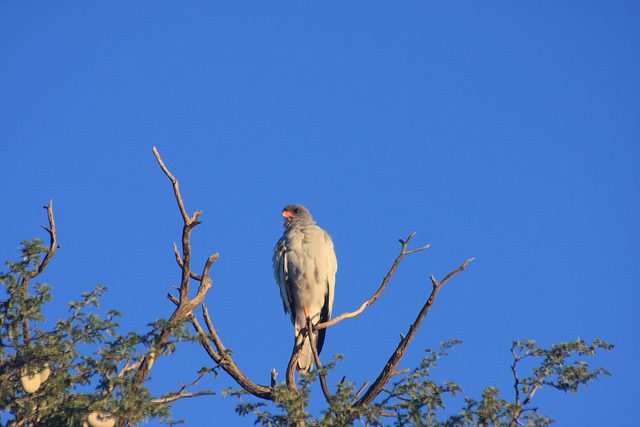
Skeletons on the side of the road emphasises the arid nature of the park. The termite mounds are always fascinating. We spotted a dead snake. As we headed back to Nossob Caitlyn spotted some fresh tracks on the sandy road – brown hyena? Surely not…YES! Not a great photo – but still – yippee – another wish list tick! Well done Caitlyn!
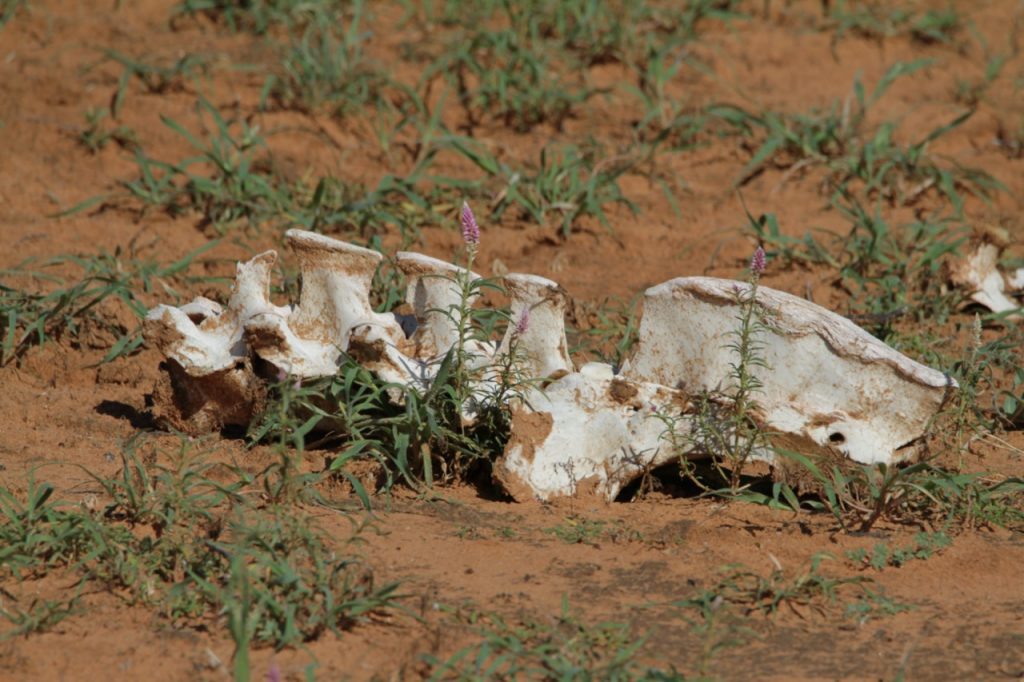
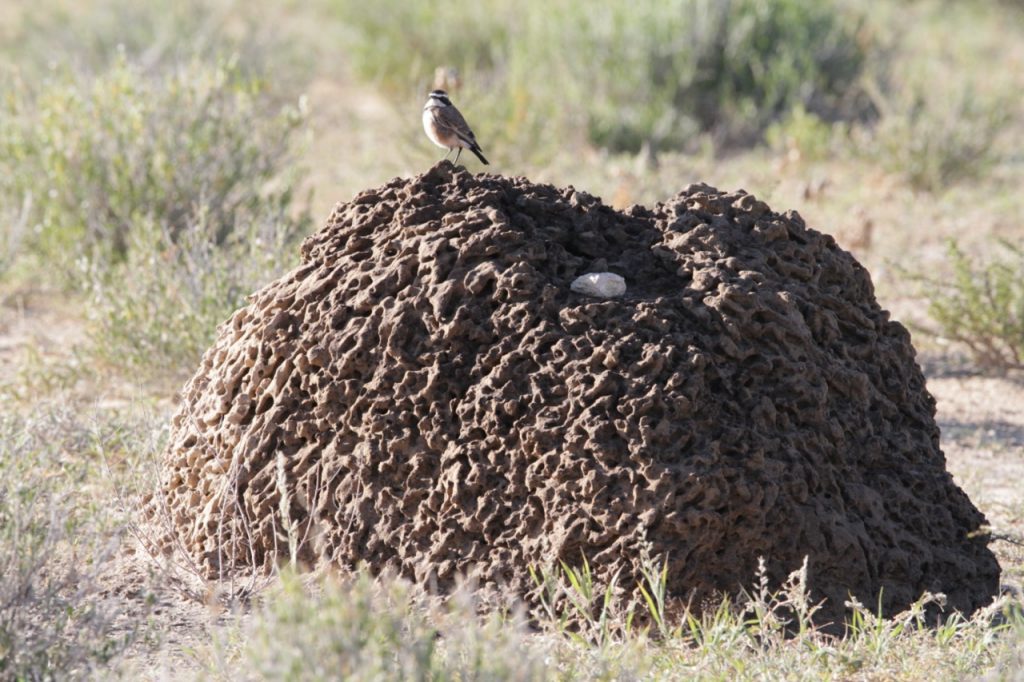
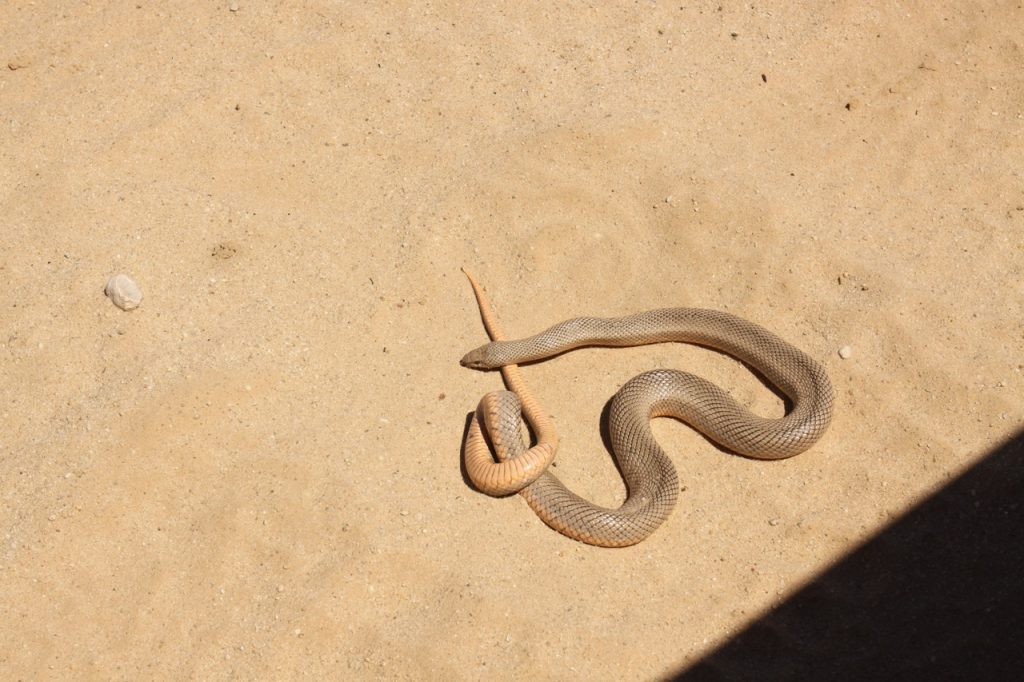
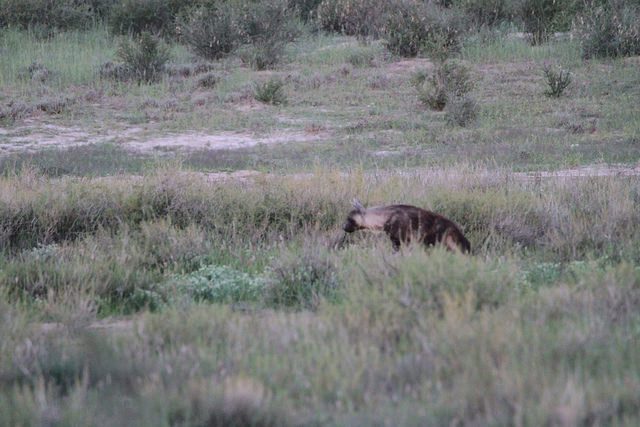
Unfortunately he turned in the opposite direction to Nossob and we were already in danger of missing the gate closing time and we had already been driving a full 12 hours! The sky was incredible purple and orange as sunset – perfect. Collected our fresh bread and roosterkoek from the shop and braai’d delicious spare ribs with mash and salad. We had our usual evening visit from the two camp jackal looking hopeful for some leftovers – sadly there was none to be had as we had gulped it all down hungrily! Hide fairly quiet again but two bat eared foxes entertained us.
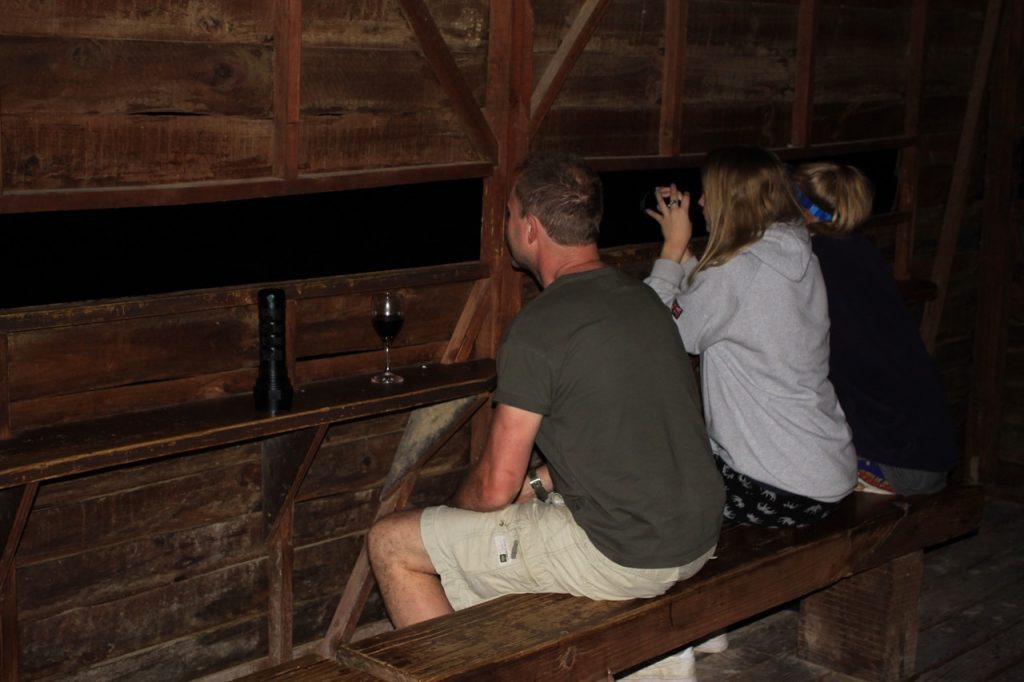
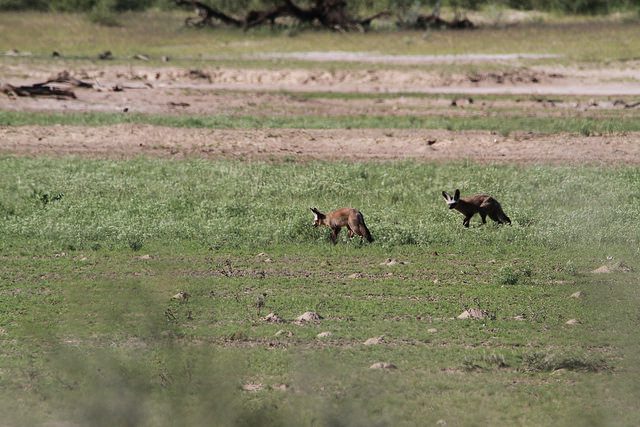
DAY 5: Monday 28 March 2016 – Nossob to Mata Mata
Headed off at 6.45am. Several jackal on morning duty. Found some lovely fresh lion tracks, but unfortunately going in opposite direction…ditto for hyena. Fairly quiet with usual sightings of kori bustard, lone springbok.
These hartebeest were sticking their heads quite deep into the sand on the road – perhaps they were licking for minerals and salts or getting rid of parasites as we saw several of them with sand all over their muzzles? Has anyone else witnessed this?
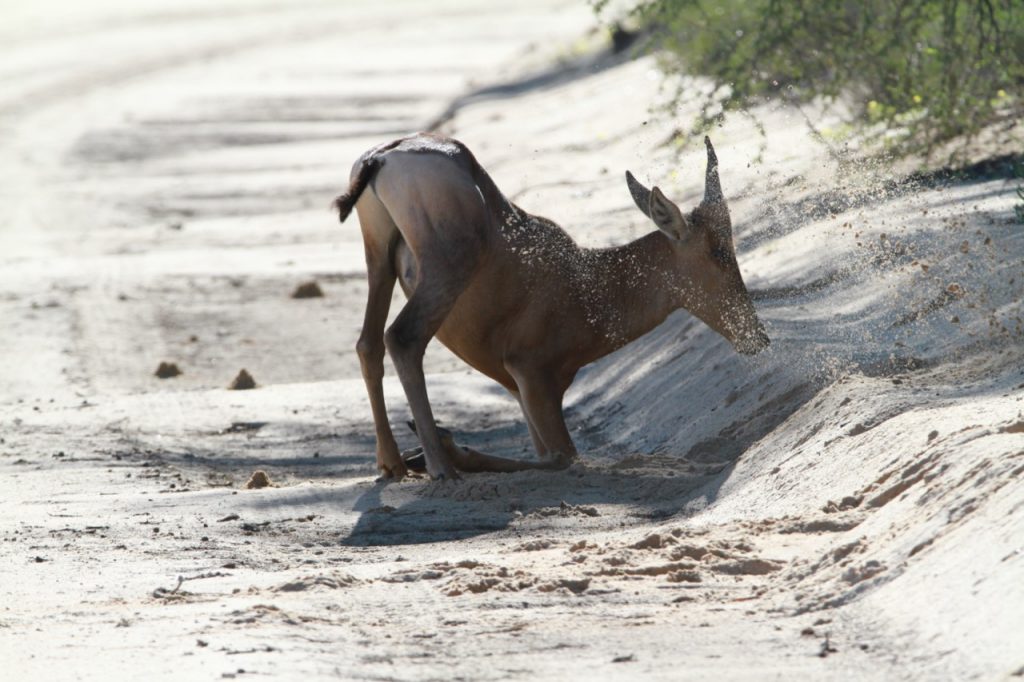
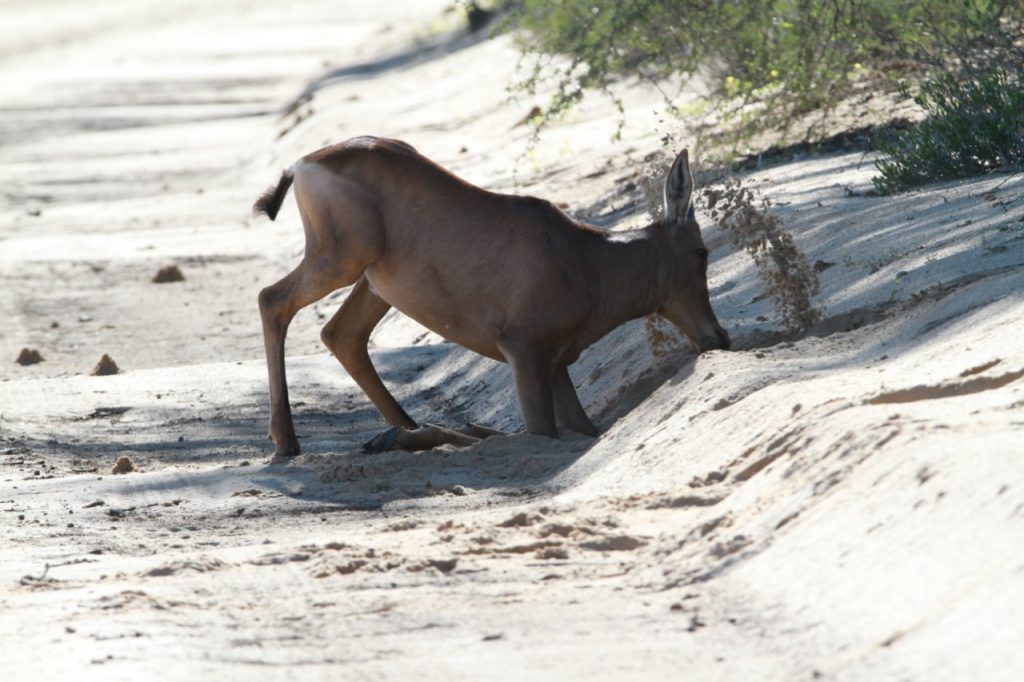
We felt compelled to return to Dikbaardskolk for breakfast to enjoy the peaceful atmosphere enhanced by the stunning wildflowers and sweet perfumed air accompanied to the call of the ring necked dove, ‘work harder, work harder / drink lager, drink lager’ humming in the background – pure bliss. We enjoyed a delicious breakfast with eggs and cooked bananas and we were ready for the day!
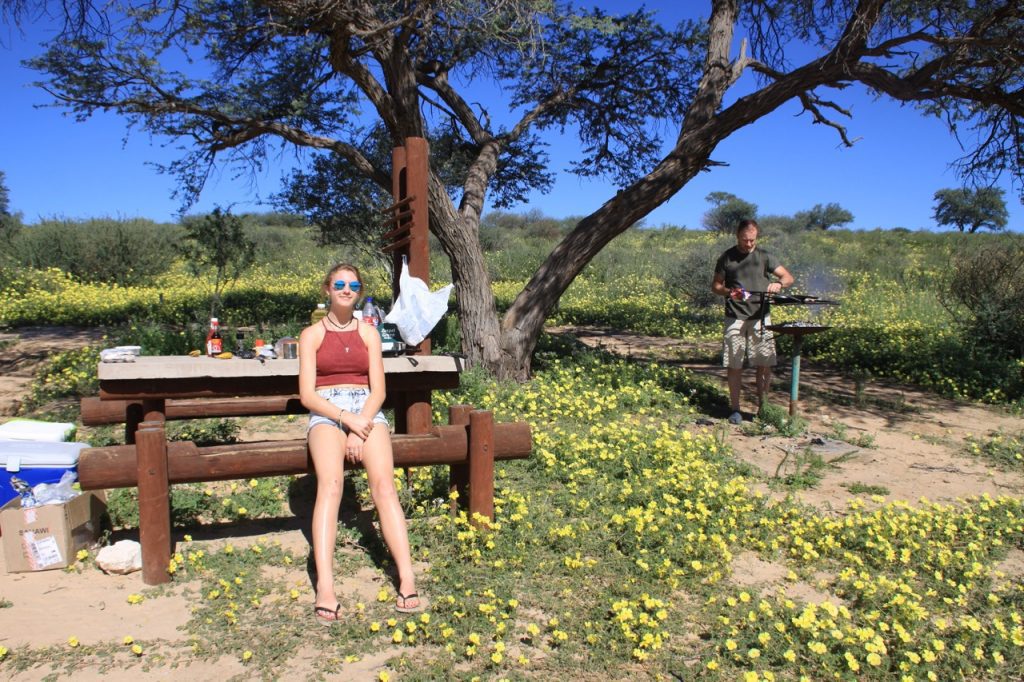
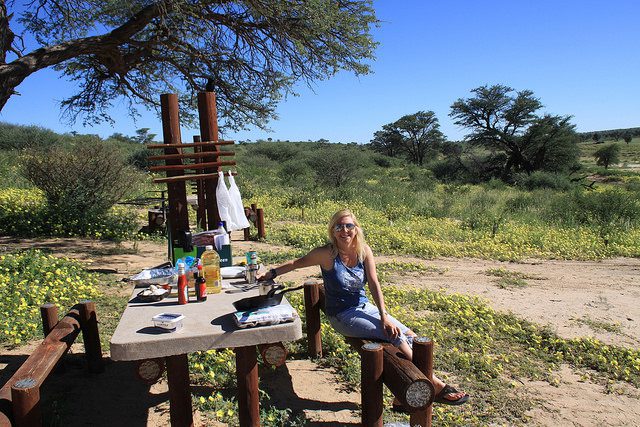
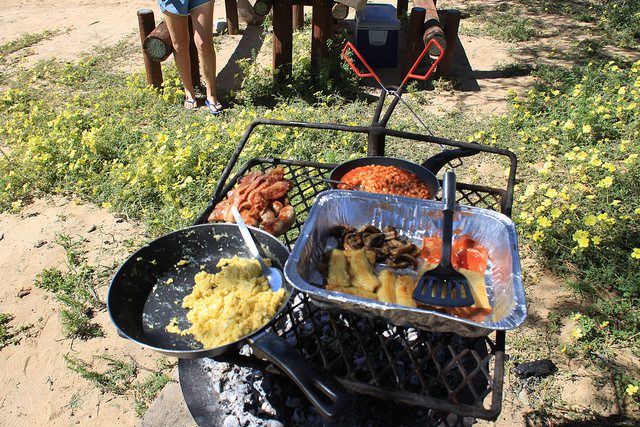
Caitlyn was very patient and managed to capture some great shots of the hyperactive crimson breasted shrikes who were flitting between picnic spots This whistling rate was busily gathering food to carry back to the burrows which can apparently help with thermo regulating. Caitlyn found these tracks on the road, which gives you an idea how big the lion was that passed by during the night!!
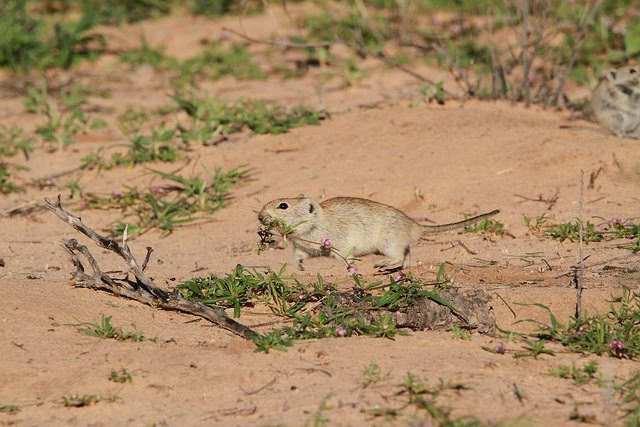
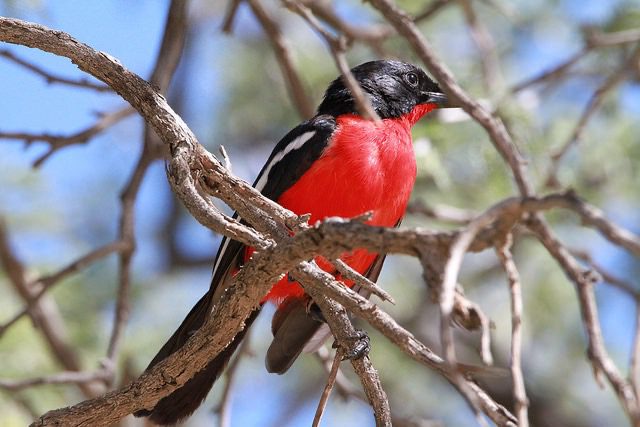
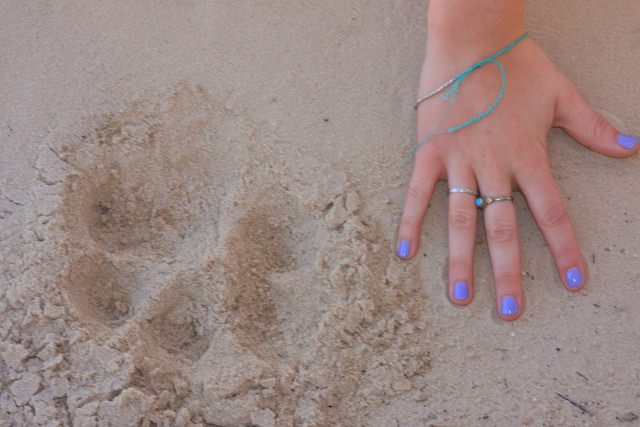
We decided to take the Dune Road to Mata Mata. We came upon a few obstacles on the way! We came upon a few obstacles on the way!
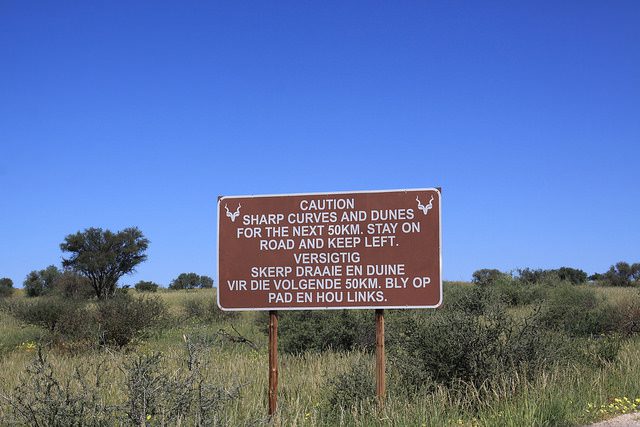
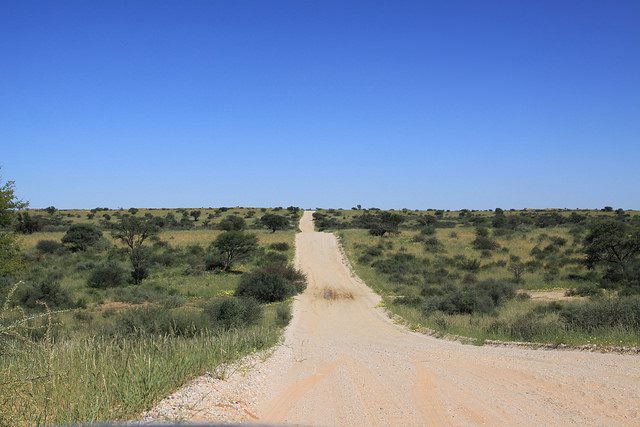
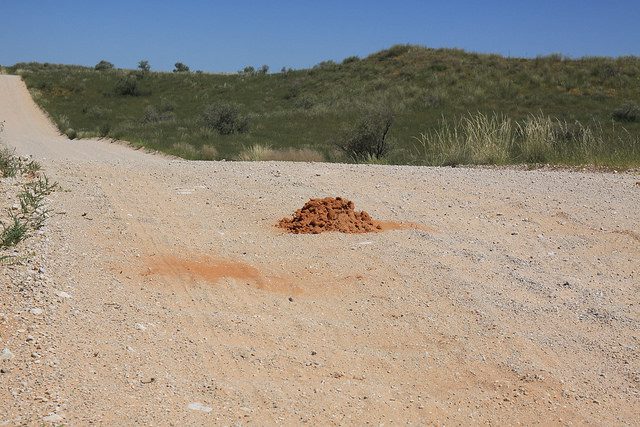
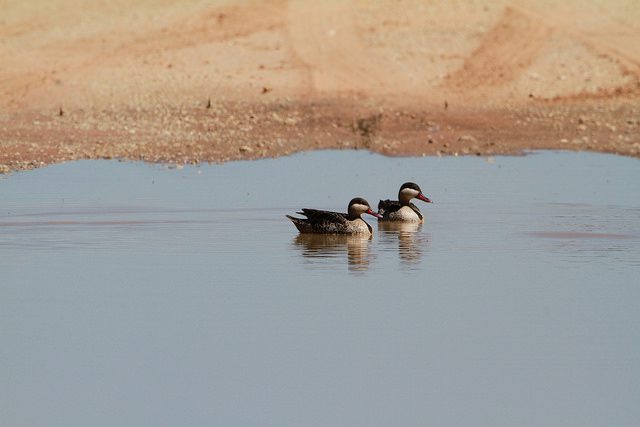
This little steenbok was so busy enjoying the minerals on the road that he refused to leave and we waited patiently for him to get his fill! This gemsbok and flock of ostriches did however not wish to hang around when they saw us approaching on the road. Plenty of butterflies enjoying the sunshine, wildflowers and water puddles.
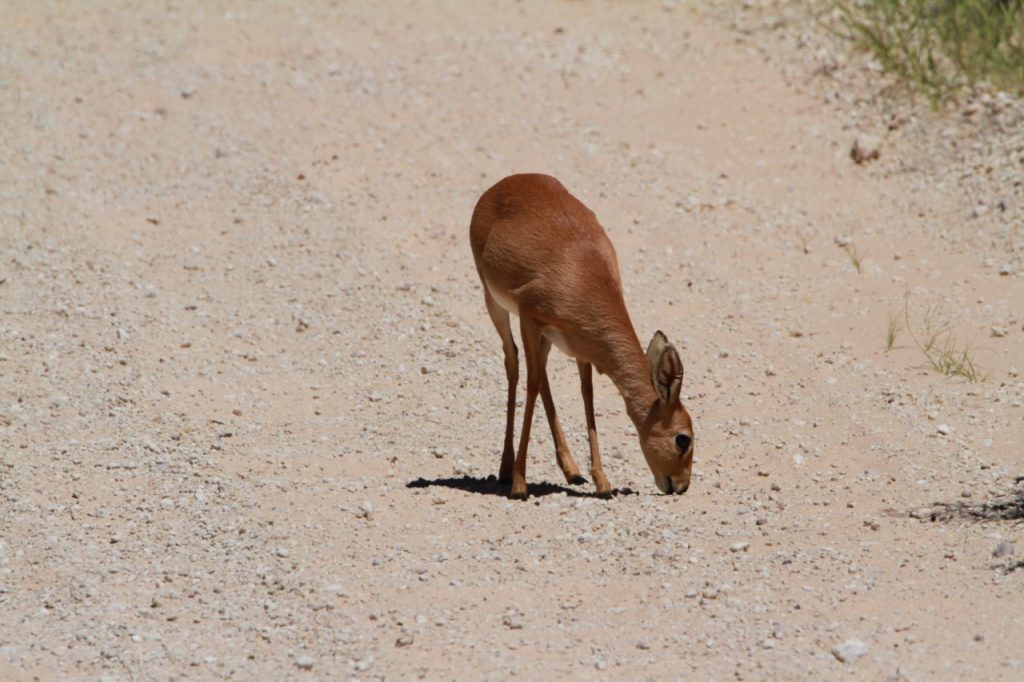
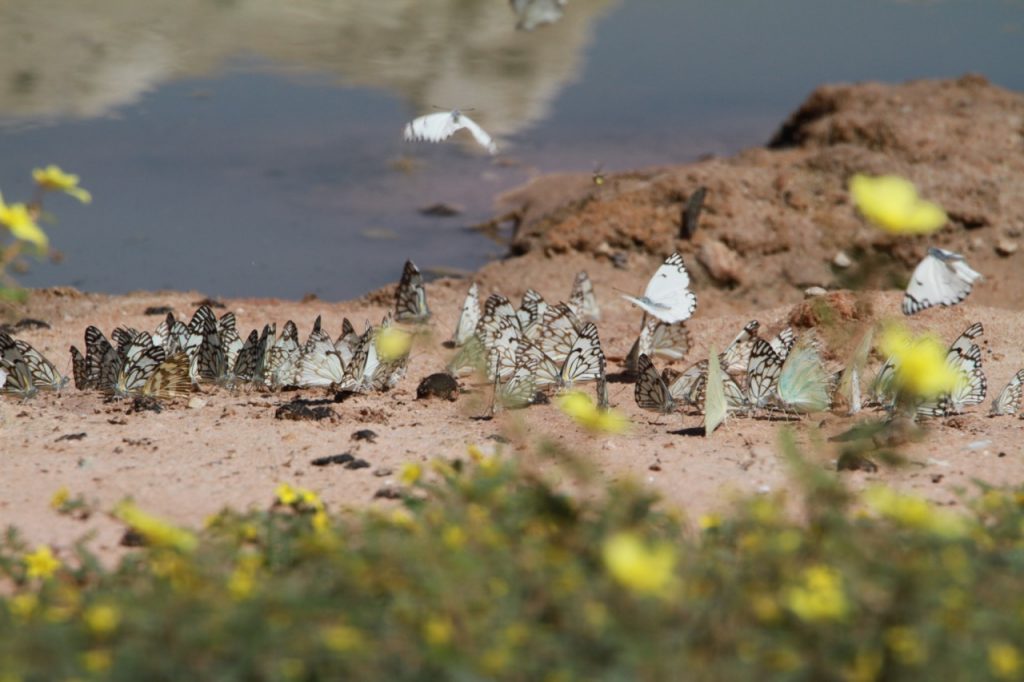
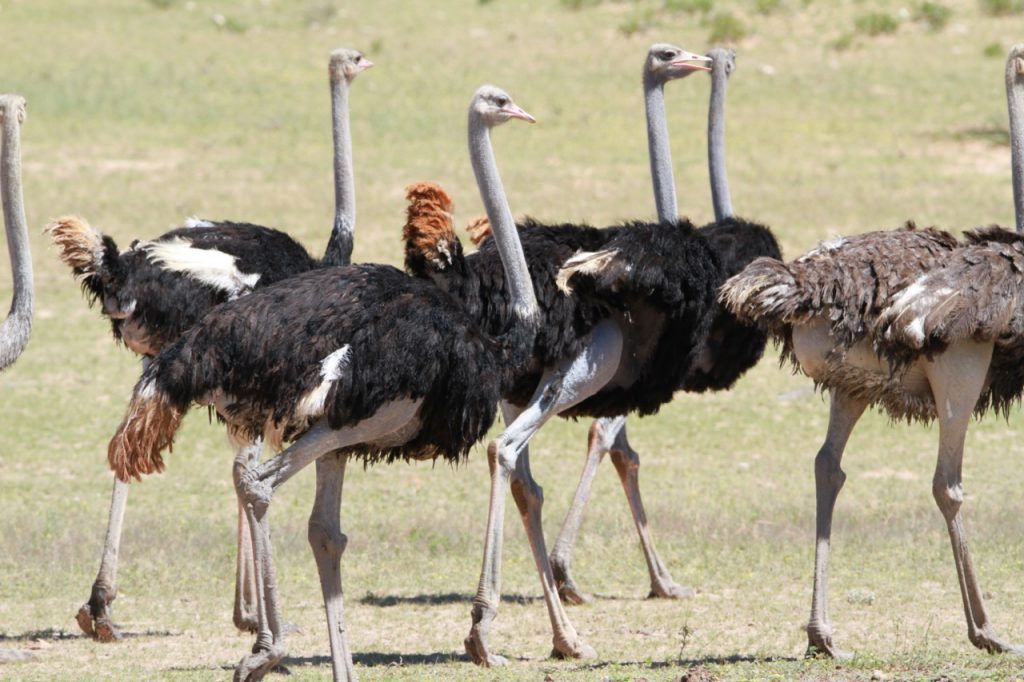
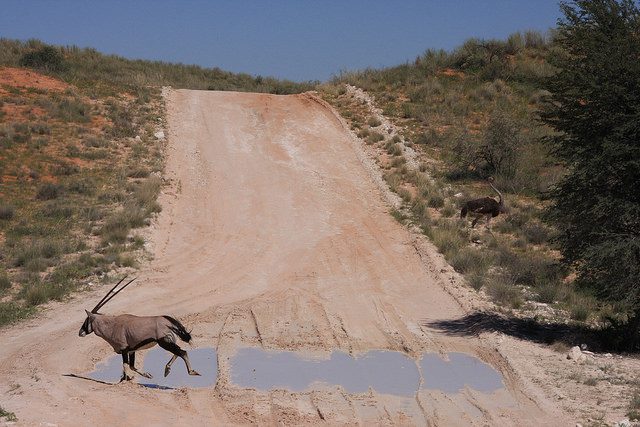
There was a wide variety of birds at Vaalpan.
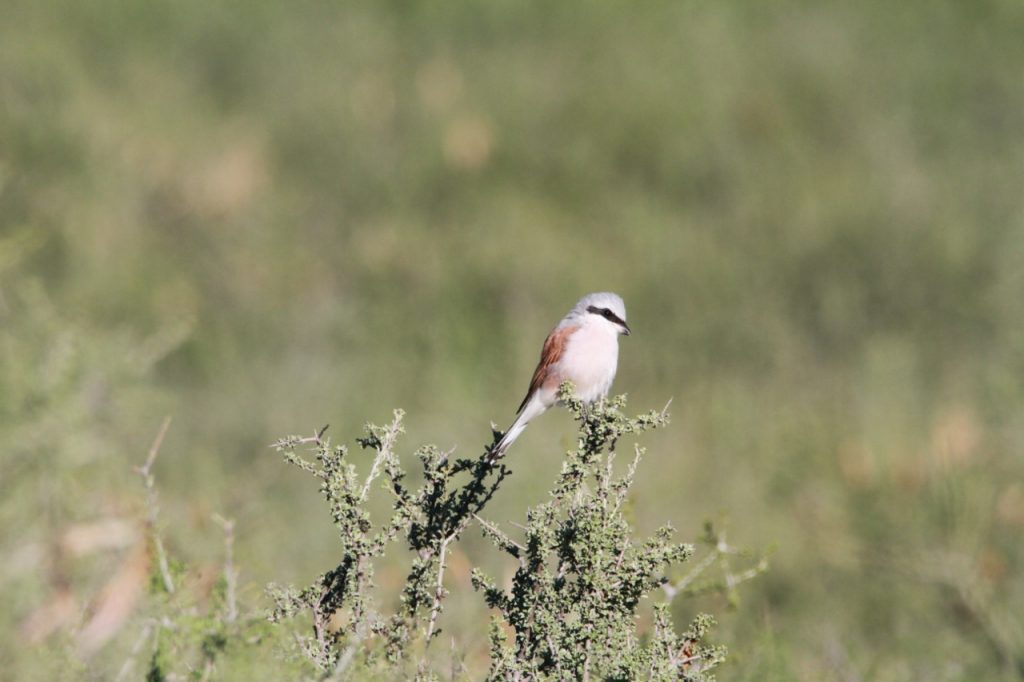
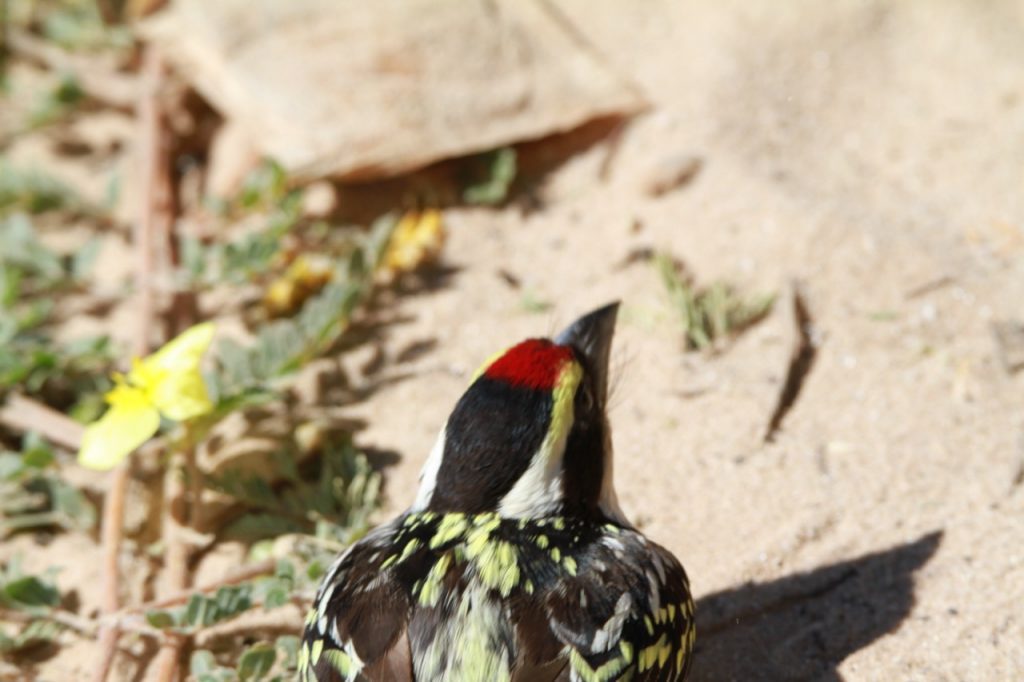
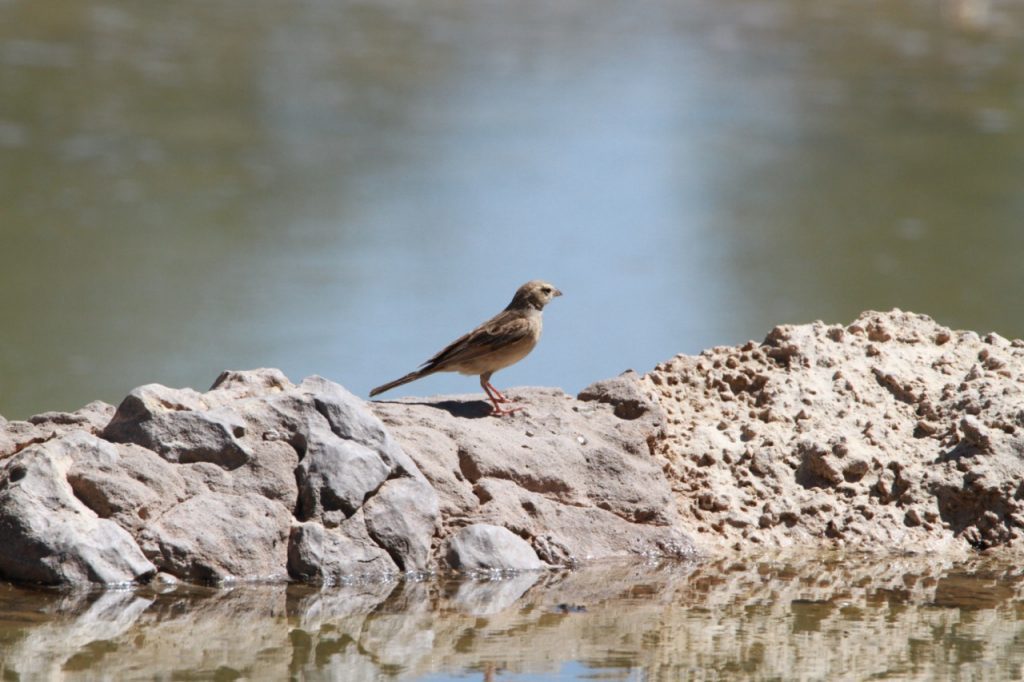
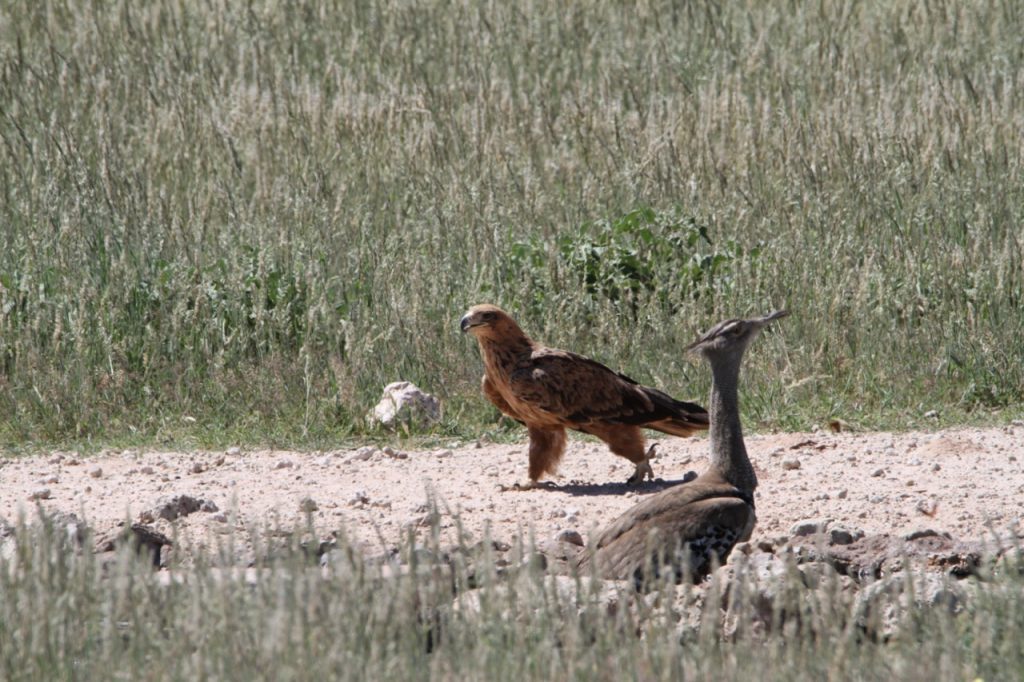
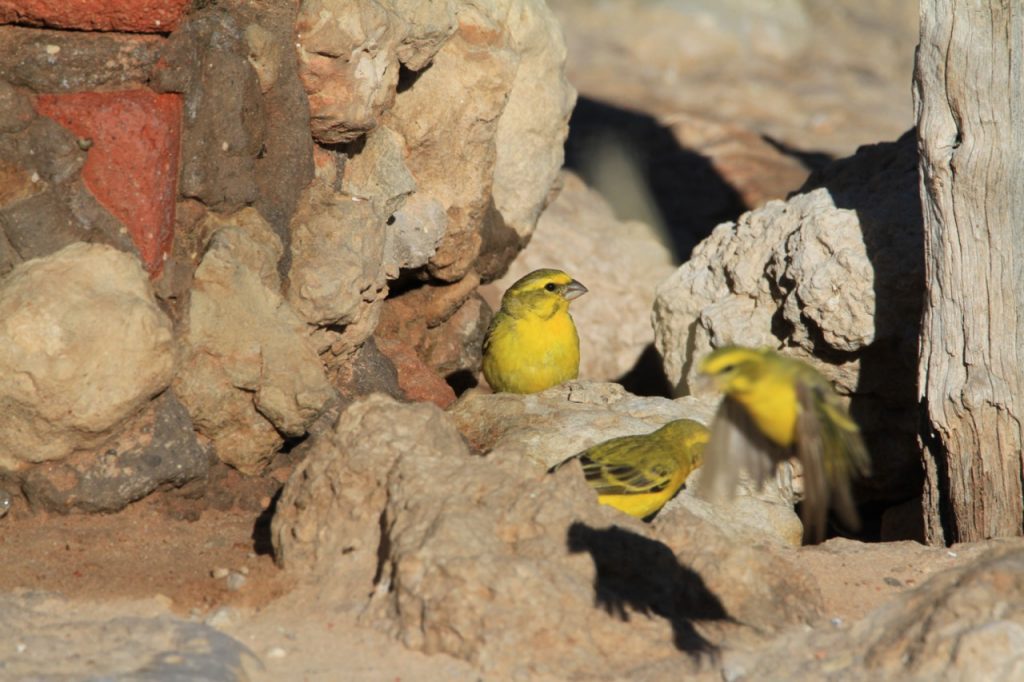
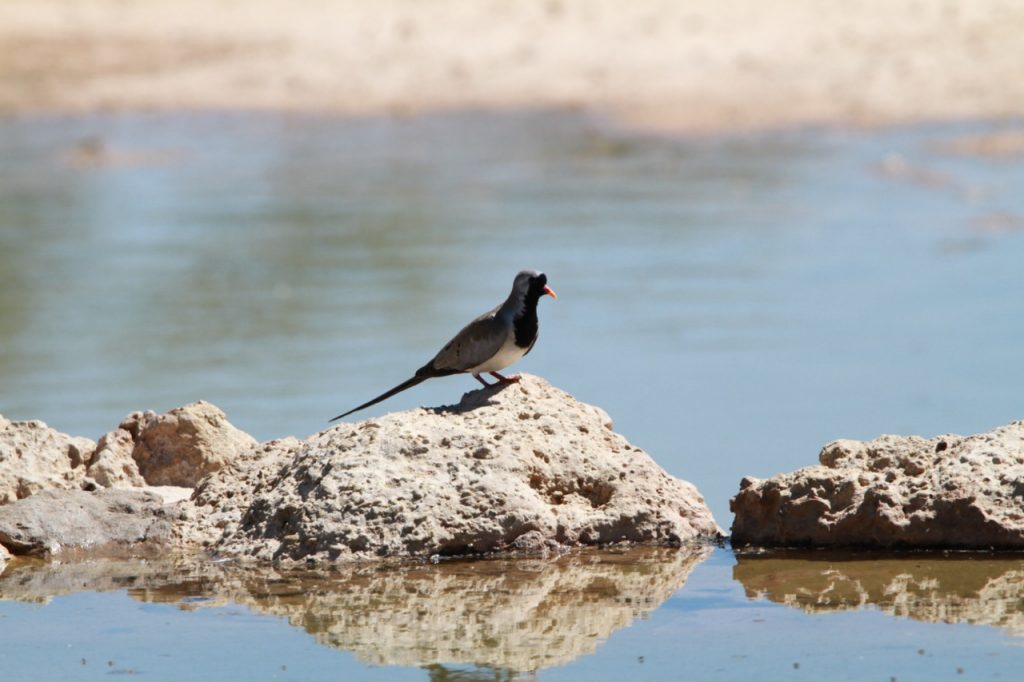
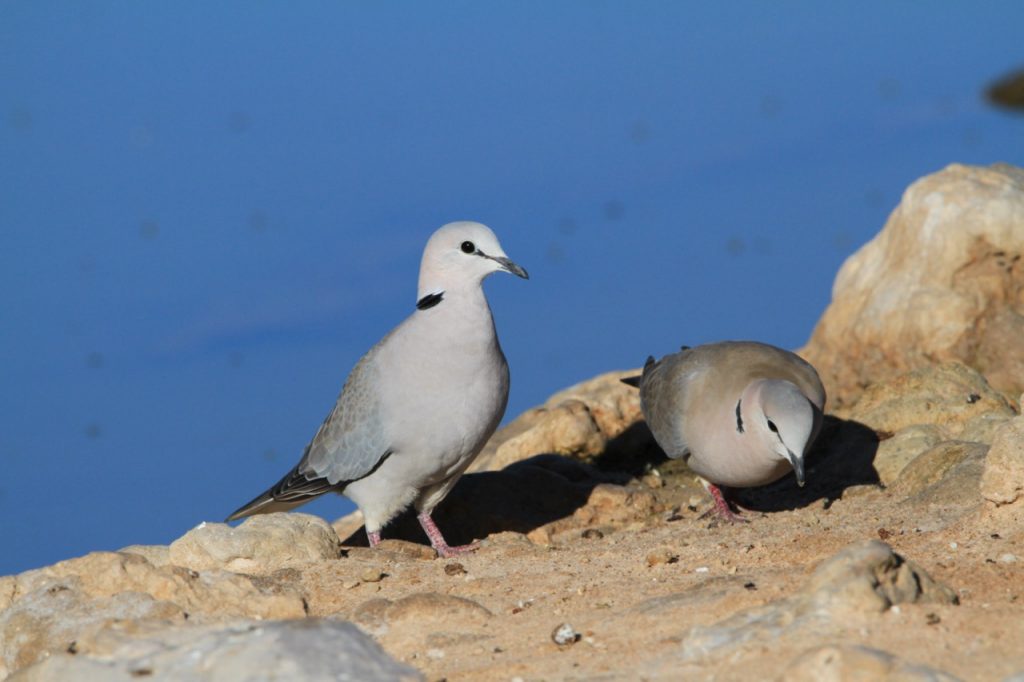
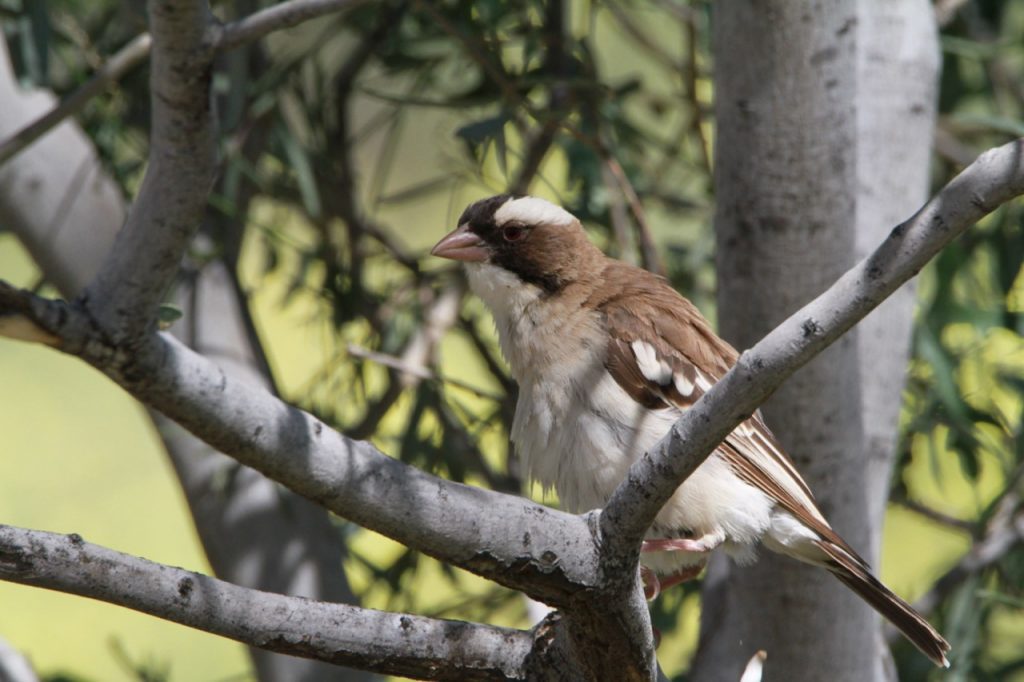
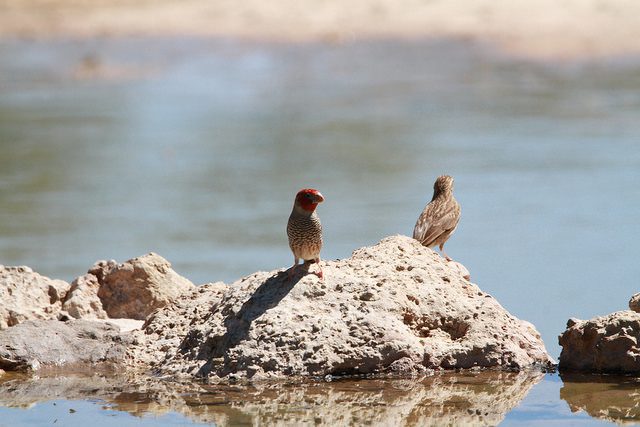
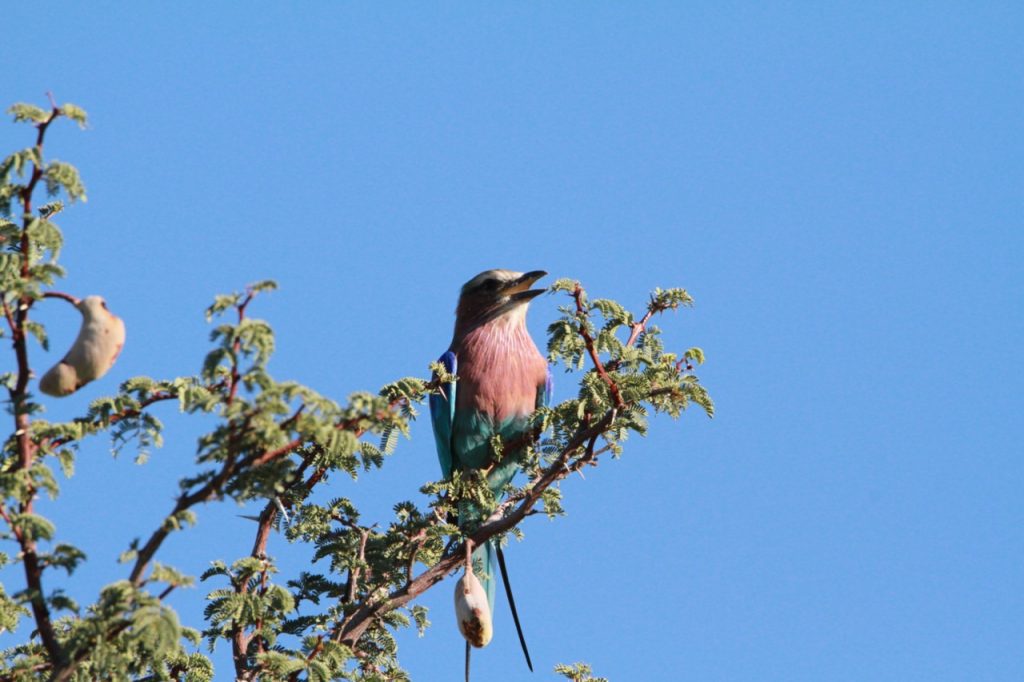
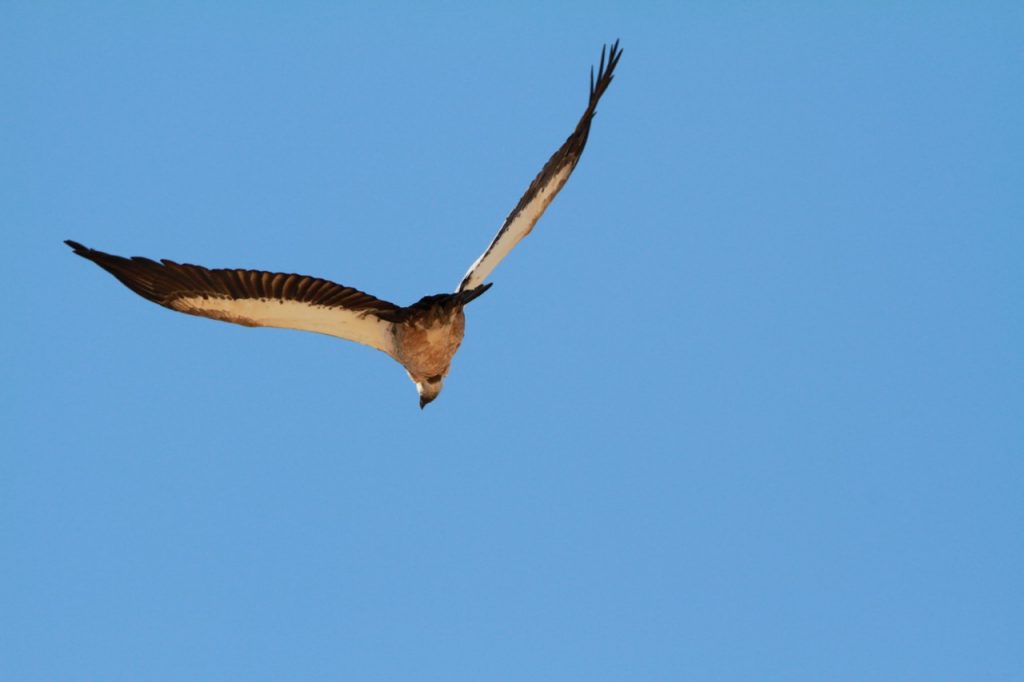
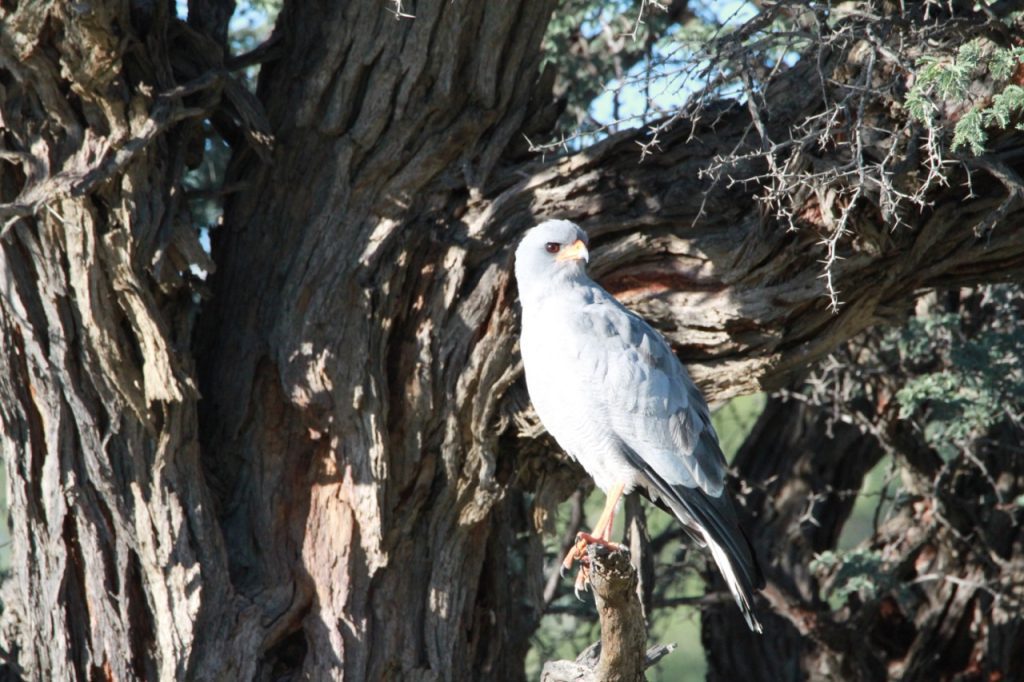
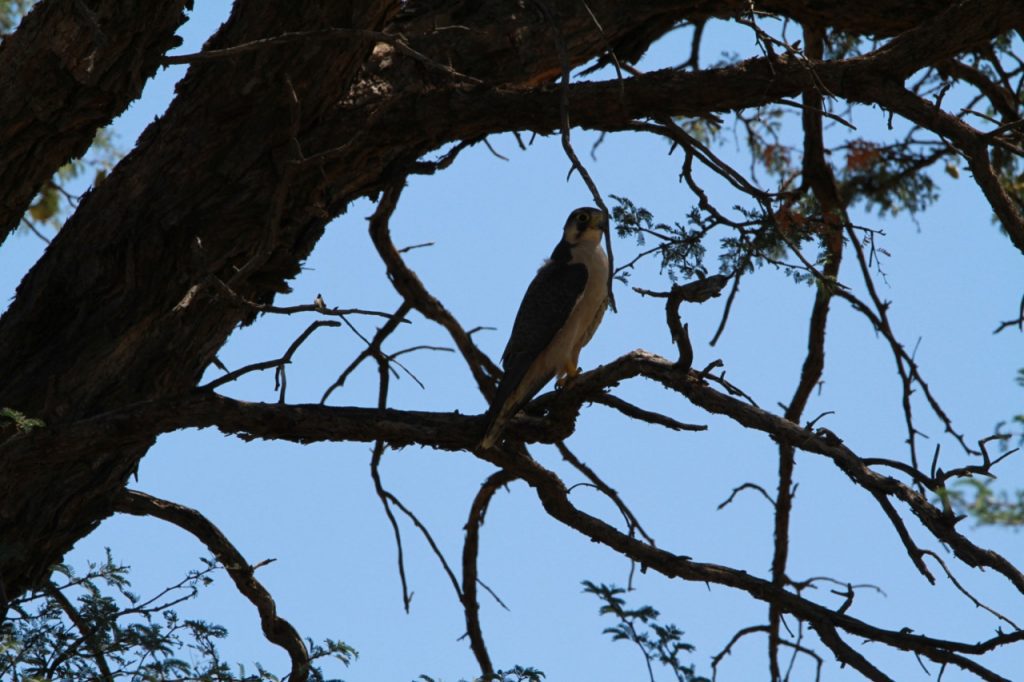
As we joined the main road turning right to Mata Mata we spotted 3 spotted hyena asleep in the sun. We stayed with them for a short while, but they were going nowhere fast and were out for the count!
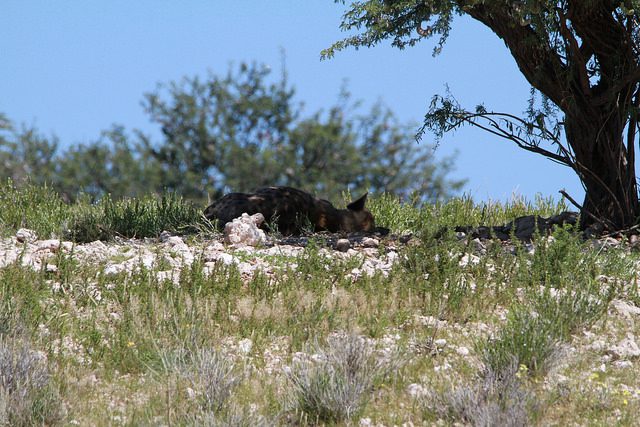
Six giraffes were gathered around 13th borehole. Theses giraffe have an interesting history: In September 1990, 8 giraffe were relocated from Etosha Pan to KTP and were kept in a boma at Mata Mata for eight years. In July 1998 they were released into the park and the population has now expanded to over 40.
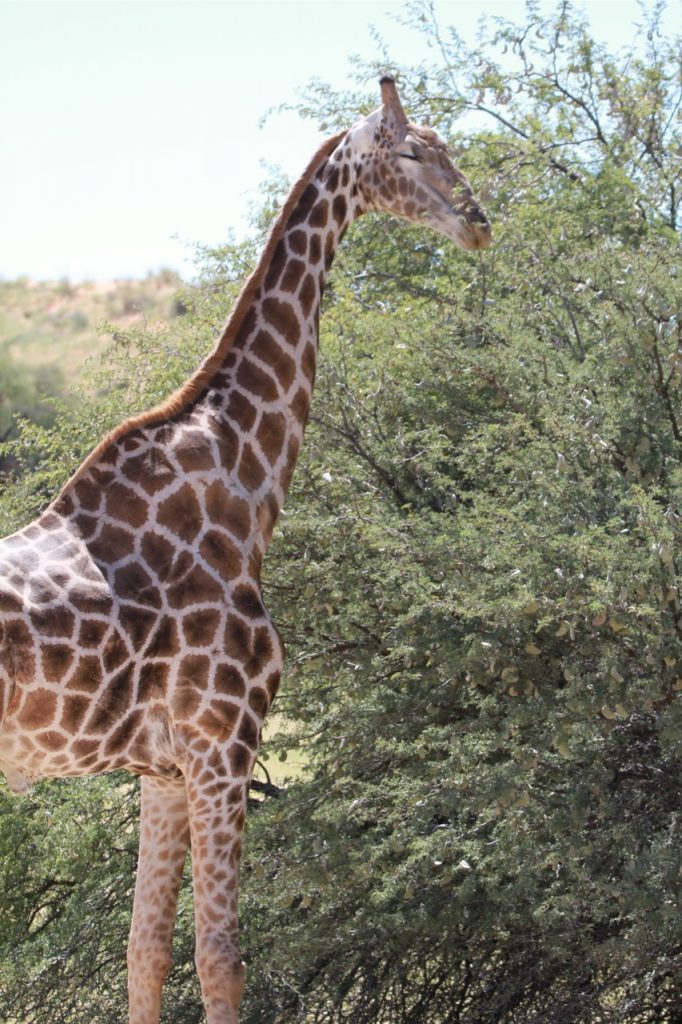
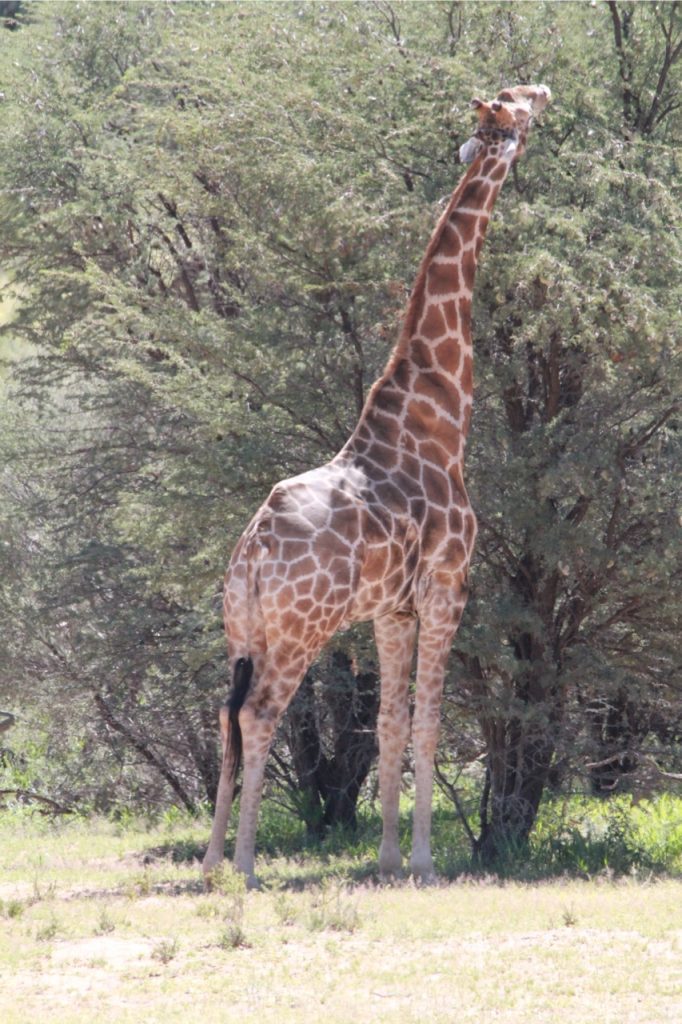
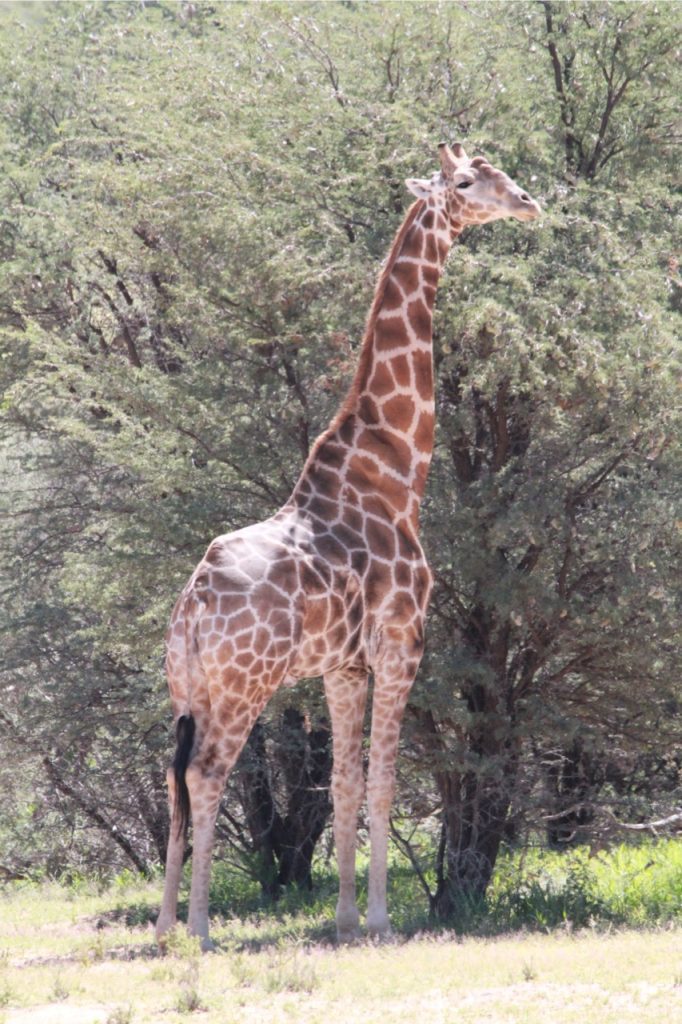
Love this pale chanting goshawk posing so nicely for us.
We saw a huge number of white backed vultures gathered together in the distance – too far to photograph – they looked as though they were all having a communal sleep. A field guide later told us about ‘anting’: a strange behaviour which, it is believed, removes parasites. More than 200 species of birds have been recorded displaying this behaviour. Passive anting is when the birds finds an ant nest, and then lies down on the nest sand, allowing the ants to crawl onto its feathers. After a sufficient number of ants climb onto the bird, it will shake its feathers causing the ants to secrete formic acid – this relaxes the birds. Once the ants have discharged their acid and their work is done, the birds may eat them. It is possible that the acid may also act as an insecticide or fungicide, but there is no real scientific evidence of this. One was coming into landing to join the others.
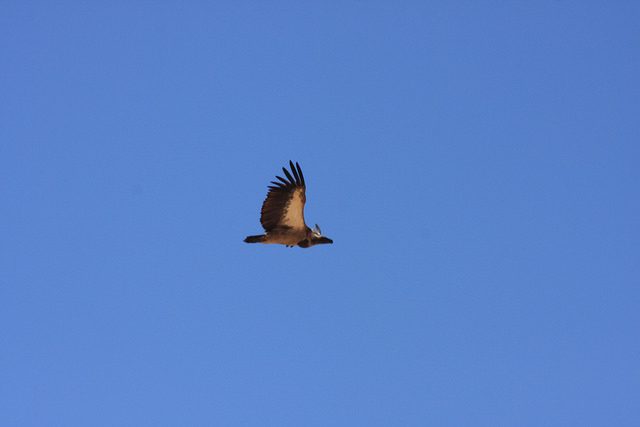
We were looking forward to arriving at Mata Mata and having a swim as it was really hot. We had one more surprise before we headed into camp. This pair of secretary birds posed beautifully for us!
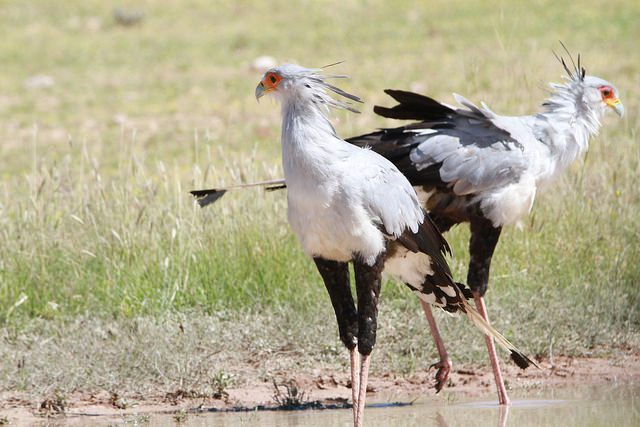
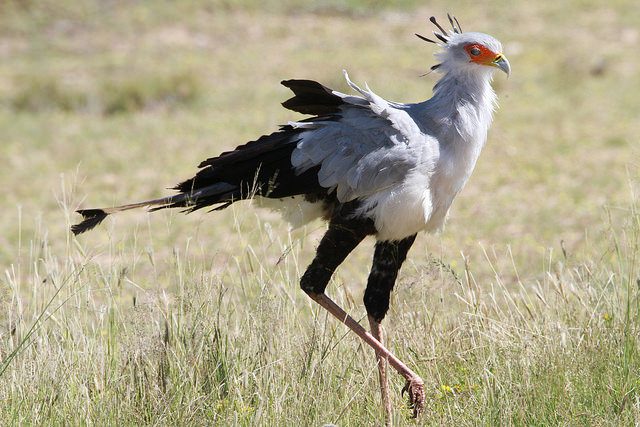
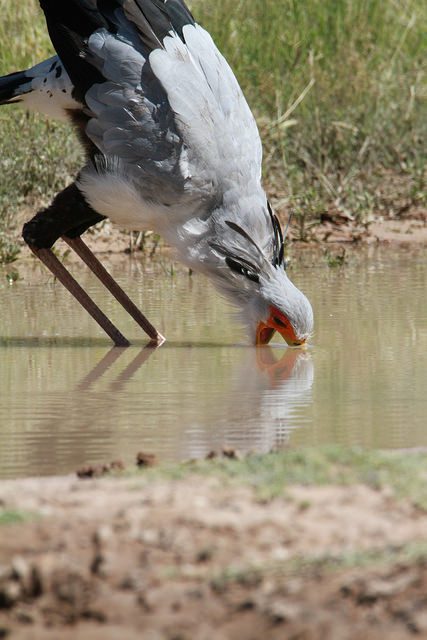
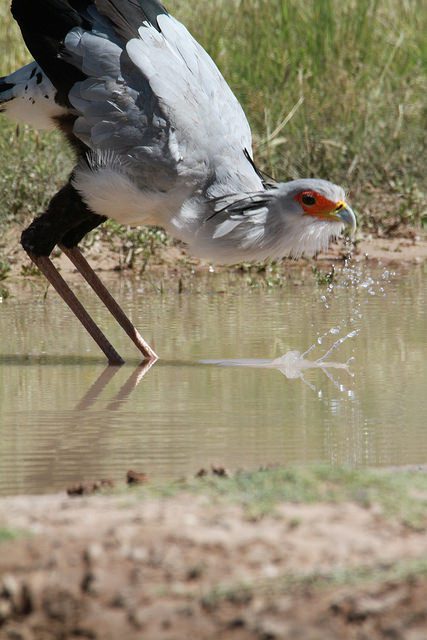
Arrived at Mata Mata and stocked up on water etc. Lay by pool until 5.30pm – very relaxing and met some lovely people from CT. Arrived at Mata Mata and stocked up on water etc. Lay by pool until 5.30pm – very relaxing and met some lovely people from CT.
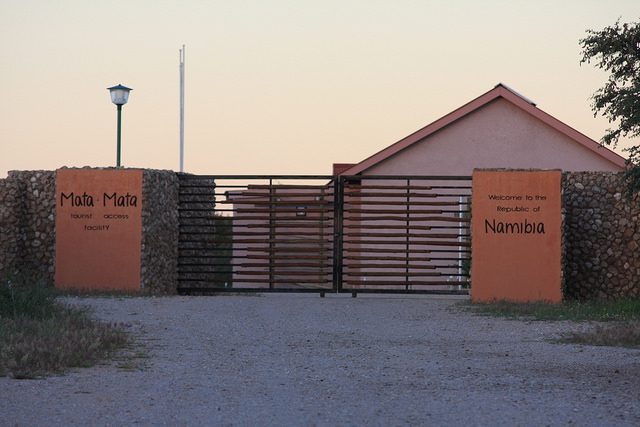
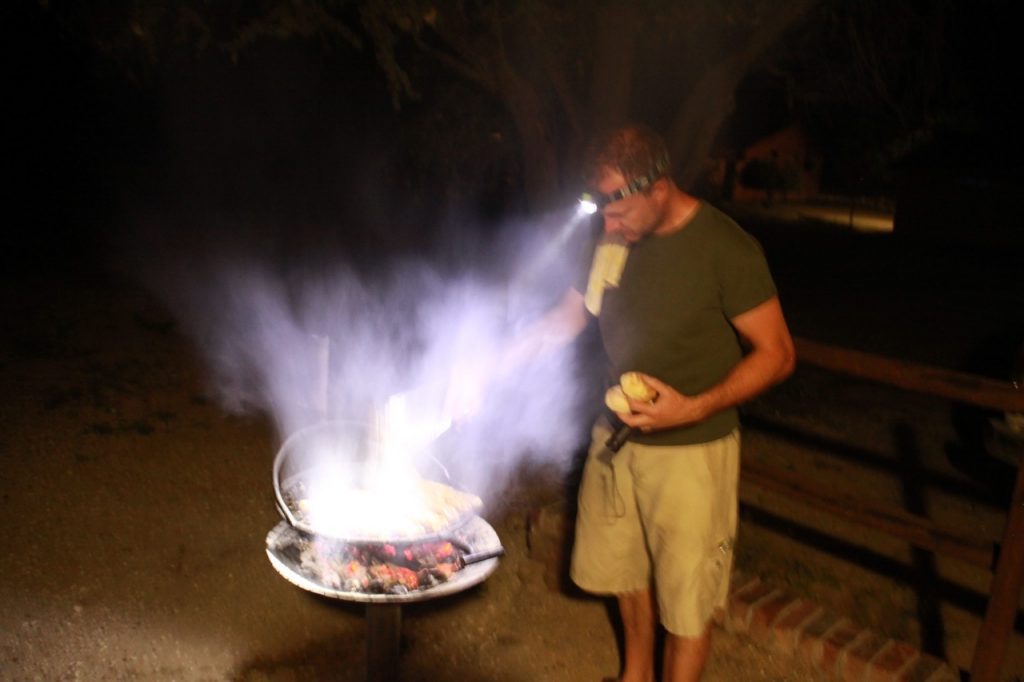
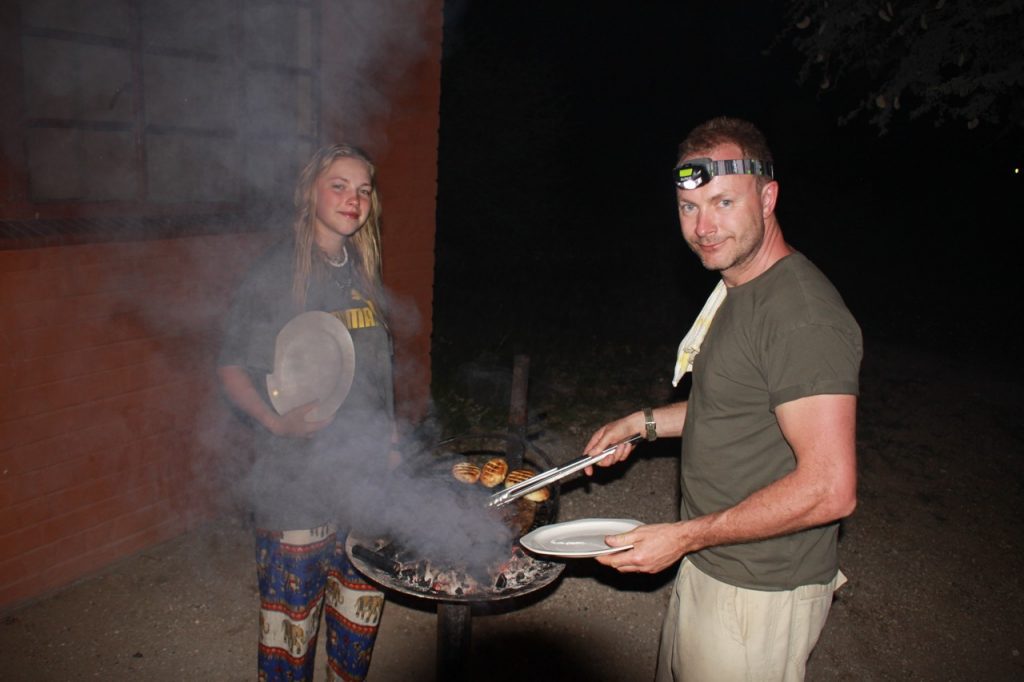
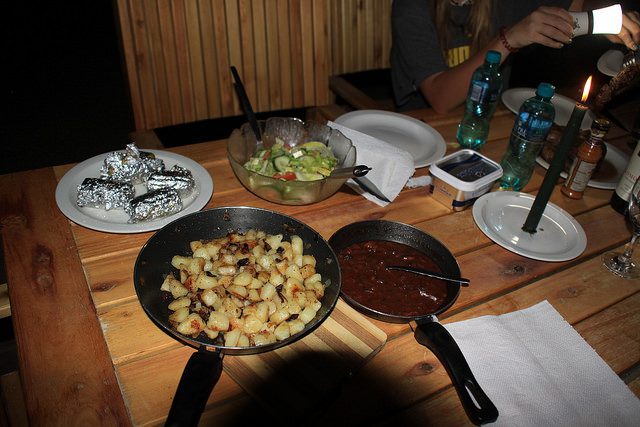
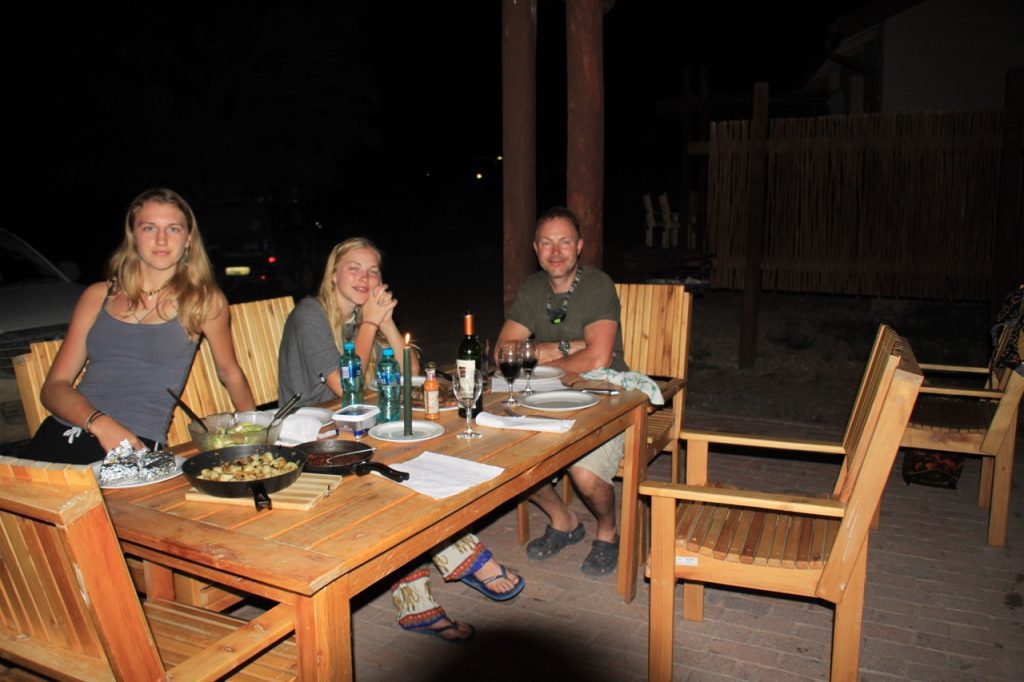
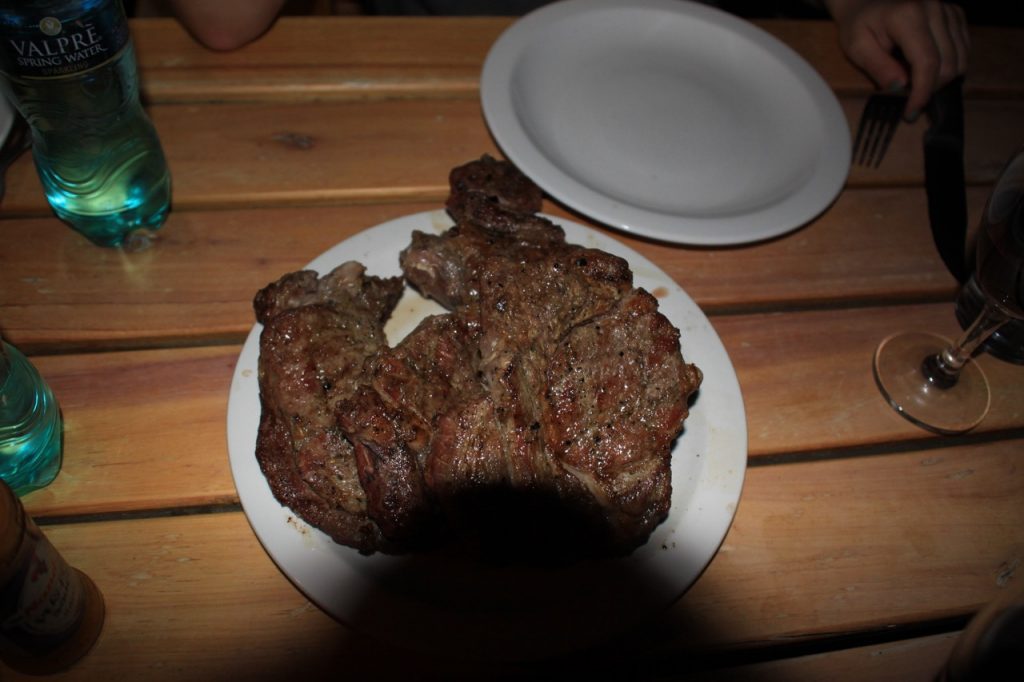
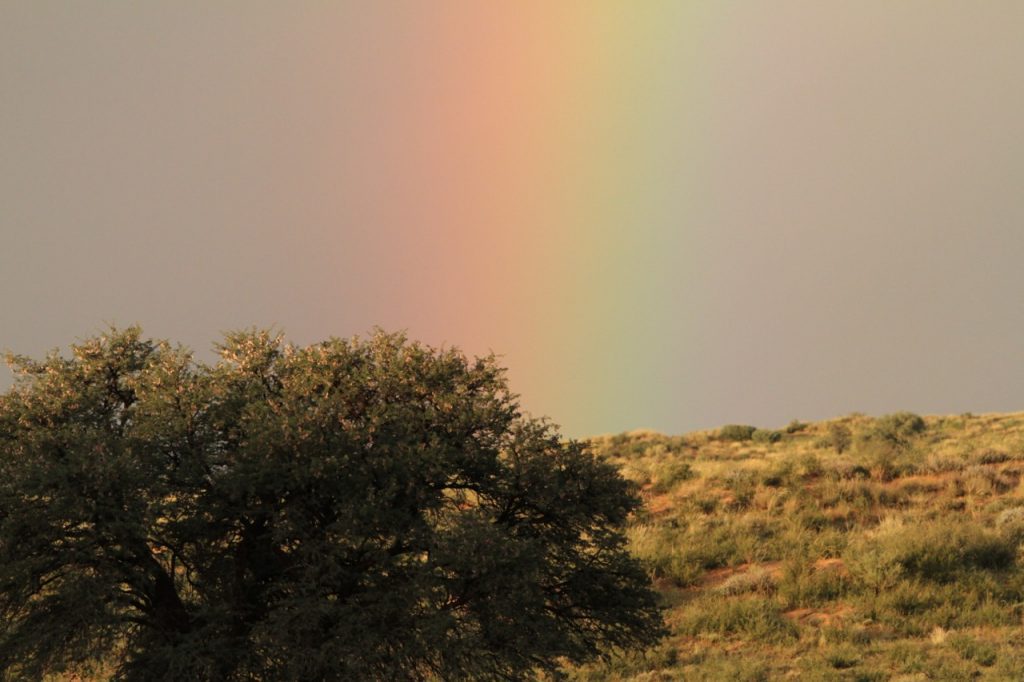
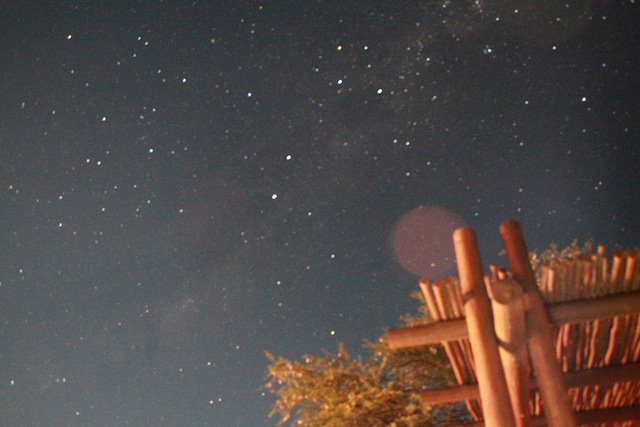
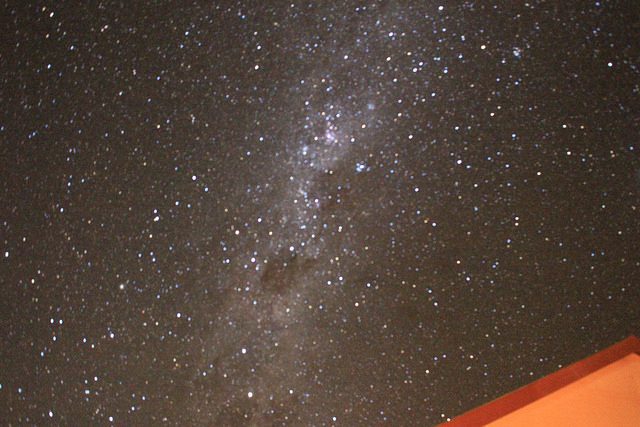
Charlotte took more photos of the night sky… milky way so impressive. It just gets better and brighter every evening! Another perfect end to a another perfect day in Africa.
DAY 6: Tuesday 29 March 2016 – Mata Mata to Kieliekrankie
Out gate at 6.30am. A friendly chap stopped us and told us that two cheetahs had been spotted in the area a few minutes before but that they had headed over the dunes … we drove slowly and hopefully scanning the dunes carefully but were instead rewarded with a different sighting!
YES! African wildcat in a tree – another one on our wishlist! He was so chilled watching us from his safe space.
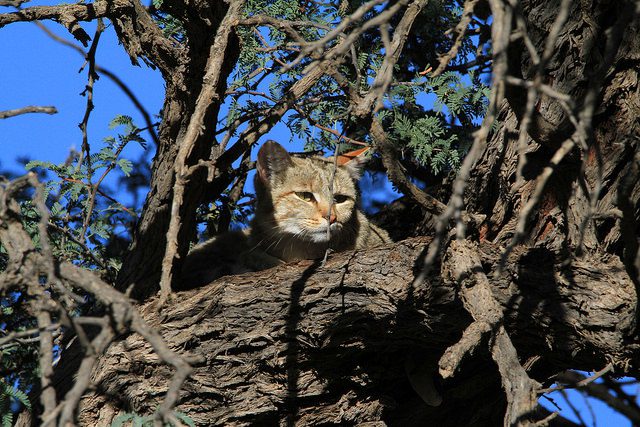
Not far from him a regal martial eagle had caught his breakfast – we waited a while to see whether he would start eating the lizard embedded in his large talons, but he was more interested in people watching than eating so we moved on…
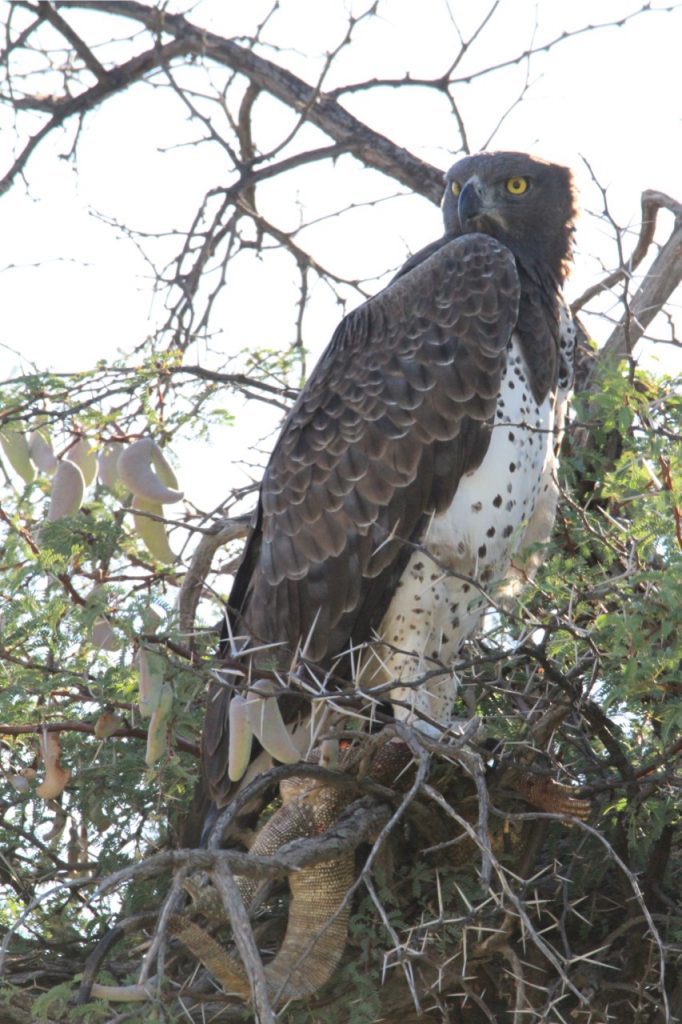
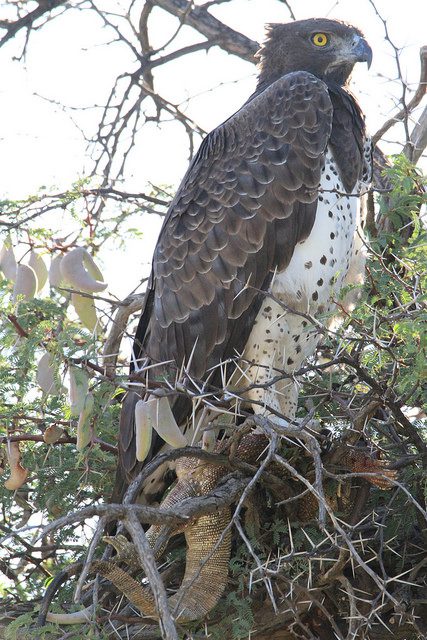
We saw 13 giraffe together – 2 males having a neck banging competition.
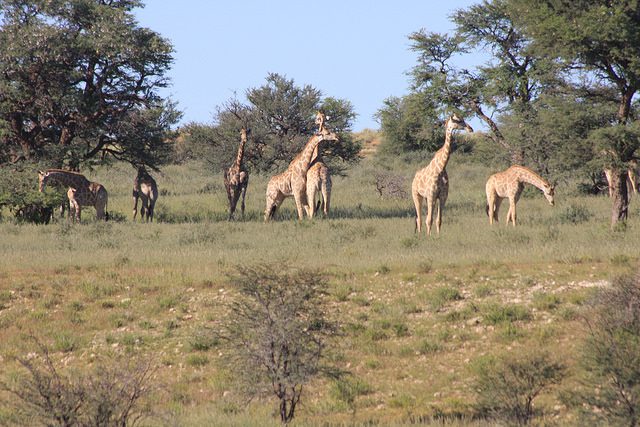
Then out of nowhere we saw a puff of feathers exploding in the sky and dropping down into the veld next to us – what was it?! A Lanner Falcon had taken a pale chanting goshawk! Lanner falcons pluck their prey before they start to feed…
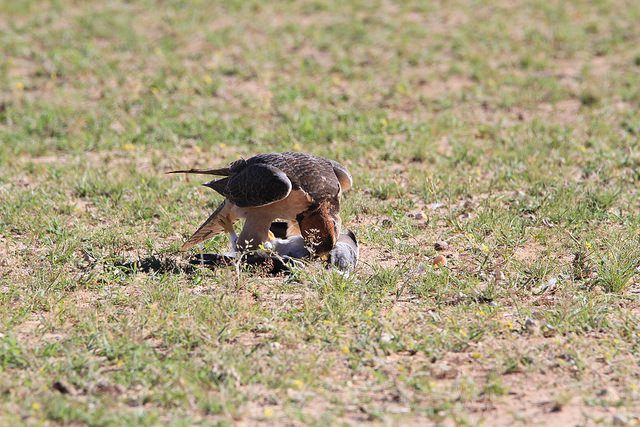
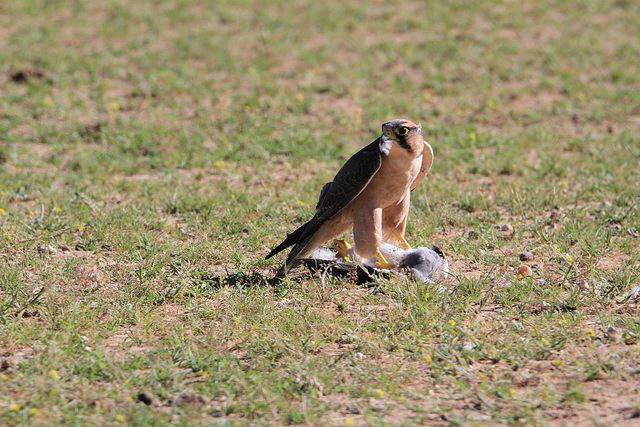
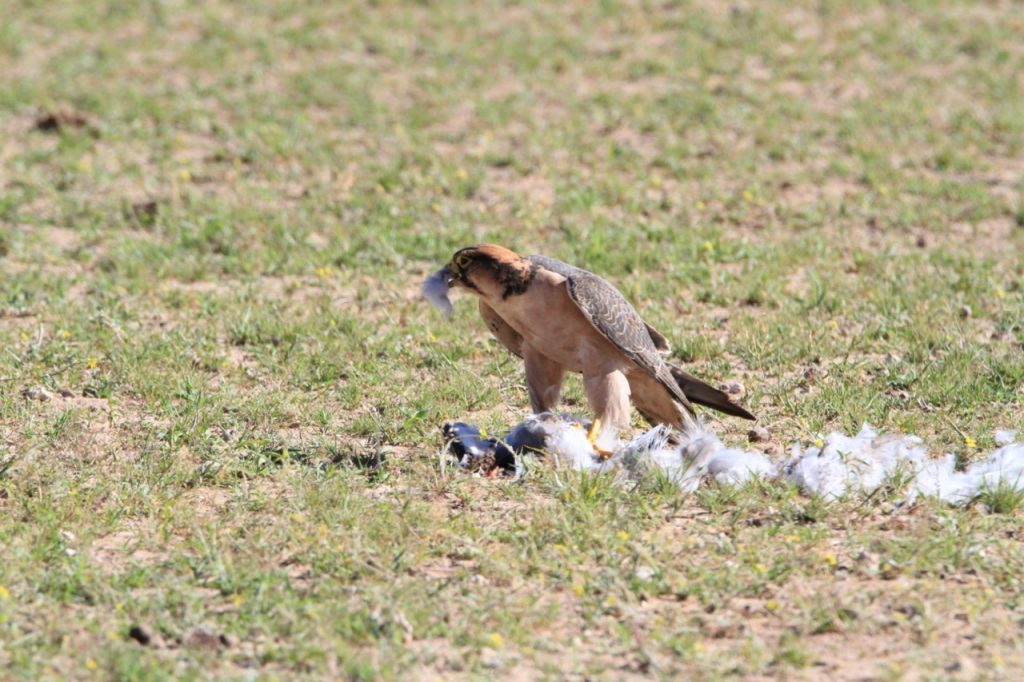
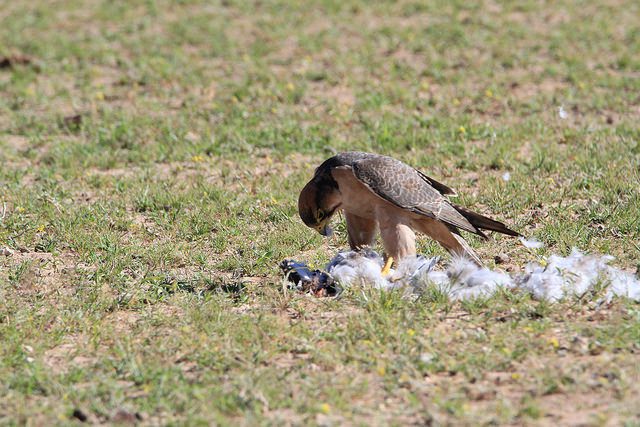
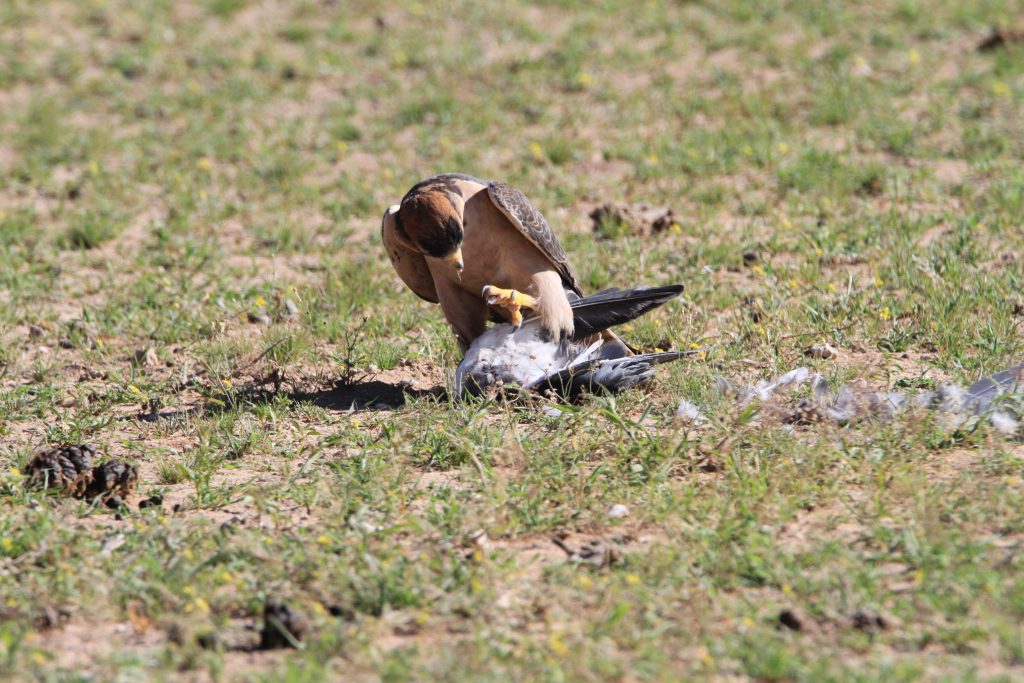
What an awesome morning! As we approached the Kamqua picnic spot we kept a lookout for the spotted hyenas – and there they were resting under the same tree!
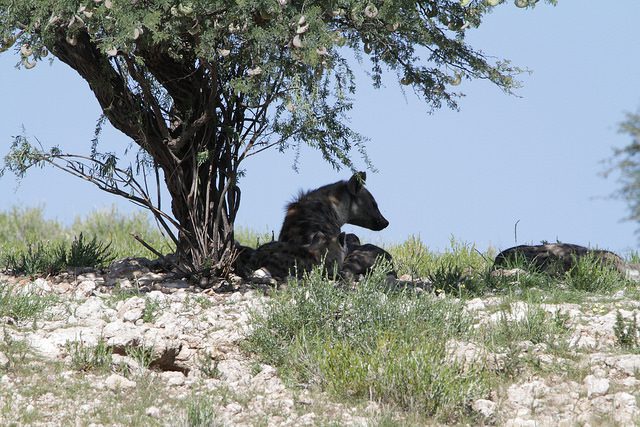
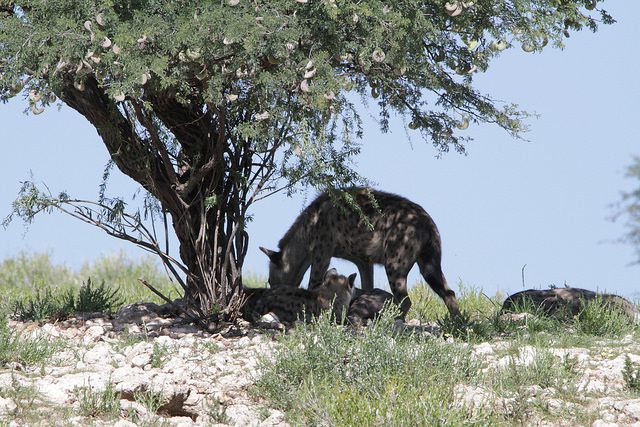
We headed to Kieliekrankie – WOW! What an amazing gem of the Kgalagadi – Jacques was very welcoming – this is one place that we will definitely revisit – I have no words so I will let the photographs do the talking! Our first view as we came over the hill.
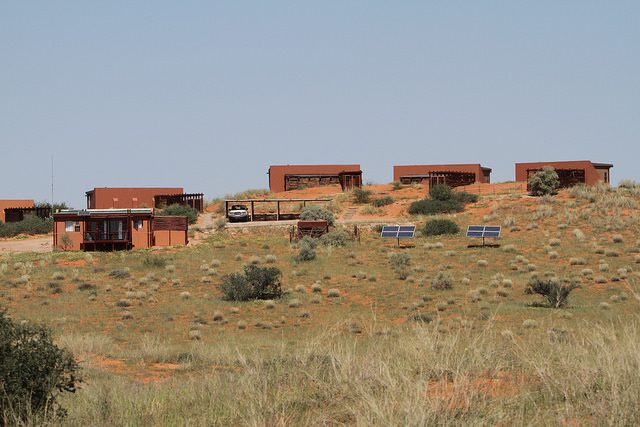
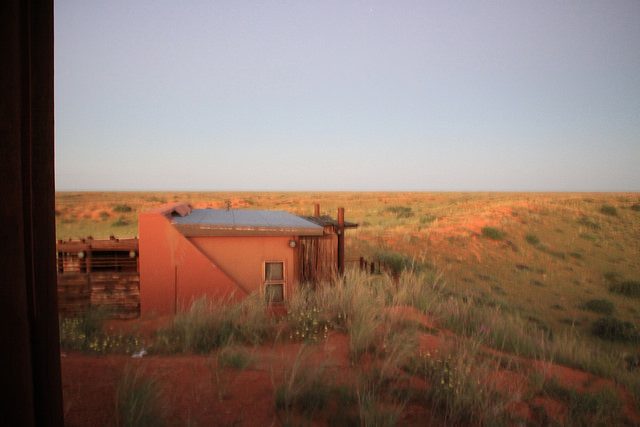
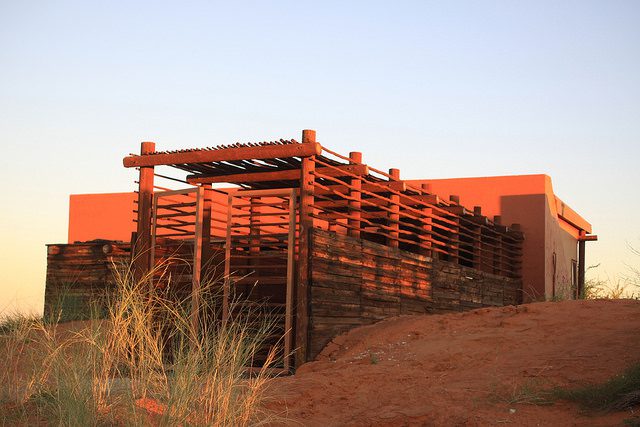
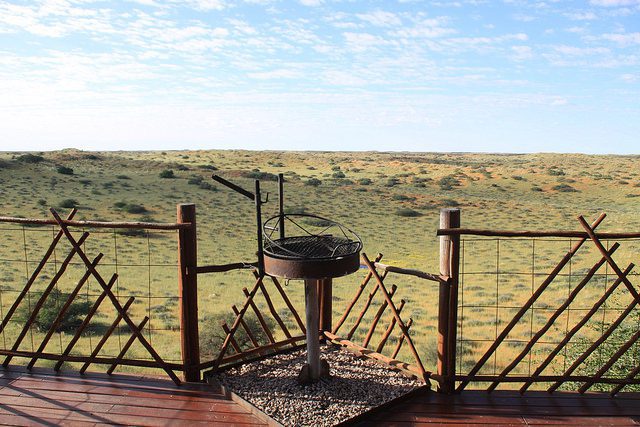
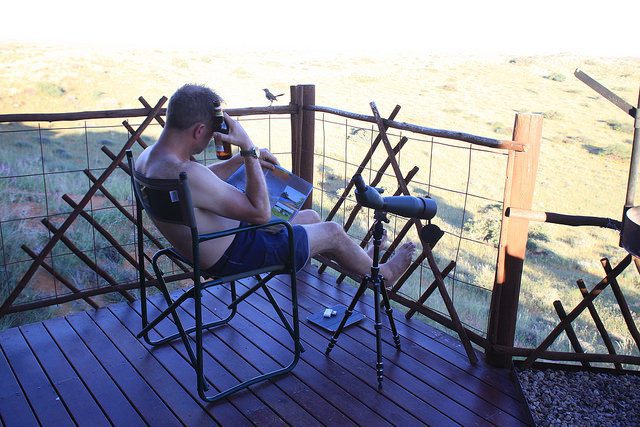
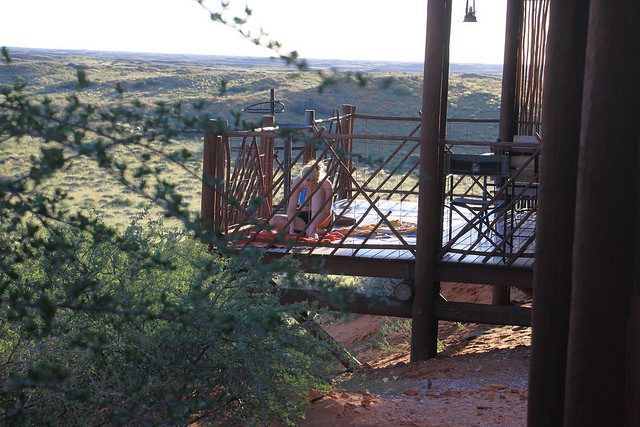
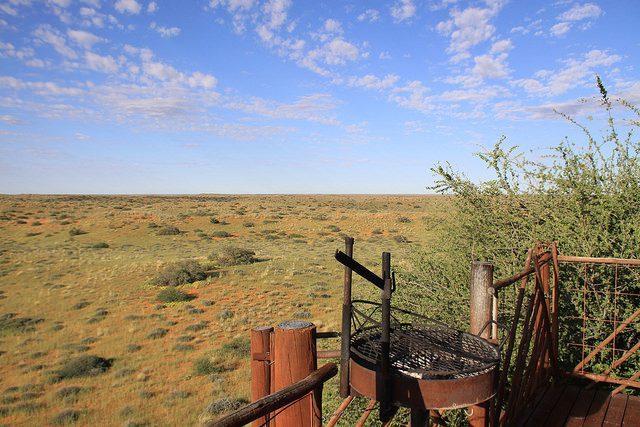
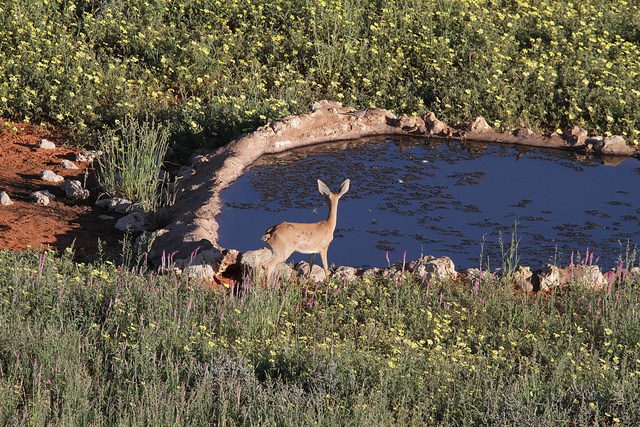
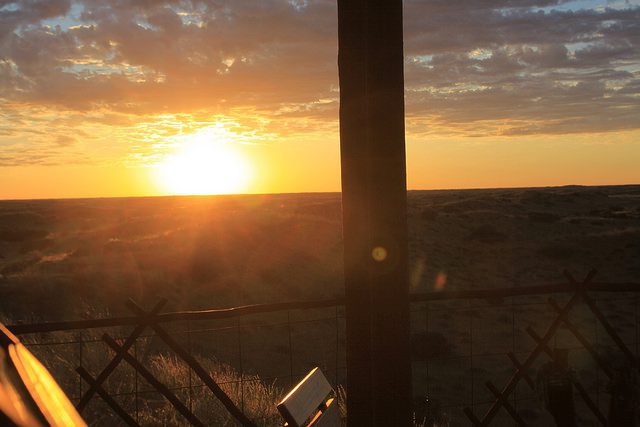
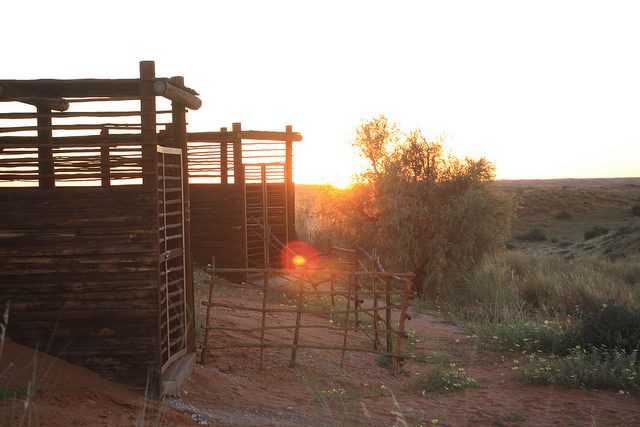
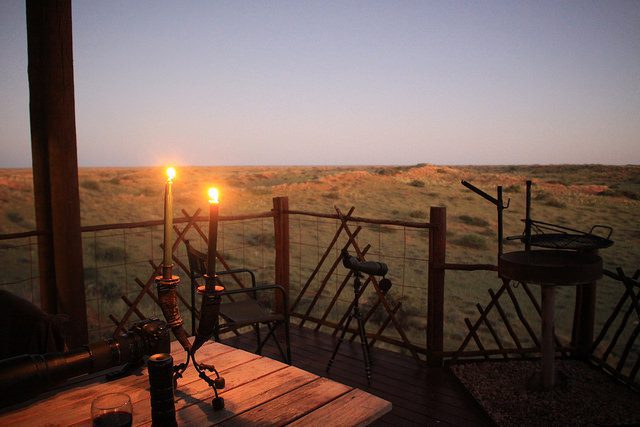
Caitlyn had a terrible night because a bat was trapped in their room. Charlotte wrapped herself up in her blanket and slept through the whole ordeal but Caitlyn could hear it all night and it kept flying into her – poor girl! Dinner was steak and dauphinoise potatoes followed by custard and accompanied by a full bodied red…an early night in paradise….
DAY 7: Wednesday 30 March 2016 –Kieliekrankie to Twee Rivieren to Upington to Jhb
Up at sunrise – simply stunning colours – wish we could stay longer at Kieliekrankie as it is so beautiful. After a delicious breakfast on the balcony we set off feeling a little sad as this was our last morning in KTP.
Some lovely sightings of hartebeest babies.
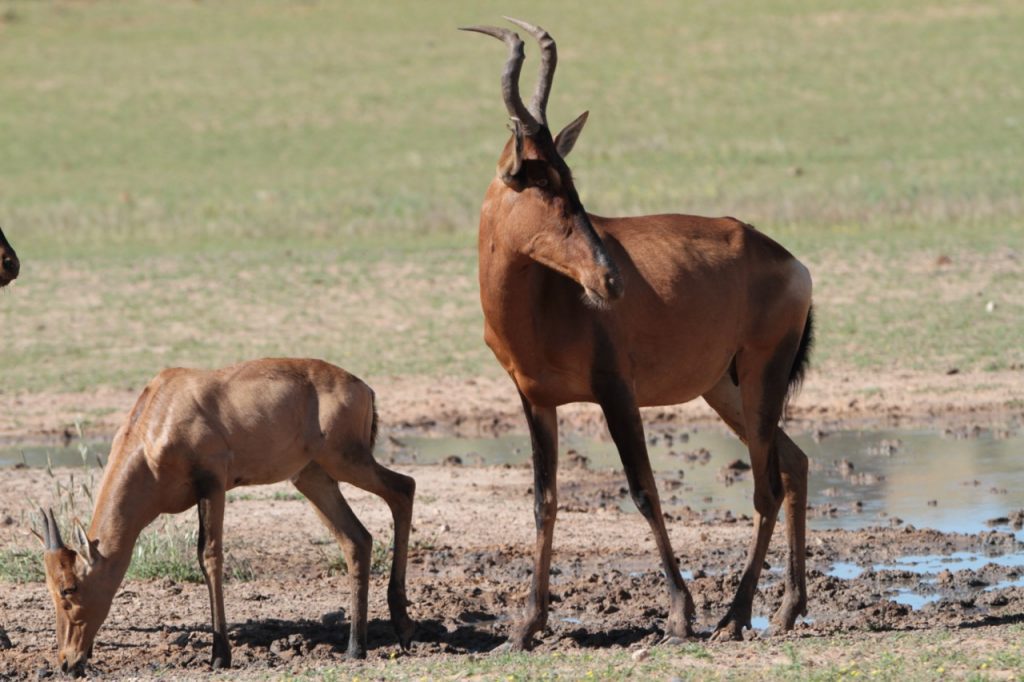
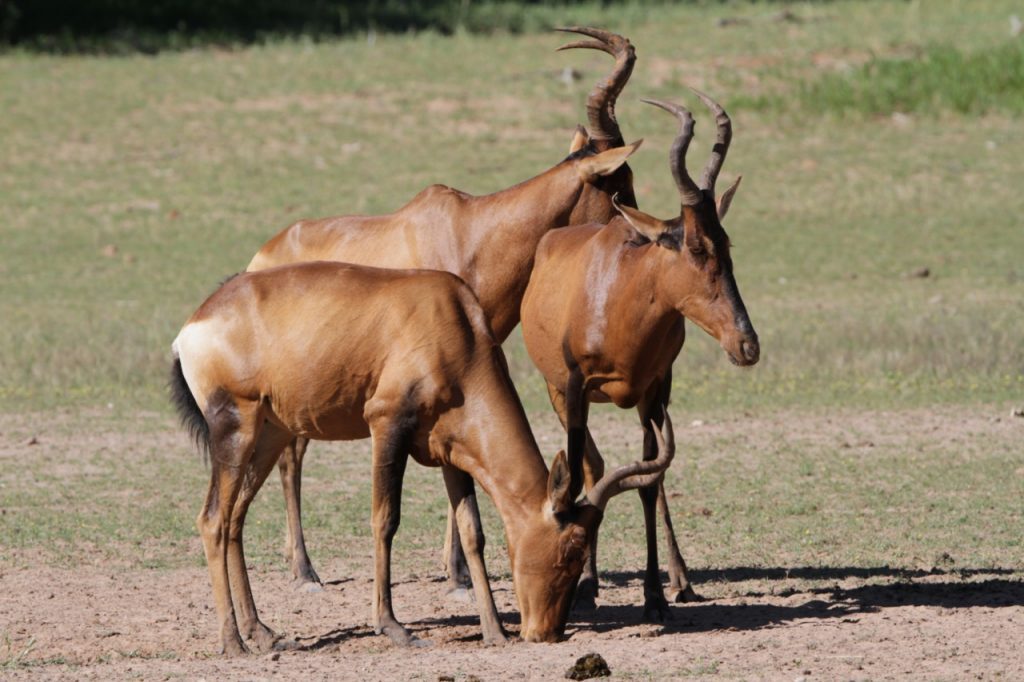
After turning onto the main road we spotted this little new born. Umbilical cord still visible as was the placenta on Mother … He was introduced to the herd – it was very special watching all the other wildebeest coming to greet him .. It is incredible how quickly they are up and running! Mommy helping to cross the road – just adorable! Unfortunately we had to make a move so that we did not miss our flight in Upington – we could have watched him for hours!
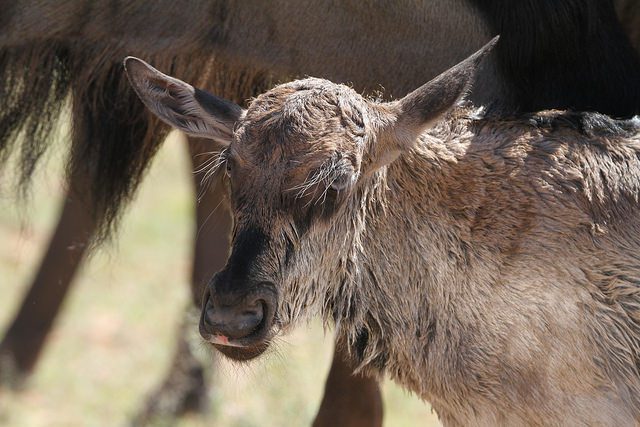
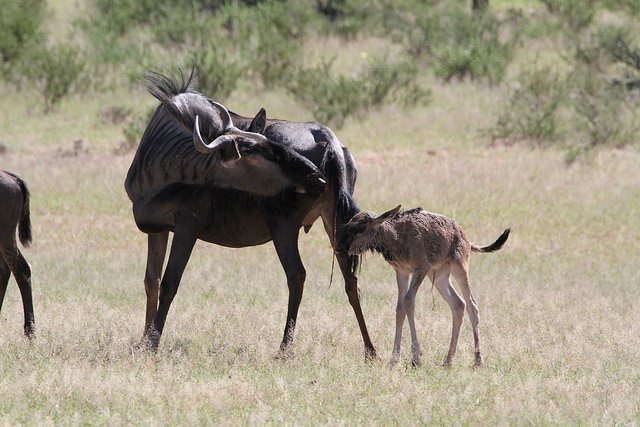
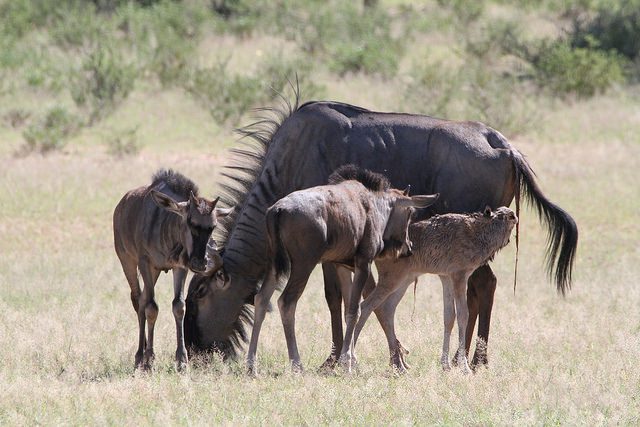
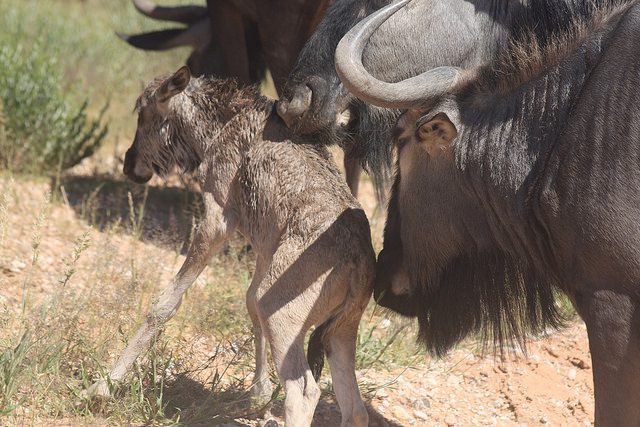
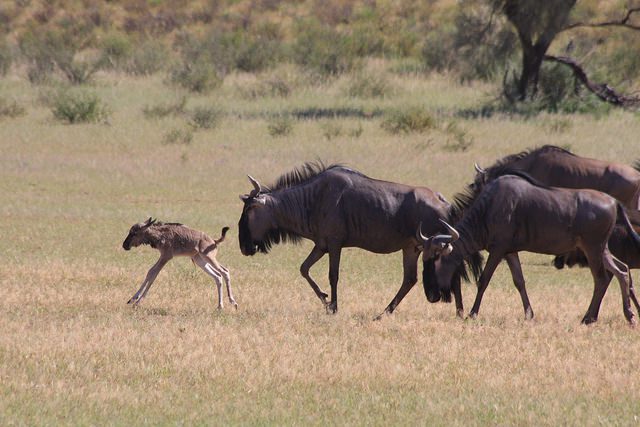
As always, when you are in a hurry to leave, the bush always provides another special surprise! But we had to push on so we took a final photo of this handsome boy resting in the shade just north of Kumqua picnic spot – wish we could have parked up and stayed a while…
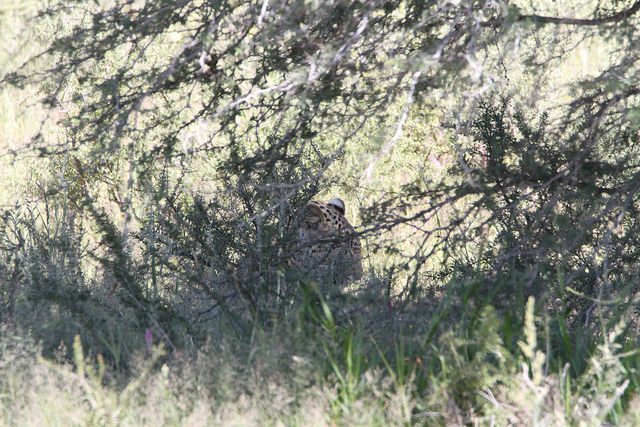
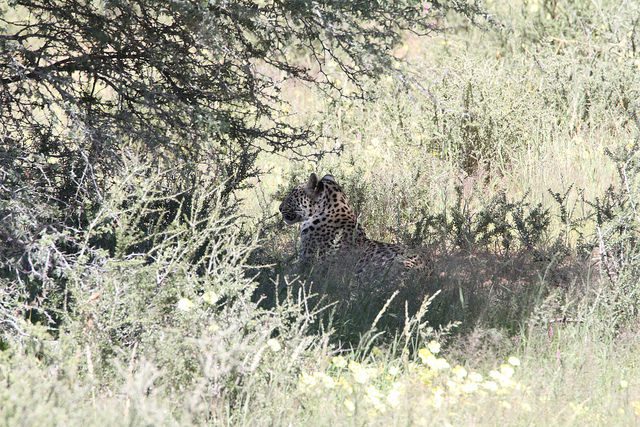
So, with heavy hearts this brings us to the end of our first visit to KTP – that red sand has indeed bitten deep – we are addicted and we WILL be back (trip already booked for October!!). On a positive note, we were very excited as we had one night in Jhb before meeting our son and friends at the airport in the morning and then flying to Hoedspruit for the next part of our trip: 8 nights North to South in Kruger!!

